Australian
and international
exploratory
performance and
media arts
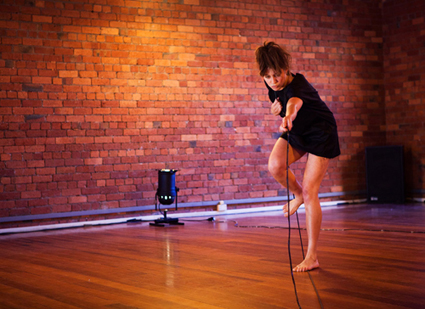
Natalie Abbot, Lucy Guerin Studio Residencies & Workshops
Workshops & Residencies, Lucy Guerin Inc
Applications are open for the 2014 studio residency program at Lucy Guerin Inc. These residencies provide studio/rehearsal space free of charge for the development of new work. Places are also available in their next Hotbed professional development workshop titled Defining Practice, presented by US/Belgian-based choreographer Eleanor Bauer (Nov 25).
Applications for studio residencies & workshop places due 23 Sept; http://www.lucyguerininc.com/studio-projects/Studio_Residency; http://www.lucyguerininc.com/studio-projects/Hotbed
Indigenous Production Scholarship, Metro Screen
Scholarships are now available for 15 Indigenous people looking to work across film producing and production management. The course starting September 13 results in a Certificate IV in Screen & Media (Partial Qualification). Metro Screen also offers free access for Indigenous filmmakers to a number of their other short courses.
Applications for Production Scholarship 2 Sept; http://metroscreen.org.au/funding/indigenous-support/
Critical Path Responsive Residencies
For 2014 Critical Path is dividing its Responsive Residencies for NSW-based choreographers into Tasters/Testers, for processes trying out new ideas (up to $10,000); and Investigate/Extend for longer-term research projects (up to $20,000). They also offer research room residencies to NSW, national and international artists (non-financial) providing artists with office and research space, including access to video editing equipment, for up to three months.
Deadline for Responsive Residencies 9 Sept; Research Room residencies no deadline, subject to availability; http://www.criticalpath.org.au/documents/2014_ResponsiveProgram_GuidelinesforApplying.pdf
Bivouac 2013
Bivouac is a video exhibition with an emphasis on multichannel pieces that are not so much site-specific as site responsive. Ten works will be chosen to be exhibited at a yet to be disclosed public site in Melbourne in October/November. Preferred format is three-channel works two to nine minutes long.
Deadline 2 Sept; http://blog.cofa.unsw.edu.au/wp-content/uploads/2013/08/Attachment-Bivouac-2013-CALL-OUT.pdf
Next Generation Placement, ASSITEJ
The International Association of Theatre for Children & Young People (ASSITEJ) is calling for organisations to register for their Next Generation Placement program. This offers young artists opportunities to experience temporary secondments in a range of companies across the world. Artists under 35 may apply for placements via the ASSITEJ site with successful applicants eligible to apply for financial assistance.
Deadline for placement offers 30 Aug; deadline for applicants 30 Sept; http://www.assitej-international.org/next-generation/
Forever Now
The Forever Now team of Willoh S Weiland, Brian Ritchie, Jeff Khan, Thea Baumann and Susan Cohn are calling for content to include on the three gold discs that they intend to send into space. In one minute of sound or video you are invited to contemplate infinity and an audience a billion light years away.
Applications open until June 2015; http://forevernow.me/
Blue Mountains Film Festival
Last week to submit entries to the Blue Mountains Film Festival for a chance to win a Yowie and the $5000 grand prize. Categories for short film entries are Animation, Drama, Documentary, Comedy, Open, Music Video and Family. Feature films will also be considered. The film festival is Oct 3-7 at Scenic World.
Entries due 2 Sept; http://www.bluemountainsfilmfestival.com/enter.htm
Selected Australia Council Grants
for full list see http://www.australiacouncil.gov.au/grants
Aboriginal and Torres Strait Islander Curator Exchange Program – 2 September 2013
http://www.australiacouncil.gov.au/grants/2013/Aboriginal-and-Torres-Strait-Islander-Curator-Exchange-program
Community Partnerships: Projects – 6 September 2013
http://www.australiacouncil.gov.au/grants/2013/community-partnerships-projects-6-september
Community Partnerships: Cité Residency – 6 September 2013
http://www.australiacouncil.gov.au/grants/2013/community-partnerships-cite-residency
Community Partnerships: Career Pathways – Structured Mentorships – 6 September 2013
http://www.australiacouncil.gov.au/grants/2013/career-pathways-structured-mentorships-community-partnerships-6-september
Community Partnerships: Projects with Public Outcomes – 6 September 2013
http://www.australiacouncil.gov.au/grants/2013/community-partnerships-projects-with-public-outcomes-6-september
Festivals Australia – 6 September 2013
http://www.australiacouncil.gov.au/grants/2013/festivals-australia-6-september
JUMP Mentoring – 9 September 2013
http://www.australiacouncil.gov.au/grants/2013/jump
RealTime issue #116 Aug-Sept 2013 pg. web
© RealTime ; for permission to reproduce apply to realtime@realtimearts.net
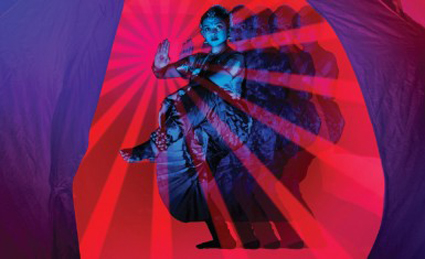
Private Dances, Nat Cursio Co.
photo Jorge de Araujo
Private Dances, Nat Cursio Co.
Private Dances, Northcote Town Hall
Nat Cursio is on a roll—Blizzard just premiered at Melbourne’s newest art centre, the Substation (see preview—review will appear next week) and now she is reprising Private Dances, a work created for Next Wave 2010 (see RT98 online). The Northcote Town Hall will become a tent city with dances performed to intimate audiences. Some tents will also screen dance-based films and there’s even rumour of action in the back seat of a car.
Darebin Speakeasy presents Nat Cursio Co. and Insite Arts’ Private Dances, 28-31 Aug, Northcote Town Hall; http://darebinarts.com.au/speakeasy/
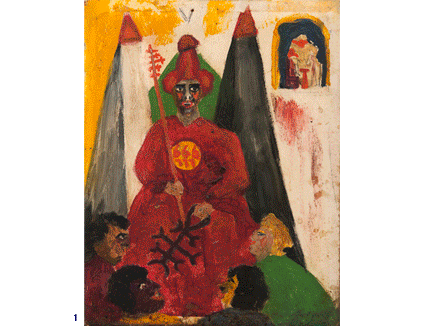
1. Aleister Crowley, The Hierophant (study for Tarot), 1921; 2. James Gleeson, A Moment in the Process, (detail), 2006; 3. Rosaleen Norton, Lucifer and the Goat of Mendes; 4. Danie Mellor, A Trace of History (of Death and Resurrection), 2010
Windows to the Sacred, S.H. Ervin Gallery
Coming up at S.H. Ervin Gallery is a fascinating survey of the “esoteric” in art—a field of practice defined by curator Robert Buratti as “man’s search for hidden knowledge of himself and his place in the universe” (press release). Windows to the Sacred places the work of renowned occultist Aleister Crowley alongside significant Australian artists such as “the father of Surrealism in Australia” James Gleeson, “the Witch of Kings Cross” Rosalee Norton and award-winning Indigenous artist Danie Mellor. It also incorporates moving image and music, exhibiting works by Kenneth Anger, Harry Smith, Alex Proyas, Jeff Martin (lead singer of Canadian band The Tea Party) and audiovisual group Masonik. A Gnostic temple will also be constructed by Collective 777, an art guild of the Ordo Templi Orientis Australia, in which a mass will be conducted on Sept 17.
Windows to the Sacred, S.H. Ervin Gallery, presented in association with Buratti Fine Art; 30 Aug-29 Sept; http://www.shervingallery.com.au/
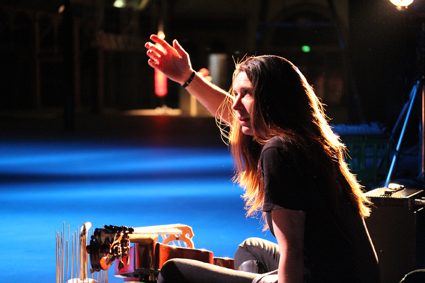
Anita Hustas, Festival of Slow Music
courtesy the artist
Anita Hustas, Festival of Slow Music
Festival of Slow Music
Taking inspiration from the slow food movement, musician and curator Adam Simmonds has started the Festival of Slow Music. He says, “It is not the music that will be slow, but the listening—the audience will be encouraged to slow down and enjoy the experience” (website). In a range of venues around Ballarat you can experience strictly acoustic music by artists such as new music duo Vanessa Tomlinson & Erik Griswold (Clocked Out); bassist/waterphonist Anita Hustas (best get along to see what that entails); renowned movement improviser Al Wunder exploring his own style of “hum-drumming;” and ukulele queen Rose Turtle Ertler. The event kicks off with a mass choral ‘OM,’ open to public participation, lead by Sweet Mona’s Choir.
Festival of Slow Music, Art Gallery of Ballarat & various venues, Ballarat, 30 Aug-1 Sept; http://www.festivalofslowmusic.com/
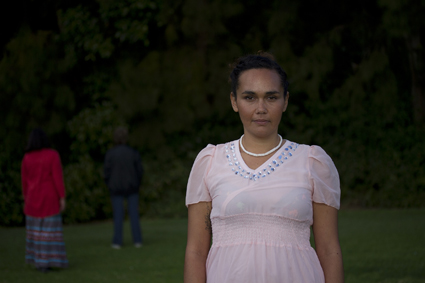
This Fella, My Memory, Moogahlin Performing Arts & Carriageworks
photo Gabriella Lo Presti
This Fella, My Memory, Moogahlin Performing Arts & Carriageworks
This Fella, My Memory, Carriageworks
Produced and devised by Moogahlin Performing Arts and Linden Wilkinson, This Fella, My Memory looks at the stories of three older women and their relationships with friends, family and country. Directed by Frederick Copperwaite and created in consultation with Aboriginal Elders Aunty Christine Blakeney and Uncle Max (Dulumunmun) Harrison, the work is “a road trip across Aboriginal NSW where the boundaries, kinships and songlines are invisible to the eye, but felt deep within” (website). After the vibrant history of the Black Theatre in the 1970s, this marks the first play to be devised and written from a company in Redfern in 40 years. The work has been created using a combination of western playmaking techniques and traditional cultural practices and Copperwaite feels that they’ve managed to “collectively imagine and share ownership of a story about the community in which we all live and work” (press release).
Moogahlin Performing Arts, This Fella, My Memory, Carriageworks, 4-7 Sept; http://www.carriageworks.com.au/
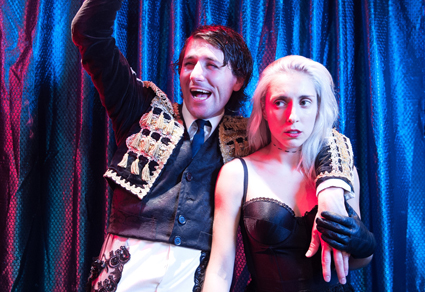
Salomé, Little Ones Theatre
photo Sarah Walker
Salomé, Little Ones Theatre
Salomé & City of Shadows, Helium, Malthouse
Malthouse’s Helium season of shows by independent artists and companies is drawing to a close with two quite contrasting pieces. Salomé, directed by Stephen Nicolas (see review of his sex.violence.blood.gore) takes the Oscar Wilde classic and gives it an 80s gender-bending makeover complete with New Wave soundtrack. Then Perth composer and chanteuse Rachael Dease goes noir with City of Shadows, a song cycle of murder, misfortune and forensics based on the highly evocative collection of crime scene photos housed at the Sydney Justice & Police Museum (material initially explored in a series of impressive multimedia works by Ross Gibson and Kate Richards).
Malthouse’s Helium: Little Ones Theatre, Salomé, 30 Aug-14 Sept; Smack! Bang, City of Shadows, Rachael Dease, 21 Sept-5 Oct; http://www.malthousetheatre.com.au/helium-2013/
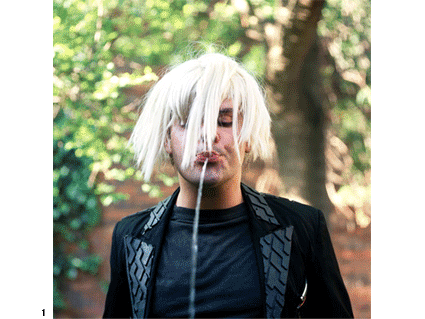
1. Christian Thompson, Andy; 2. Max Pam, Reporting Madagascar (excerpt); 3. Tom Nicholson, Indefinite distribution (After Dili action); 4. PUNKASILA, La Misión a Cuba del Rock Combativo. (See entry for full caption info)
In Confidence: Reorientations in Recent Art, PICA
Curated by John Mateer, In Confidence: Reorientations in Recent Art is an exhibition of artists described as “transnational,” exploring a “genuine, grass-roots style globalism” (website). Mateer sees this balancing act of the international and local as particularly “meaningful to the West Coast of Australia.” Artists from Australia and Southeast Asia include Simryn Gill, Tom Nicholson, Max Pam, Christian Thompson, Hossein Valamanesh and Indonesian punk band Punkasila.
(Caption: 1. Christian Thompson, Andy, from the series The Gates of Tambo, 2004. Courtesy the artist and Gabrielle Pizzi Gallery, Melbourne; 2. Max Pam, Reporting Madagascar (excerpt), 2003. Image courtesy the artist; 3. Tom Nicholson, Indefinite distribution (After Dili action), 1999-2010 (detail). Image courtesy the artist and Milani Gallery, Brisbane; 4. PUNKASILA, La Misión a Cuba del Rock Combativo, 2009. 10th Havana Biennial, Cuba. Courtesy of the artists and Darren Knight Gallery, Sydney.)
In Confidence: Reorientations in Recent Art, PICA, 31 Aug-13 Oct, http://www.pica.org.au
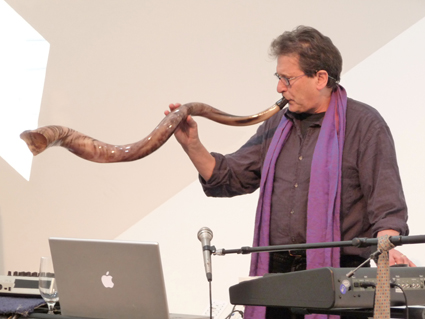
Alvin Curran, Shofar III concert with William Winant, Contemporary Jewish Museum, San Francisco, 2009
photo Susan Levenstein
Alvin Curran, Shofar III concert with William Winant, Contemporary Jewish Museum, San Francisco, 2009
Alvin Curran, Melbourne, Sydney
It may have already started by the time this reaches your inbox but it goes for six hours so you might catch some of it—Soundstream’s Gabriella Smart will be performing Alvin Curran’s Inner Cities at the Religious Centre, Monash University. Curran has been touring Australia, a guest of Tura’s Totally Huge New Music Festival (see feature) and Soundstream, Adelaide (just announced as winner of the Award for Excellence by an Organisation in the 2013 Art Music Awards). In Sydney Curran himself will perform at SIMA’s Sound Lounge with Jon Rose, Cor Fuhler and Robbie Avenaim, plus there will be a semi-secret rendering of Inner Cities at a private residence.
Alvin Curran, Inner Cities, Monash University, Melbourne, 18 Aug, http://www.monash.edu/news/events/show/inner-cities; SIMA, Curran, Rose, Fuhler, Avenaim, Sound Lounge, Seymour Centre, Sydney, 31 Aug, http://sima.org.au/August31AlvinCurranjonRose/879/n/3/0/0/; Inner Cities, private residence, Sydney, 1 Sept, email for details
RealTime issue #116 Aug-Sept 2013 pg. web
© RealTime ; for permission to reproduce apply to realtime@realtimearts.net
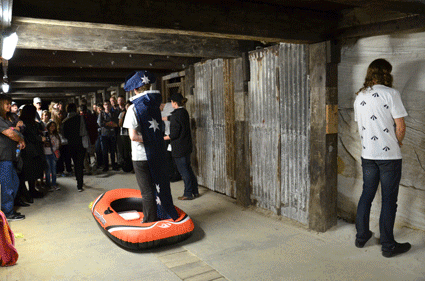
Stations of the Southern Cross, Applespiel, Underbelly 2013
photo Rafaela Pandolfini
Stations of the Southern Cross, Applespiel, Underbelly 2013
Stations of the Southern Cross, in the 2013 Underbelly Festival, was the latest from self-described “small but likeable theatre group” Applespiel. Taking audiences on a faux-tourist walk through Cockatoo Island’s Dog Leg Tunnel with various stops and stagings along the way, they told their own sham history of Cockatoo Island, which gradually imploded in on itself as its contradictions mounted.
Stations of the Southern Cross’ hysterical conclusion saw the arrest of Applespiel’s members by History Police for crimes against truth, the idea being that the mainstream story of Australian history is itself a giant fallacy with less to do with reality than continuing colonial mythology.
Despite, or rather because of, a dedicated lo-tech anti-aesthetic, the show was punctuated by a series of seemingly disparate but extremely beautiful images that remain sharply inscribed in my memory: the choppy waters of Sydney Harbour rendered as ruffled blue cellophane in a home-movie-style shadow projection; Ned Kelly singing Cold Chisel at a pub karaoke, under a disco ball looming from the tunnel’s recesses, his infamous helmet re-fashioned from VB tins; and tiny white origami ships, floating in pink- and blue-lit silvery steel buckets, symbolising the first fleets of boat people that came through the heads over 200 years ago.
Braided narratives that tie plot-knots around themselves are now standard in theatre and cinema. The worst of these self-referential projects invariably emit an annoyingly smug, post-postmodern vibe of all-knowingness. Applespiel do indeed turn their narratives inside out, but their childlike humour, sincerity and perceptiveness endear rather than alienate them from their audiences, whom they clearly regard with the utmost intelligence. Applespiel seem to really know what they’re doing. This latest smart, self-assured, formally inventive work cements the troupe as true cultural innovators, although I assume, a little sadly, that the site-specific nature of the project will most likely preclude its presentation elsewhere.
The real genius of Stations of the Southern Cross was the way it worked with and not against its setting in the chilly Dog Leg Tunnel. The site of Cockatoo Island was key to the experience of Underbelly Arts—traipsing around this place gives audiences the sense that their city is expanding internally and into the harbour rather than away from the CBD. But many artists are still most accustomed to working in black boxes or white cubes, and the projects that tried to simulate the self-contained conditions of a traditional gallery or theatre were the least successful. Art events on Cockatoo Island must almost program against the location by curating works that can hold up against the imposing industrial ruins.
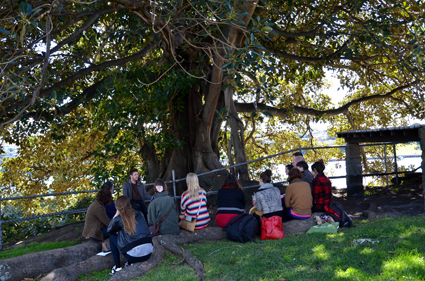
Filibust, Nick Keys, Underbelly 2013
photo Rafaela Pandolfini
Filibust, Nick Keys, Underbelly 2013
Nick Keys was an artist who communed successfully with the site during his work Filibust, under a Moreton Bay fig in the Convict Precinct. His was a work of halves. The first was a sprawling hour-long group discussion akin to a very egalitarian university tutorial. Keys analysed the filibuster, an American congressional procedure that allows politicians to delay and obstruct bills they oppose by speaking at length, using the language of durational performance art—a flat-out great idea that successfully overlayed politics and art. A teacher and writer, Keys conversationally showed how an epic and absurd tradition could be both a sign of a broken political system and an elegant performance piece. As he said, “it’s not hard to see why artists are attracted to a gesture of great symbolic potency with marginal real effect.”
The second half of Keys’ performance was a 75-minute filibuster-style talk on the art of rhetoric, using clips from the unlikely foursome of Martin Luther King, Malcolm X, Kanye West and Jay-Z. Weirdly, it worked as a kind of “intergenerational double date” on the inheritance of the civil rights debate, and not just because it excavated the almost infinite connections between the language of these four, but because Keys was one of the few artists who questioned the politics of using Cockatoo Island as a rehabilitated destination for cultural tourists.
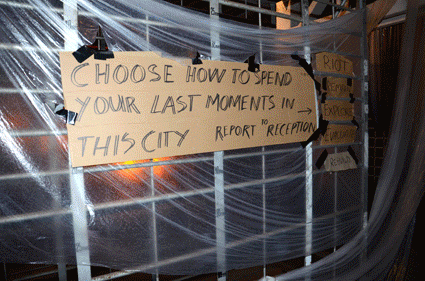
I Met You In A City That Isn’t On The Map, we do not unhappen, Underbelly 2013
photo Rafaela Pandolfini
I Met You In A City That Isn’t On The Map, we do not unhappen, Underbelly 2013
Otherwise, the mandate of the festival was fun. For the wonderfully titled I Met You in a City That Isn’t on the Map, by We Do Not Unhappen, this sense of fun came at no conceptual expense. A simple premise–what would you do if today was our last?—melded participatory art with the imagery of disaster films to produce a project that anyone could engage with, regardless of age or art expertise. Audiences were unleashed into a cardboard shantytown and given four choices: riot, remain, repair or explore. Explorers were given sheets of blank yellow stickers on which to scrawl their own messages (“Happiness is almost here,’ “S.O.S.”) and dot them around the city. I slapped one of mine onto a decrepit skyscraper, only to see it overthrown a minute later by a gleeful ‘rioter’ and then crazily restacked by a small child. The whole sprawling mess coalesced with a sweeping soundscape by local composer James Brown. Quite simply, it worked, making a functional collective out of an audience of strangers. If this is the art of today, I’m on board, and so it seems is a hefty slice of Sydney’s art-going populace.
Underbelly Arts Festival 2013, Cockatoo Island Sydney, Aug 3-4
RealTime issue #116 Aug-Sept 2013 pg. web
© Lauren Carroll Harris; for permission to reproduce apply to realtime@realtimearts.net
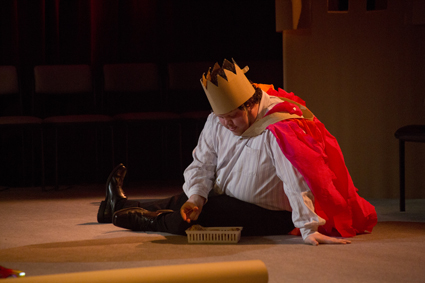
Jeremy Broom, Catalogue of Dreams, Urban Theatre Projects
photo Fred Harden
Jeremy Broom, Catalogue of Dreams, Urban Theatre Projects
There is a central visual focus to Urban Theatre Projects’ Catalogue of Dreams: a small boy on a circular carpet, within a larger square. A fostered boy. He plays with a toy, his eyes remaining lowered. A man sits beside him on the floor, cross-legged, inviting him to eat at the table, if and when he wants to. The voice is delicate, even tentative; not pushing.
The contrast between man and boy is striking: the man, large, articulate, soft; the boy, mute but not unmoving. He stays within his own rhythm, his game, his routine, where he is sure.
We see three other adults, aloof at a dinner table. No enticing smells waft towards us: we are sharing the square chamber with something bland. But the playing space is also an arena or boxing ring, without a visible referee. Anything imperious in this scene is invisible, or leaches out through sound—the scrape of cutlery, cutting, slicing, measuring all the unspeakables, the gaps in experience and understanding between the order and routine of ‘normal’ lives and the disorder that must have thrown the boy into this, his foster child circumstance. What is striking is how much delicacy is manifest in this scene, and yet, one doubts to what extent touch, contact, redemption, is actually achieved.
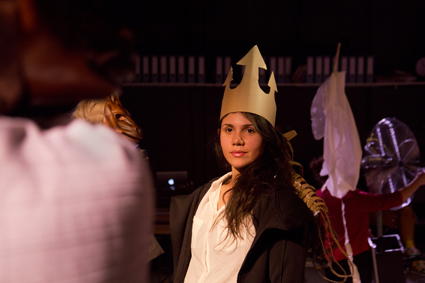
Casey Keed, Catalogue of Dreams, Urban Theatre Projects
photo Fred Harden
Casey Keed, Catalogue of Dreams, Urban Theatre Projects
This is a work—whether about or beyond the subject of fostering children—created in a city “perceived as the centre of decision-making.” The set largely comprises office desks and chairs. We, as audience, line the walls in plastic chairs (oh how like a Centrelink waiting-room!) and above our heads, shelves are lined with lever arch files which occasionally are shuffled around. There is a nice interplay between the number of files (hard to count how many) and not actually descending into a Kafkaesque hell where one completely loses count. One could count, if one wanted to. There is still hope here.
The strongest parts of this work are not in direct verbal exchange: they are in the soft voices, attempts at kindness, options offered, spaciousness, don’t push too hard; and where the adult actor Jeremy Broom—perhaps the boy when he grows up, pretending a coherent ascendancy—dons a messy, orange-gold cloak and cardboard crown and sings Coldplay’s “Viva la Vida” as if his companions, as if the world, cannot contain him. His voice charges the room; the other performers give space for his illusion to unfold, spend its time, and be done.
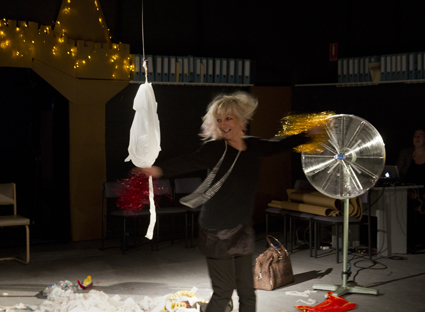
Moya Simpson, Catalogue of Dreams, Urban Theatre Projects
photo Fred Harden
Moya Simpson, Catalogue of Dreams, Urban Theatre Projects
Indeed, in this production, the voice and the voice-over give the work its finest power. Broadcast excerpts of interviews and oral histories carry tremendous force, and the piece ends with a nice return: the voiceover of a young boy, 11 going on 50, who describes his only real concern as whether or not his incapable mother (a parent surely failing psychologist Donald Winnicott’s critical category of ‘good enough’) is safe and well. Curiously, the boy (if indeed it is the same boy, or an archetypal foster-child) has not appeared on stage for the last 20 minutes; he could be the hero of a radio-play.
The meaning of the animal masks—so significant a part of the marketing for this production—seems unclear as to its benevolence or malevolence, whether intended to hide, reveal, or represent the irrational taking hold. But aside from this underdeveloped point, the production is finely judged, not overbearing, not overdone, but delicate, nuanced and strange.
Catalogue of Dreams is a collaboration between seasoned theatre practitioners, newcomers, Indigenous and non-indigenous people and some on the ‘inside’ of the welfare system. It reaches no conclusions—about the inadequacies of the welfare system, of people, of parents, or of life itself—but opens a window wide enough for us to feel the breeze of lives surviving disarray, and wonder at what can be done.
Canberra100: Urban Theatre Projects, Catalogue of Dreams, co-directors: Rosie Dennis, Alicia Talbot, performers: Jeremy Broom, Mercedes Ellis, Casey Keed, Kasey Mitchell, Isiah Ritchie, Benjamin Slabb, Moya Simpson, contributors Myall Weazel, Amber Spooner, design Imogen Keen, lighting Daniel McCusker; Commissioned by the Centenary of Canberra; Canberra Theatre Centre, 13-27 July
This article first appeared as part of RT’s online e-dition August 28, 2013
RealTime issue #117 Oct-Nov 2013 pg. 31
© Zsuzsanna Soboslay; for permission to reproduce apply to realtime@realtimearts.net
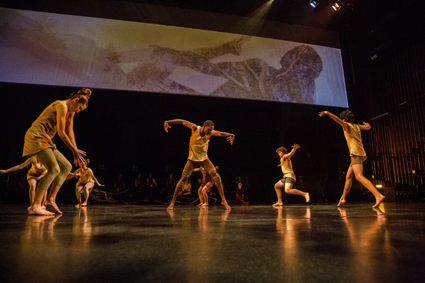
Quantum Leap ensemble, Hit the floor together, QL2 Dance
photo Lorna Sim
Quantum Leap ensemble, Hit the floor together, QL2 Dance
“I barely danced before this. It was extremely hard work. You better enjoy it.” Richard Allan, dancer, Hit the Floor Together
The value of youth dance development is bifold. Young performers reach into what they can’t yet imagine; emerging choreographers get to stretch their limbs. And sometimes one gets to see both choreographer and performers spread some surprisingly eloquent wings.
Hit the Floor Together is a project initiated by Daniel Riley McKinley (a choreographer with Bangarra Dance Theatre), incorporating young QL2 and regional dancers with older NAISDA (National Aboriginal Islander Skills Development Association) Dance College trainees. . It begins with Bearcage Productions’ short film revealing a grid of dancers in a long scrubby horizon, establishing some of this show’s major themes. How do Australians of different backgrounds understand identity? What are the cultural differences? The film establishes an interplay of surfaces and excavations. Adam Ventoura’s soundscape scrabbles glissandi (contemporary doubt) and muted thunderclaps (a threatening future) against a pulsing ostinato (our collective mythic histories).
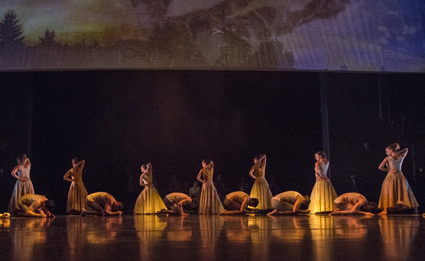
Quantum Leap ensemble, Hit the floor together, QL2 Dance
photo Lorna Sim
Quantum Leap ensemble, Hit the floor together, QL2 Dance
The projection fades, dusk to the opening’s daytime to begin McKinley’s Where We Gather. The stage is backlit to reveal dancers possibly less human than spinifex. As they blow to the wings, others appear, still, like cassowaries on a mound. Or are they already soil and ground?
The scrim remains a projection screen but is scrolled up to a narrow strip along the gantry, becoming one layer of visual geology in the landscape of the stage. A pan shot projection of arid land is intercepted by shadows of birds’ wings. Below this film, dancers become trios and sextets—dispersing, hovering, sliding, scrambling. A Shakespearean question is posed, regarding the value and meaning of existence [shadows which strut and fret…what meaning more?]. Dancers become mere seeds blown across the stage.
This is a curtain-less arena: even during focused duets, the entire company is always visible, watching from the wings. In a tradition greatly valued in Indigenous practice, no one can speak or stand for anyone else. Within the characteristic resistance to the solo (McKinley echoing Bangarra’s consistent practice) is a sophisticated concept of interdependent mutuality.
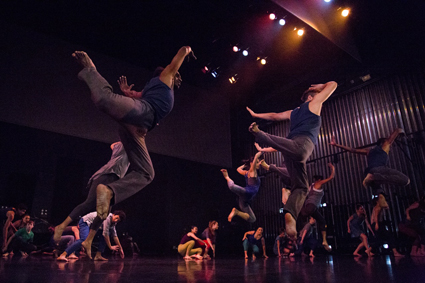
Quantum Leap ensemble, Hit the floor together, QL2 Dance
photo Lorna Sim
Quantum Leap ensemble, Hit the floor together, QL2 Dance
A sextet of white dancers is succeeded by an Indigenous mob, almost identical in their low-slung dance. But they look out further, their eyes are softer, their skins ripple distance. This is an Indigenous connection to horizon, a subtly different way of being. Strong bodies drag lighter ones, like water-reeds, across the stage. Men lift then dip their women—a romantic catch?—but the women walk away. The men then spin in strange testosterone dreams. We are left with a sense of aloneness—but who or what has done the abandoning? It is perhaps an understated reflection on lost connection to land.
Bloom begins in bright, contemporary colours, the company in T-shirts and stretch jeans. Dean Cross’ choreography is staccato and jagged. A young boy prowls; the larger group forms circles, lines, plays Chinese whispers. Clustered hands open out like petals of a waratah.
Standing frontstage, Ses Bero speaks in his native tongue until his story (about lineage and totems) morphs into English. We realise Oonagh Slater has not been translating his story after all. Ses’s pride in his heritage and Oonagh’s own story about ‘worry dolls’ both lose their respective integrities. In the evening’s overall context—so delicately respectful of cultural values and differences—this is simply poor dramaturgy. The projection for this segment has gone from sound wave to the birth of a galaxy to an endless kaleidoscope. It is hip but does not progress very far (and perhaps is not meant to). Reuben Ingall’s sound track is a hip-hop based score with live guitar feed. Repeated single keyboard notes couple electronic bolts and slides; a car-tyre pressure gauge eventually becomes an ambiguous noise suggesting an EEC machine. The soundscape is not always well matched but best contributes in the weighty, dragged, slumping choreography of Cross’s powerful ‘judging and being judged’ final scene.
Deon Hastie’s Storm begins with clouds whirling across the scrim, and angel voices (are they?) singing. The company walks backwards, forwards in repeating grids. A voice-over of storm warnings creates a build-up of static electricity. Then sparks fly: testosterone tensions flare as male dancers challenge one another in virile leaps and throws. Hastie eventually creates a curious resolution to this outbreak of violence in small group unisons with breakouts of idiosyncratic gesturing. I note the gawky angularity of work by Ryan Stone. Hastie brings in some culturally specific movement from the NAISDA dancers, both men and women, the dance becoming an interplay of similarities and differences. At times, the absorption of form from one culture (and gender) by another is quite stunningly realised, echoing Riley’s black-white pairings. Hastie has a gift for letting this happen in transformative ways.
In McKinley’s words, “feeling connected to a landscape shouldn’t be limited to First Nations, as long as you pay the proper respect to what and who was there before you.” Here’s to an ecumenical future.
Canberra 100, QL2’s Quantum Leap, Hit the Ground Together, video by Bearcage Productions, choreography Ruth Osborne, Jacqui Cornforth, Adelina Larsson and dancers; Where We Gather, choreography Daniel Riley McKinley; Bloom, choreography Dean Cross; Storm, choreography Deon Hastie; Together, choreography Ruth Osborne, Adelina Larsson and dancers; Playhouse Theatre, Canberra, 31 July-3August
This article was originally published online in RT’s August 28, 2013 e-dition.
RealTime issue #117 Oct-Nov 2013 pg. web
© Zsuzsanna Soboslay; for permission to reproduce apply to realtime@realtimearts.net
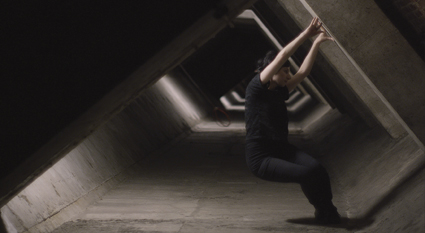
Gabriella Mangano & Silvana Mangano, Hidden Spaces, Ready Stages (production still), 2013
courtesy of the artists and Anna Schwartz Gallery
Gabriella Mangano & Silvana Mangano, Hidden Spaces, Ready Stages (production still), 2013
While the freshly remodelled Hamer Hall glows, mirrors and glints at the darkening streets outside, the old BlackBox space on its Southbank concourse, re-christened the Riverhouse, remains unrenovated. It’s an apt location for a twilight reflection on the raw guts of Melbourne’s Arts Centre, titled Hidden Spaces, Ready Stages.
The multi-screen installation, with sound by James Brown, results from a two-month exploration of the Arts Centre’s labyrinthine underbelly; an environment of machine rooms, tunnels, vents and wells. On entering the gutted exhibition space, the riverside stroll and chatter recedes, replaced by sounds both harshly industrial and uncannily evocative of nature—metallic purrings, cicadas humming amid clangs and grinds. They palpate the air between four large video components around the walls that operate almost as a trompe l’oeil, bringing what lies beneath to the surface.
The largest of the video works, near monochrome, is projected onto a stained concrete wall between two enormous, half-jackhammered pillars. A slow pan reveals curved aluminium vents and supporting frames, pipes and sprayed-on markings, shadowy mesh in the darkness behind. The sound rumbles, groans, hisses and taps. The camera starts to turn in curves too, the ‘pan’ seeming to track in three dimensions—it would be dizzying if not so deliberately sedate. The grain of the concrete projection surface mimics that of film—but the effect is painterly, not cinematic. A woman appears amid this study of shifting, 2D geometry. She moves a spotlight over herself to reveal not her own body so much as the depth and chiaroscuro of the surrounding space, as a long, slow swish blankets the room.
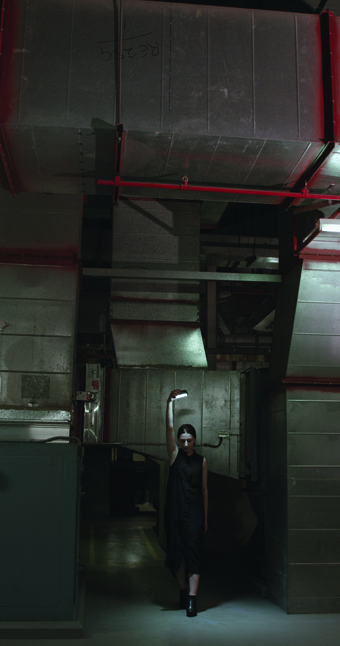
Gabriella Mangano & Silvana Mangano, Hidden Spaces, Ready Stages (production still), 2013
courtesy of the artists and Anna Schwartz Gallery
Gabriella Mangano & Silvana Mangano, Hidden Spaces, Ready Stages (production still), 2013
Another intervention takes place on the screen opposite: within a long, triangular tunnel lit sporadically by what could be cracks of daylight, a figure interacts with the inert cement walls and struts, responding to the repeating polygonal shapes around her. She adds to the geometry, rather than revealing it. There’s a discomfort to her postures—it’s as though she’s trying to ‘be’ the space and I’m reminded of Zoe Scoglio’s Rock Bodies video, in which ‘person-becomes-rock’ through a cross-fading superposition of images. The awkwardness of trying to meet the inanimate draws attention to both ‘fleshy human’ and ‘impenetrable (though now-penetrated) edifice.’
An unwieldy piece of black board in the third video both connects its exploring protagonist to the hard shapes of her surroundings and reveals the space she’s in as not-so-inert. Against a red brick wall beneath a circular cutout vent, she holds the cumbersome board horizontal, sharing its weight with a fluctuating updraught that shirrs and tugs at her clothing. The sound is uterine, evocative of the exterior, but muffled: a field of unidentifiable blurs and echoes. The appearance of colour here is a further echo of the front-window projection outside, which is not painterly but ripe and real, a split-screen study populated with lime green columns and hydraulics, splashes of orange and yellow light. In this video, again, there’s something pedestrian and awkward about a movement that tries to place itself within the hidden, mechanistic underworld, as trapped as the fluoros in their wire cages. Hands move back and forth in slowed-down clapping motion, repelled like magnets before they can meet; opening and closing or marching up and down, vaguely robotic. On the other half of the screen the camera travels, anonymous, across what’s now a landscape of terse, utilitarian forms; cables snaked and bound in hanks. This video is visible from the boardwalk, beside a noisy restaurant blaring bad pop music. I prefer to experience it from within though, reversed in slight soft-focus, in the dark; where it feels like a natural progression from the monochrome restraint and stillness of the other videos.
The guts of the theatre are traditionally hidden and the stage traditionally silent in the absence of ‘performance.’ But Hidden Spaces, Ready Stages inserts the human into the void, the artists spelunking into spaces designed never-to-be-seen-or-heard. James Brown’s pulsing, luffing, almost sexual sounds inhabit these ‘stages’ as evocatively as any operatic diva or head-slamming rock muso, seemingly sucked down through the vents from foyer to pit to boiler-room. And the curious, almost-guileless exploration and posture of the human presence in the work de-tunes the relentless chug of these spaces too, while still according them their stark predominance. These almost spectral figures create visual refrains that are subtle, intersubjective. Both straightforward and vulnerable, their presence lingers as you leave the space; living reminder of and relief from the utilitarian depths, as you step back out into the night.
Hidden Spaces, Ready Stages, Gabriella Mangano and Silvana Mangano, cinematography Tim Metherall, directors Gabriella Mangano and Silvana Mangano, sound James Brown, Arts Centre Melbourne, Riverhouse, 27 July-4 August
RealTime issue #116 Aug-Sept 2013 pg. web
© Urszula Dawkins; for permission to reproduce apply to realtime@realtimearts.net
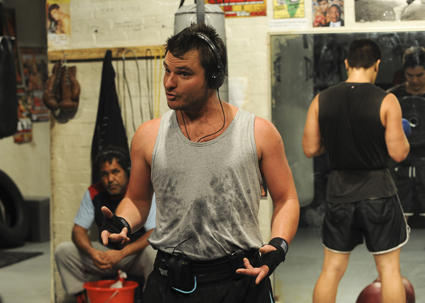
Billy MacPherson, Justin Rosniak, John Shrimpton, I’m Your Man
photo Heidrun Löhr
Billy MacPherson, Justin Rosniak, John Shrimpton, I’m Your Man
When Gus Mercurio, one of the seven boxing personalities represented in I’m Your Man, starts talking about neural synapses and how one fighter’s “brain started givin’ way” I immediately thought of Muhammad Ali. It is hard not to wince whenever I watch that once graceful and eloquent boxer, now living with Parkinson’s disease, struggle to move and talk in TV appearances.
A man renowned as much for his skill in the ring as for his poetic pronouncements and personality in front of the cameras, Ali’s physical decline over time is such a sad testament to the long term effects of the sweet science. This physical decline, as well as the youthful effervescence characteristic of the quest for success, has been on display in Roslyn Oades’ I’m Your Man at the Darwin Festival.
The American born Mercurio is played by Australian actor Justin Rozniak. As an aged and well-spoken Australian icon of the sport, Mercurio, who sits on a stool at the edge of the stage, is a welcome counterpoint to the bubbling and sometimes bumbling dialogue of the younger fighters. The play opens, as any fight would, with the sound of a bell. But in the lead up, as the audience enters the theatre, the actors are already on stage, training. We are looking at a ‘real’ boxing club: punching bags, an exercise bike, gaudy posters of previous fights. And the actors are throwing real punches. Billy McPherson as the grizzled old trainer is frightening in his intensity, holding the focus mitts and barking out punch combinations.
All of the actors in I’m Your Man wear headphones, speaking along to edited interviews with boxers, thus reproducing all the stutters, the pauses and the verbal tics of the original dialogue. The central figure in the production is Sydney based fighter Billy ‘the Kid’ Dib. Oades followed Dib over an 18-month period as he pursued the IBF World Title belt. We hear Dib, convincingly played by Michael Mohammed Ahmed, describing quite candidly what it is like to be a fighter. He traces his career, explaining how he defeated several opponents and how he would deal with defeat should it ever come. We also hear from Wale ‘Lucky Boy’ Omotoso, a Nigerian-Australian fighter who watched his sparring partner die in the ring, and CJ a pugnacious London based fighter with a serious problem with authority. There is also an appearance by the legendary Tony Mundine, sharing his views on the fight game along with his opinions on women, sex and smoking. The dreams, the turbid histories and, most of all, the braggadocio of current and former boxers are laid bare for us on stage.
I’m Your Man is Roslyn Oades’ third effort in a verbatim-theatre trilogy that explores “acts of courage” (program notes). In the bouncy, fast paced dialogue of Billy Dib we have our best opportunity to appreciate some of the sort of courage one might need in order to step into the ring and swing at another person. But even more interesting is the fact that this play, with its particular approach to representing dialogue, is about a sport with a difficult relationship to communication. Just like Jeff Fenech, who tells us that he was probably one of those guys who stopped the nation, so much of a boxer’s persona, and perhaps even his success, depends on what he says about himself. It is, of course, never humble. That unbridled ambition and self-confidence is such an inextricable part of the sport. But there is also an ugly truth about boxing that is exposed in the delivery of the dialogue. The repeated blows to the head result almost unavoidably in brain damage and this often manifests itself in a former fighter’s speech. I’m Your Man, with its use of verbatim dialogue, presents an opportunity not just to see represented the courage and the ambition of boxers young and old, but also to think about their long-term impacts.
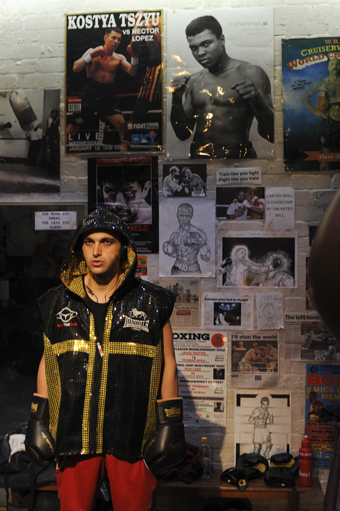
Mohammed Ahmad, I’m Your Man
photo Heidrun Löhr
Mohammed Ahmad, I’m Your Man
The scenes involving Jeff Fenech made me consider some of those consequences. There is a strain in his voice, some stutters and pauses seeming a little too long in Justin Rozniak’s account of the character. They might well be simply the verbal tics, the “unique qualities of speech patterns” (program notes), that Oades sought to capture in her interviews, but they could also be evidence of serious and irreparable brain injuries that boxing has wrought. When considering the fact that Fenech, like others in the play, are former boxers talking about their success it is not easy to ignore the thought that the verbal stumbling might be a result of that success. Interspersing the testimonies of older boxers with younger ones makes this thought more poignant.
Explaining her use of verbatim theatre for this production, Oades writes of her long held fascination with the “unique qualities of speech patterns, individual vocabularies and group conversations” (program notes). Over the course of the 70-minute production we are treated to a series of such speech patterns that culminate in a wonderfully realistic depiction of a pre-match build up with Bill ‘The Kid’ Dib. We follow Billy and his team into a dimly lit dressing room before his test against Jorge Macierva. While Dibs bounces around the dressing room floor his trainers and corner men repeat over and over variations on “How Billy is going to destroy the Mexican.” The group exchange is as smooth as Billy’s nimble movements and provides a fascinating insight into the unconscious work of coordination in which humans partake when conversing in a group. All the body language and facial expressions that enable one to find the right moment to talk and argue are accurately replicated by the assembled cast.
As these men—likely fighters themselves with their own injuries to endure—usher another ambitious fighter to the brink, feeding him dreams of triumph along the way, it is hard not to wonder if it is all worth it. I’m Your Man is certainly worth it. It’s an intensely arresting meditation on a colourful but potentially damaging path to glory.
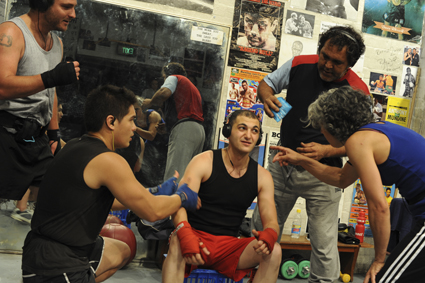
I’m Your Man
photo Heidrun Löhr
I’m Your Man
Noise, action, gym equipment and boxing paraphernalia clutter the stage. A trainer barks commands and encouragement to his boxer as they spar. The audience has stepped straight into the guts of a boxing gym; all that is missing is the sticky, musky odour of stale sweat.
We are not eased into this performance gently. The bell rings and the characters come out fighting, each clang marking a rapid segue to the next character and his story. I felt as a boxer must when he enters the ring to face his opponent.
The actors, each wearing headphones and an iPod, faithfully mimic recordings of the voices of actual boxers. All the imperfections of speech remain, including stutters, tics, stumbles and slurs. The quickfire delivery is at times disconcerting, like a boxer’s swiftly thrown punches: BAM, BAM, BAM. No hint of the carefully measured pace of traditional theatrical monologue.
The mimicry aptly reveals the differing characteristics of the boxers, from the manic energy of one to the disturbingly sedate violence of another, to the cocksure egotism or the concerns of the ‘King’ who wants to make sure his court of supporters enjoys the same spoils of victory as himself. “Feel like the King, but being the King in the right way, you know?”
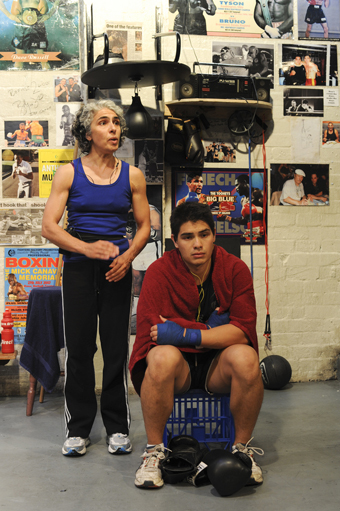
Katia Molino, John Shirmpton, I’m Your Man
photo Heidrun Löhr 2007
Katia Molino, John Shirmpton, I’m Your Man
Interruptions sometimes lead dialogue away from the central theme of boxing to reveal a deeper dimension. An aside to one of the “ladies that works here” bumps the dialogue off track as the boxer reflects, “boy and girl get together to relax their body. Sometimes relax their body too much, you know?”
While I’m Your Man is heavily dependent on dialogue, at times visual effects are used to reinforce a theme. The competitive nature of boxers is displayed as two gym mates skip together in training. Each notices the other and the tempo and skill level of tricks increase as the two try to outdo each other with displays of speed and prowess.
Music and soundscapes are used sparingly, highlighting particular moments, building the momentum towards a climax or intensifying the emotion in a boxer’s words. One poignantly reflects upon the accidental death of his sparring partner and the punch he threw that ended his life. The boxer approaches his next fight in homage to the dead man, reliving the tragic event, the light darkening and the music moaning and groaning in unsettling accompaniment.
Win or lose. Beat or be beaten. “Probably if you don’t smash ’em, they’re gonna smash you.”Clearly a driving force for any boxer, this theme was realised in different ways time and again.
In a vignette focused on a winner and a loser, the defeated boxer sits quietly, shrouded in a towel. His manager stands behind. With his Thai accent the manager stumbles over the pronunciation of “Cinderella Man” and the audience giggles in response. We are thrown to the winning boxer whose frenetic energy provides an extreme counterpoint to the stasis of the loser. While the losing manager attempts to explain the plight of his boxer, the winner is busy handing out autographed pictures of himself to the audience. The loser fades into the background. The winner and his entourage noisily head off stage for “Maccas,” crashing about full of adrenalin and masculine bravado.
While the boxers often ooze ‘piss and vinegar’ we are also reminded of the vulnerability of these seemingly hard men. At 84 years of age a tired man honestly reveals a struggle with alcohol and the many back operations that have left him in pain. I’m Your Man is the third work in a trilogy exploring courage. Despite all the shouting about guts for glory there is no doubt that in the boxing world courage carries a cost.
“Hands up, head down.” As a boxer reminds us, this is good advice not only for boxing but also for life. I couldn’t help but think it to be good advice for anyone in the audience for I’m Your Man.
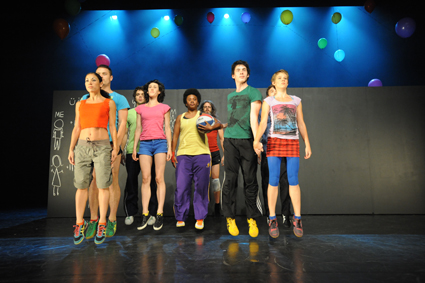
Happy as Larry, Shaun Parker
courtesy the artist
Happy as Larry, Shaun Parker
Beneath a balloon-filled stage, a large black box serves as backdrop, blackboard, springboard and backstage for Happy As Larry (set design by Adam Gardnir), a dynamic urban dance piece from Australian choreographer Shaun Parker and his company exploring the nature of happiness.
The box provided more than a few surprises as the cast slouched against, hung from and sprang from its sides, performing a mix of modern dance, breakdance and acrobatics. Revolving on rollers, changing scenes, taking dancers with it, revealing others, the box also rolled backwards, making space for extended dance numbers. At one point it span at high speed, adding to the momentum of a rollerskater racing around in the opposite direction. Dancers disappeared inside, sat atop and leapt over it. One of the highlights was watching the whole cast parkour over the top, making increasingly daring dismounts. It also served as a blackboard and, as the show progressed, a touching dialogue in chalk was established between one character (The Observer), the rest of the cast and the audience.
According to the program, “the cast of characters is developed from the Enneagram, a psychological system that maps nine personality types” (program notes). I found myself focused on the Observer (Timothy Ohl). I enjoyed seeing him irresistibly drawn into the dance and communicating his thoughts and feelings on the board. In one scene he danced with the chalk, making marks in time with the music, articulating it beautifully in arcs, waves and lines: high, low, flowing, sharp, flat, round. This scene allowed time to dwell on the work of composers Nick Wales and Bree Van Reyk, whose electroacoustic soundtrack reflected the personalities on stage and the full spectrum of emotion in the dancing.
Wearing simple, coloured street clothes, the cast (six men and two women) danced their way into our hearts, jiving and diving below the surface, tapping into emotion and experience that clearly resonated with the audience. As they searched for happiness, we felt their hope, disappointment and sadness, but above all Happy as Larry made me smile: The Perfectionist, a fitness fanatic who would not be distracted by The Tragic Romantic; the Performer who exhausted himself winning the applause of others; the Optimist learning to skate. I enjoyed the headstands and the clowning— the playfulness of the piece.
Although intermittently drawn into the fun, the Observer remains the outcast. We receive a dramatic ‘wake up call’ when his inner torment turns suicidal and he shoots himself in the face with blue chalk. However, quick changes don’t allow us to dwell on any one moment in Happy As Larry, perhaps pointing to the transient nature of emotion, or the elusiveness of happiness itself. As the Observer writhes on the ground, the stage revolves, this ominous scene replaced by a giant ghetto blaster (drawn on the blackboard) setting the stage for the final ensemble piece.
Lighting designer Luis Pampolha uses simple combinations to illuminate the mood: blue, diffuse—sad; white, bright—happy; and a spotlight for intensity. Yellow highlighted the blackboard and its tape play button that triggered the grand finale. The cast ‘took it out,’ mixing sweat and chalk in one last explosion of physicality: catching each other, collapsing, loose, dependent, one by one disappearing behind the box…leaving the Observer to trace his lines on the board.
In the final scene, as the Observer reflects on his experience, a viola plays and the balloons begin to lower, dragging him down with them, until he’s cross-legged on the floor. With a click of his fingers they shoot back into the air. Such is life, Parker seems to be saying; happiness turns on a dime.
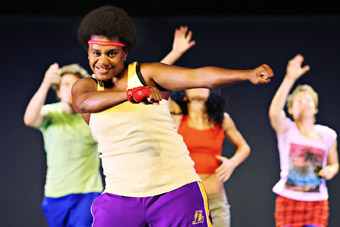
Ghenoa Gela, Happy as Larry, Shaun Parker & Company
photo Prudence Upton
Ghenoa Gela, Happy as Larry, Shaun Parker & Company
During the final ensemble moment of Happy as Larry I thought I could see a flaw in an otherwise seamless mass of movement on stage. A couple of arms and legs struggled to keep up with an intense dance set and I suspected that it was the result of fatigue. But it’s part of the act, as one by one the dancers fall out of synch with the rhythm and movement until we are left to focus on one lone character with a large question on his mind. He sits cross-legged on a stage full of balloons, inviting us to ask ourselves: how does anyone find happiness?
Happy as Larry is visiting the Darwin Festival as a part of a two-month national tour. A product of Shaun Parker and Company, the performance features a cast of nine characters based on the Enneagram, a psychological concept that articulates nine distinct but interconnected personality types: The Perfectionist, The Giver, The Performer, The Tragic Romantic, The Observer, The Devil’s Advocate, The Optimist, The Boss and The Mediator (program note). These are manifested in a broiling mix of contemporary dance, hip hop street style, ballet and a Chaplin-inspired roller skater all set to the refreshingly clean and crisp electroacoustic score by composers Bree Van Reyk and Nick Wales.
The set and the colours are simple, evoking a sense of childlike wonder with the world. A rainbow of helium filled balloons—perhaps a symbol of that happiness we seek—frames an enormous rectangular prism lying lengthwise. The two long sides of this massive set piece are blackboards on which one of the characters traces movements, scrawls simple pictograms and writes the occasional message using chalk. The dancers are dressed in different colours hinting at their distinct personality type, but we never learn precisely what these colours and the dancers represent. With mostly the music and the movement to read we are witness to a series of short dance vignettes as part of a performance that runs nearly 90 minutes: a rumination on the fleeting and capricious human expression of happiness.
Probably the most profound of these vignettes involves a character with traits of The Performer. We watch how this shirtless male dancer discovers an approving and encouraging audience among those gathered on stage. His expression of determination turns towards ecstasy as he lands jump after jump in a series of break dance and ballet moves. But the elation ends when he stumbles and falls. The dancer and his audience leave the stage deflated. Shortly after, shirt back on and seemingly wounded, he re-appears watching a group of men mimic ballroom dancing. They are lost in joyous laughter. I am reminded of small children playing in the mud as the dancers move to the blackboard and smear each other in chalk. Slowly, The Performer is absorbed into the group and they spectacularly launch themselves off the back of the blackboard. In this scene we witness the very simple creation of happiness, first through intense individual effort; the evaporation of that happiness; and then the near effortless recovery of an altogether different form of happiness as a member of a group.
But involving one’s self in that communal happiness is not a simple task for everyone. The often frustrating struggle to find contentment is played out by The Observer—the man who holds the chalk. Throughout most of the performance he watches with detachment his fellow dancers act out their respective experiences of joy and sorrow. Some form of expression is brewing, however, and we glimpse it when he writes, “I need company” only to change that message to “I don’t need anyone” the moment his friends appear. The alternating attraction to and repulsion from company is an example of the undefined nature of happiness explored in this character. In The Observer we see how joy, elsewhere achieved by spinning a ball or learning to roller skate, can be so easily undermined by one’s personal characteristics. Such moments are part of what makes Happy as Larry a dynamic and complex production.
The music of Van Reyk and Wales is as fluid as the personality types depicted in the dance. It moves gently from the strings of cellos, harps and violins to the crisp, crackle and thump of electronic beats. Perhaps this blend of acoustic instruments with electronic sound echoes our experience of genuine and artificial happiness. It is as though we have been left to ponder, watching the lights fade on the chalk-dusted face of The Observer sitting among the balloons at the end of the show. In the lead up to this moment a simple piano tune plays along with beats. We have our moment of quiet to ponder the source and sustenance of our own happiness and then, with a snap of The Observer’s fingers, the rainbow rises and the time for rumination is over.

Happy as Larry, Shaun Parker
courtesy the artist
Happy as Larry, Shaun Parker
A wordless playground where people (adolescents?) come together to play in front of a giant blackboard is the setting for Shaun Parker’s athletic dance work investigating happiness.
Each of the characters is based on personality types mapped in the psychological system the Enneagram (program note), while each dancer has their own speciality—breakdance, contemporary, jazz, body popping, acrobatics, roller skating and ball spinning. Mostly they dance in pairs, occasionally a solo and, top and tailing the show, are two ensemble moments, both tight and invigorating synchronised pieces combining the various genres.
The skilled dancers move with control and energy as they navigate their respective emotional minefields—connecting/not connecting, supporting/dropping, coming together/moving away. They seem to want something, but I’m not sure what. Do they even like each other? It seems a lonely world, even for the lovers who have a brief moment dancing together on a pair of skates before one of them leaves. Another character executes balletic turns, preens and bows to his surrounding audience who applaud his every move until he falls, whereupon they leave him alone to his desperate practice.
For a work about happiness Happy as Larry is surprisingly sombre with the character who spends most of his time watching the others dance, presumably Larry, opening with a prolonged mirthless laugh. No emotion shows on his face or the faces of the other dancers for the majority of the work, generating a slightly unsettling, almost ominous mood. No-one seems happy, certainly not Larry who in the final scene struggles within the coloured balloons that have descended from their spot above the giant blackboard to envelop him. He strikes out with an aggressive attack complete with gun motif.
The blackboard, dominating an otherwise empty space, starts clean with Larry drawing replicated figures in neat rows, which he then labels as “you” (the audience). His careful and painstaking drawing reminded me of a naughty pupil being forced to write lines. Throughout the show the board is filled with chalk sketches—child-like figures, simple statements—“I need company,” “I don’t need anyone,” “That was fun”—and meaningless scrawls as one dancer draws around another’s body. It is also a springboard for dancers who leap off the top, hang on to it upside down, disappear inside it and skate in wide sweeping circles around it as it revolves to reveal another scene.
The lighting adds to the slightly lugubrious atmosphere, containing the action and creating a claustrophobic edge, only opening out for the moments when the whole company comes together. The music by co-composers Nick Wales and Bree Van Reyk is a powerful and eclectic mix of electroacoustic with classical snippets that stand alone before being consumed by beats and popping and buzzing effects.
The show comprises self-contained sequences with the giant board revolving to introduce each new segment. Characters reappear but the narrative does not progress and ultimately this repetition becomes monotonously predictable with no sense of the work building to a conclusion. In the end I leave Happy as Larry feeling a little bit gloomy.
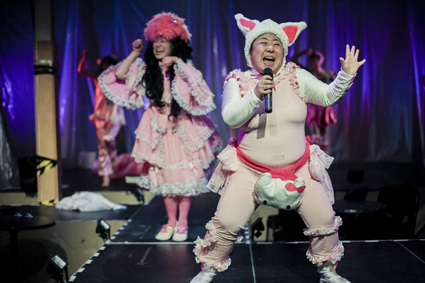
DasSHOKU SHAKE!
photo Vikk Shayen
DasSHOKU SHAKE!
If you want to be seized and dropped into a bizarre and cacophonous world of extreme entertainment then see DasShoku SHAKE!—a Japanese Australian butoh cabaret extravaganza. Inspired by the 2011 earthquake and tsunami in Japan this production is an exploration of the shaking of the physical world, the psychological self and culture.
In a series of butoh/cabaret acts linked by Yumi Umiumare’s character searching for “the Light” in a world that is unravelling, the audience is exposed to a heightened and exuberant subverting of cultural stereotypes—the Japanese businessman frantically bowing and pressing his business card on members of the audience before losing his intestines, the mother dressed in outrageous pink, vomiting at the smell of her child and inhaling air freshener, the very ‘nice’ and too clean American girl/boy pair, fast-food culture, office workers, game show hosts, dancing poo, a fairy-tale that appears drug-fuelled, a parody of sex and desire with a woman in a costume of numerous huge breasts that dancers crawl after and suck on, modern Geisha in grand punk/Geisha costume, orgasms and balloons. It’s all here, in your face and as gripping as it is deliberately excessive and carefully crafted.
DasShoku SHAKE! immerses us in an extreme state in which people have experienced the unimaginable. The butoh-trained performers are compelling. When they shake from their core they seem almost inhuman.
There are moments of quiet within this maelstrom that touch on the simplicity of life. The electronic blips, drum beats and static stop. Umiumare alone on stage, spotlit, asks the audience if we’re following so far. She searches for clarity in the program, asks us how we’re going and then advises us to “breathe deep and return to who you are.”
In among the wild excess of the cabaret-punk costumes and a driving soundtrack that goes from cheesy tunes to grand classical to unsettling electronica, there are bone-chilling moments as unseen performers move inside huge silver tubes to embody nuclear seepage from a wrecked reactor.
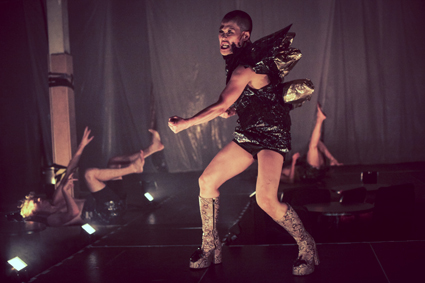
DasSHOKU SHAKE!
photo Vikk Shayen
DasSHOKU SHAKE!
In a show awash with invention the makers of DasShoku SHAKE! satisfyingly use the common device of repeating an opening image to bring the work full circle. In the first scene the ‘ordinary girl’ (Umiumare) holds a round mirror that obscures her face as she journeys through the madness around her looking for the Light. At the end of the performance she returns changed by the journey, wigless, head shaven and emotionally naked with the mirror held up but now cracked.
After all the mayhem and delight the piece has arrived at a brilliantly performed butoh solo—Umiumare crying as she retreats, drawn backwards towards the light, which ultimately consumes her. It is emotionally gutting, but full of hope.
Yumi Umiumare says this piece is “a modern ritual for both calming and provoking the souls and paying homage to the departed…” She adds that “the Japanese indigenous Ainu people consider ‘shaking the spirit’ as simply ‘thinking’…” (program note).
I felt greedy for it and shaken out of the ordinariness of everyday life.
2013 Darwin Festival, Yumi Umiumare with Theatre Gumbo and DasShoku Triangle. DasSHOKU SHAKE!, concept Yumi Umiumare and Theatre Gumbo, direction Yumi Umiumare, Kayo Tamure in collaboration with the artists, set design Ellen Strasser, sound design Dan West, lighting design Tony Moore; George Brown Botanic Gardens, Darwin, Aug 20-22
The NT Writers’ Centre’s RealTime Workshop project is supported by the Australian Government Regional Arts Fund and the Northern Territory Government.
For reviews of the 2013 Darwin Festival by Mike Bodnar, Kaye Hall, Fiona Carter, Kyle Walmsley and Nicola Fearn go to www.realtimearts.net/features.
RealTime issue #117 Oct-Nov 2013 pg. web
© Nicola Fearn; for permission to reproduce apply to realtime@realtimearts.net
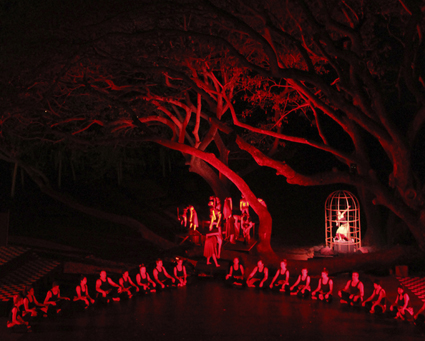
Zombies in the Banyan Tree, Tracks Dance Company
photo Jess Devereux
Zombies in the Banyan Tree, Tracks Dance Company
A balmy Darwin night, the sticky beginnings of the build up, nestled under a rain tree in the Botanical Gardens—you’d almost think you were just hanging out in Festival Park if it weren’t for that wave of zombies approaching.
Tracks Dance Company’s latest production, Zombies in the Banyan Tree, takes the traditional Hindu story of the Ramayana and spins it on its head by mashing it with break, contemporary and Balinese dancing, a traditional Kecak choir and a beatboxer. This is a recipe with a lot of chefs involved. One look at the credits attached to the production and you get a taste of what Tracks is renowned for—bringing together a whole heap of people who are passionate about dance from all around the world, to work with a team as diverse as the work itself.
Most of my dance training comes from obsessive addictions to TV shows such as Dance Moms and So You Think You Can Dance—which I think qualifies me to speak quite proficiently on the nature of off-stage arguments had by dancers moments before performing. Unfortunately this didn’t come in handy at all. What was evident in this dance work was the opposite—joy resonating out from the performers.
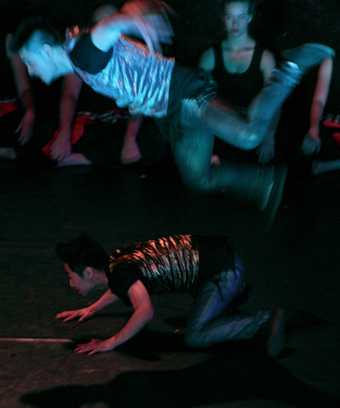
Zombies in the Banyan Tree, Tracks Dance Company
photo Jess Devereux
Zombies in the Banyan Tree, Tracks Dance Company
The story told is of Butterfly spirits who come up against Demons of the underworld in some contemporary/break dance fighting. They feud and a Butterfly is captured in a giant cage. The Butterflies and Demons face off, slowly destroying each other—the dead becoming the undead as their movements become zombified. The last Butterfly and the last Demon face off in a battle. After the Butterfly Goddess is freed from her cage in order to restore balance in the nick of time, the Butterfly and Demon each find a moment of quiet redemption at the other’s flower-filled pond.
My first experience of Kecak dancing was in Bali, at a traditional ceremony, complete with rogue fireballs and people performing a ritual from their own culture. Here in Darwin, where performing the piece lends itself to a little contextual cultural confusion, the performers chanting the Kecak “chk-chk” manage a fair representation of the ceremony. It’s reminiscent of a really rhythmical group of crickets, locusts and chickens, who for some reason have all decided to form a band. The hypnotic ostinatos are reminiscent of Steve Reich and the effect of this rhythmical soundtrack is energizing.
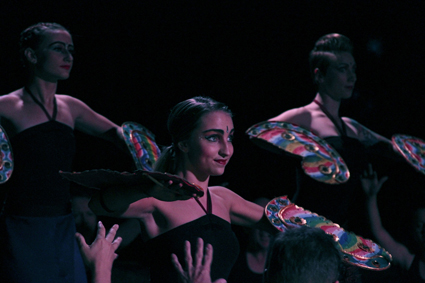
Zombies in the Banyan Tree, Tracks Dance Company
photo Jess Devereux
Zombies in the Banyan Tree, Tracks Dance Company
The show’s contemporary soundtrack is provided by the beatboxing of K FUZZ. I really wanted to see more of K FUZZ but unfortunately he had to work his magic and his looping machine from the side in the shadows. He revealed an incredible sonic range—evoking everything from the cracking of zombie skeletons to the synthesizer of Michael Jackson’s “Thriller,” and every beat in between. This live accompaniment brought another very real and present anchor to the action—and all done through the sounds made by the musician’s mouth, microphone and looping. Howling winds were precisely managed and every pop, squelch and plosive was expertly timed alongside the action.
The live beatboxing joined the chorus to take Kecak into 2013. Seated in a circle the chorus for the most part occupied the centre of the stage, shaping the performance space along with its platforms and lighting divisions. One highlight for me was the sweeping walk, or stage cleanse, when the chorus took control forcing the zombies to their corner and the butterflies to theirs.
At the show’s end we’re reminded of the importance of balance as the rescued deity steps forward and everyone falls into place. The final image is of the breakers and the butterflies in balance either side of the princess and the Kecak choir. Once again peace is restored, and we are all living harmoniously beneath the Banyan tree.
Sydney based choreographer Nick Power guided the breakdancers throughout the creative process. We see what happens when breakdancers are provided with structure, taking their style and uniqueness through a process of professional guidance—SHAZAM! In fact, these are the moments that are most alive in the piece. The breaking, particularly in the battles with the butterflies, is fierce and electric. To see breakdancing used to drive a narrative is a step forward for the style.
Apparently the zombies had not watched a single episode of So You Think You Can Dance. As any casual viewer would be able to tell you—breakdance never wins against contemporary.
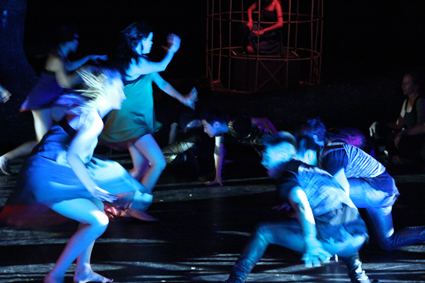
Zombies in the Banyan Tree, Tracks Dance Company
photo Jess Devereux
Zombies in the Banyan Tree, Tracks Dance Company
In August, RealTime Managing Editors Keith Gallasch and Virginia Baxter were in Darwin mentoring five writers—Fiona Carter, Nicola Fearn, Kaye Hall, Kyle Walmsley and, from Alice Springs, Mike Bodnar—to produce reviews of works in the final week of the 2013 Darwin Festival program. The NT Writers’ Centre’s RealTime Workshop project was supported by the Australian Government Regional Arts Fund and the Northern Territory Government. You can read 13 reviews at www.realtimearts.net/features [Eds].
A lone musician appears in the fading light of dusk, seats himself centre stage at a bamboo gamelan and begins to play. The audience is hushed, drawn into the rhythm of the gamelan and the surrounding sounds of the approaching night.
Integral to this production are the live beats and myriad sounds of traditional Balinese music, Kecak choir and Beat Boxer K-Fuzz. Placing live musicians directly into a dance or theatre work allows a relationship to build between performers and music. Rather than simply waiting for the next beat to fall, musicians and dancers have the opportunity to respond to each other, creating a tight link and potentially strengthening the power of the delivery.
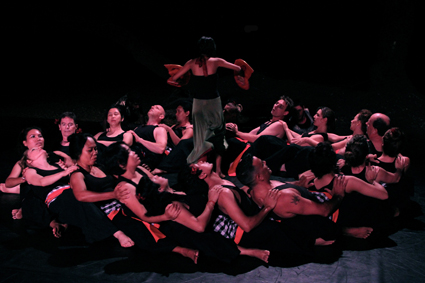
Zombies in the Banyan Tree, Tracks Dance Company
photo Jess Devereux
Zombies in the Banyan Tree, Tracks Dance Company
While at times this two-way relationship was evident, in particular between the lead Zombie and the Beat Boxer, much of the performance felt as though the dancers were performing to pre-recorded music, relying on the backing sounds to fall into place with their choreography. This seemed like an opportunity missed.
Tracks has built a reputation on inserting dance venues into Darwin’s everyday landscape, transforming these sites from the usual to the unusual and magical. Set against two rain trees in Darwin’s George Brown Botanical Gardens, the obvious question arose: “Where’s the Banyan?” Despite Artistic Director Tim Newth’s best laid plans, the banyan he had sited the work around was cut down and removed just weeks before opening night, highlighting just one of the many challenges to creating your own venue.
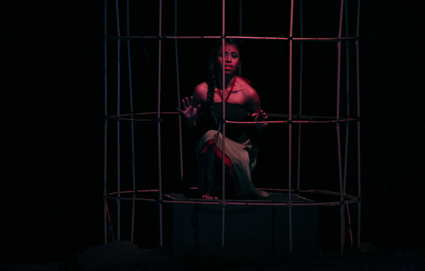
Zombies in the Banyan Tree, Tracks Dance Company
photo Jess Devereux
Zombies in the Banyan Tree, Tracks Dance Company
Odd jibes about Tracks’ botanical mislabelling aside, Newth’s design brought together nature, set and light to evoke images of a shadowy world in the thick limbs of trees where Zombies and Butterflies do battle over good and evil. Cold purple lighting for the snarling Zombies, a soft yellow for the delicate Butterflies, red to create a world in mayhem and nature’s own contribution of a rising full moon underpinned the mood and drew the elements of the setting together.
The concept of seemingly opposite forces and their interconnection in the natural world is a strong theme in Balinese culture and this theme was woven through the performance. From the black and white check of the Kecak performers’ costumes to the same pattern on the floor of the set, to contemporary and traditional cultural forms being presented side by side, the sense of yin and yang was constantly reinforced.
The Butterflies, all female, wore dramatically bright makeup, airy dresses and flapped intricately designed handheld wings. In contrast, the Zombies, predominantly male, wore muted colours of black and grey and lurked in the protection of the rain tree. This central theme of opposition was, however, at times compromised causing conflicting emotional responses.
We were set up to feel sympathy for the Butterflies as one of their community was dragged from the stage by the Zombies, her wings violently plucked. This damaged Butterfly spent most of the remainder of the performance caged. Yet as the Zombies and Butterflies clashed in battle, and the Zombies began to show dominance, audience members cheered the squelchingly gory deaths of the Butterflies. A mix of graphic sound effects and cheeky choreography had brought the audience to the side of the Zombies.
In such a dark piece, it was curious to see humour introduced at such a late stage. Once again I felt conflicted when Michael Jackson’s “Thriller” made a fleeting appearance and when some of the more grotesque moments were suddenly made light of with humorous sounds or gestures.
The Kecak choir is the centerpiece of Zombies in the Banyan Tree and is another artistic form drawn directly from traditional Balinese culture. Perhaps made most famous by its appearance in the 1992 film Baraka, the Kecak choir works its way to a state of frenzied trance through rhythmically mechanical chanting and unison movement. Led by Balinese dancer Desak Putu Warti and her brother I Dewa Putu Sudiantara, the choir was made up of local community members who had answered a general call-out to take part.
The Kecak choir represents two areas of particular interest shown by Tracks’ Artistic Directors—the involvement of the general community in their shows and the incorporation of elements drawn from a variety of cultures represented locally. While I understand the philosophy to explore and create work that speaks about the community in which we live, this performance left me wondering about the introduction of a complex cultural form to untrained performers in such a direct translation. I waited excitedly for the Kecak choir, and the work, to build to its predicted climax, only to find that it never arrived. For me this poses the question—in order to make the work their own, how does an artist overcome expectations like mine when using a well-known cultural form?
Moments of this performance will remain with me: Putu’s wailing lament drew a bleak yet beautiful image and the vocal flexibility of K-Fuzz sustained the performance. Zombies Under the Banyan Tree reminded me just how culturally rich this community I live in really is.
Tracks Dance Company, Zombies in the Banyan Tree, concept, direction David McMicken, Tim Newth, choreographers Desak Putu Warti, Jessica Devereux, Nick Power, musicians I Dewa Putu Sudiantara (Bali), Megan Atfield, Desak Putu Warti, Michael Koufos (K-Fuzz), George Brown Botanic Gardens, Darwin, Aug 9-20
The NT Writers’ Centre’s RealTime Workshop project is supported by the Australian Government Regional Arts Fund and the Northern Territory Government.
RealTime issue #117 Oct-Nov 2013 pg. web
© Fiona Carter; for permission to reproduce apply to realtime@realtimearts.net

DasSHOKU SHAKE!
photo Vikk Shayen
DasSHOKU SHAKE!
How do you explore mindless capitalism in the face of one of the world’s most horrific natural disasters? Take hyped Japanese businessmen, lascivious Geishas, balloon boobs, one very bent “good Japanese mummy” (and her dancing baby poo heads) and a woman “searching for the Light”, and throw them together in a mad kitsch crush of Butoh and Burlesque, heading for impending doom.
“If you don’t understand our Janglish just put up your hand and we will explain it to you in more Janglish!”
Directors Yumi Umiumare and Kayo Tamura wring every bit of crazy out of the lighting, sound and cast of DasSHOKU SHAKE! punctuating the action with spoken word. Kayo Tamura takes lewd to a whole other level as a demented nurse and pink crinoline kewpie doll mummy feeding her baby ‘WacDonalds.’
“We love looking after people because we can forget about all the bad stuff. Stay sick!“
In contrast, trapped in the capitalist machine and eschewing the superficial light of the power company, Yumi Umiumare emanated torment: “Give me no enlightenment but give me the Light.” Amid manic coloured lighting and J-pop partying she fears the worst: there is no truth, no Light. She vomits.
“Are you following so far? Breath in, breath out.”
Around these people, more chaos reigns as fervent businessmen and dizzy pink ‘mouseketeers’ are juxtaposed with grim soldiers in gasmasks and protective clothing. A salaryman hands out business cards while women manically masturbate, psychotically popping balloons. The cast, including Australian performers and members of the Japanese absurdist troupe, Theatre Gumbo, drew reticent audience into their madness, demanding fervent sexual embraces.
“Be calm and composed. You’re clear.”

Members of Theatre Gumbo, DasSHOKU SHAKE!
image courtesy Darwin Festival
Members of Theatre Gumbo, DasSHOKU SHAKE!
An alarm sounds. A giant silver worm emerges and stands tall, followed by two more on either side, slinking and writhing. Encased in black and silver air conditioning ducting, the performers move across a dark and smoky stage. Moaning fills the air. Umiumare reappears in jagged black costume. For me, blinded by strobe lighting and transported by a soundscape that lurched from throbbing menace to the Charleston, this scene was a visceral experience, Dancer Harrison Hall, bursting from the stage with explosive power and grace, was the icing on my DasSHOKU SHAKE! cake.
“That day I was drunk. Can you see me?”
Inspired by Umiumare’s trip home to Japan in the wake of the 2011 earthquake, DasSHOKU SHAKE! climaxes in the devastating tsunami that followed. Dressed in black plastic bags, the cast embodies chaos and destruction, and in the silence that follows, Umiumare roams the stage, looking for loved ones. People she recognizes drop, slip, slither out of her arms. All she had known is gone. A child’s yellow floatie lies at her feet.
“When you become who you really are, you become the Light itself.”
In an ironic twist, our journey through superficiality on a tormented search for enlightenment ends with George Harrison’s “Here Comes The Sun” and the show’s most faithful Butoh moment as Umiumare grieves. Faced with the horrendous reality, futility and fragility of life, the Beatles are the balm.
With traditional Japanese style, the cast broke the tension in an encore that dished up oversized sushi and sake, singing, “We’re all dying anyway. Let’s eat what we want.”
In the Ghent altarpiece John the Baptist and the Virgin Mary hold open Bibles, the brilliant pages standing out from their dark robes. You can almost hear the rustling of paper, John the Baptist’s hair shirt and the cloth the Virgin Mary uses to hold the book. At his keynote address at the 2013 International Computer Music Conference, David Toop suggested a performance of Cage’s 4:33 where the audience just looks at these paintings, imagining the sound world they seem to communicate over centuries.
Just as Van Eyck drew on an iconographic tradition of depicting readers lost in beatific contemplation on the Ghent altarpiece, so Toop drew on a shared—though less explicitly understood—sonic vocabulary to depict moments of midnight lucidity in his performances for the ICMC and the Totally Huge New Music Festival. While including iconographic sound symbols (the rustling of pages or a dog snoring), this vocabulary also included more abstract qualities that enabled Toop to include sounds of widely divergent origins in the same musical atmosphere.
Toop’s musical evocation of the atmosphere of nocturnal study draws from both domestic and pastoral sound sources. At Fremantle’s Pakenham Street Art Space, he conjures a palette of short sounds filtered by fuzzy, mid-range distortion. Low pops and clicks sound like the static at the end of an LP or the crackle of a fire. Sounds like croaking frogs and rustling leaves suggest a midnight walk. Enhanced by their punctual, distorted quality, the sounds carve out the silence around them, lulling the audience into a thoughtful repose just as the Bibles of Van Eyck’s readers are framed by relative darkness.
The effectiveness of this technique is evident when Toop suddenly strikes a snare, shocking the audience and attracting intense antipathy toward his person. The effect reminds me of the Rautavaara harp concerto where the devastated yet hopeful harp line is stomped underfoot in one of the worst-ever acts of orchestral sadism. The same device is used in television dramas such as The Walking Dead and Game of Thrones. Gone are the days of characters meeting with poetic justice after a long and bitter struggle. Now audiences invest in empathetic characters only to watch them die in the most cursory ways. If you really want to portray violence, you have to betray your audience.
A conceptual frame for Toop’s affecting atmospheres might be found in the artist John Latham’s concept of Flat Time that Toop described in his keynote. Flat Time allows for the comparison of events of different magnitudes and certainties. The concept is immediately attractive to the musician because the “roller-blind” metaphor Latham uses to illustrate the concept resembles a musical score, with the left hand side of the blind representing short events (such as light traversing the field of an electron), the right representing the entire time span of the universe and the roller serving as the unfolding present. Toop’s composition Flat Time Sounding for himself and the Decibel Ensemble requires the players to interpret descriptions of events, like (though not precisely) “a flake of rust falling into a flooded room,” “a difficult book shut suddenly” or “involuntary humming.”
The ensemble’s response was as varied as the images described, with clarinet key taps, bowed cymbals and vibraphone, finger-clicking, plucked piano strings and single nylon-string guitar notes. The fleeting gestures surrounded by rests provided time for the audience to digest the piece and, perhaps counter-intuitively, link the fragments. The piece began and ended with a peep separated from the rest of the events by a minute of silence. In a lovely demonstration of the idea of Flat Time opening up a space for the comparison of divergent events, towards the end of the performance somebody began playing in the sound garden outside Hackett Hall, incorporating their otherwise separate event into the Flat Time ‘score.’
There are some musical precedents for Latham’s Flat Time, such as Schenkerian analysis where the entire piece is broken down into foreground, middleground and background levels of harmonic movement. I wonder how a representation of Flat Time would account for simultaneous events of the same magnitude such as the vanishing note played by all members of the ensemble at the end of Flat Time Sounding (we might need another extra dimension, a Flat Time swiss roll). From the listener’s point of view, would they be one or two events? In any case, Toop’s textures of discrete events show how micro-events can be composed together to create expansive sonic and mental spaces.
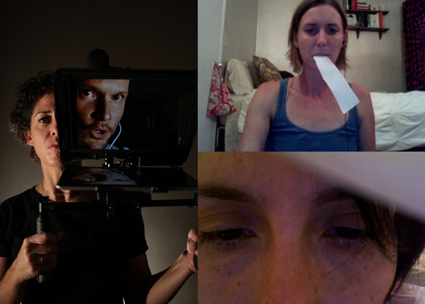
Hydra Poesis, PROMPTER, Jule Japhet Chiari, Brendan Ewing (on computer monitor), Allison Wyper (USA), Marcela Fuentes (Argentina), courtesy the artists
Keeping abreast of the vanguard of performing arts must be akin to trying to catch some mythical beast that keeps changing form. Arts House in North Melbourne might primarily be a live performance venue but in recent years alone that brief has swollen to include film and new media, interactive sculpture, sound art and installation. “The classifications are only as useful as you want to make them, and they should always be imploding and exploding,” says Arts House creative producer Angharad Wynne-Jones.
“Rather than be definitive about the form I think it’s really about the experience that we’re looking to create, an opportunity for the audience member to engage extremely strongly with a performative experience. That sense of event and adventure is what we’re looking for, really.”
In recent years this quest has seen Arts House help launch the hugely rewarding biennial festival of contemporary dance, Dance Massive, and plans are underway to create a similar festival of live art in 2014 (if successful, the two festivals will alternate yearly). The very notion of a live art festival would have been unthinkable only a few years ago, but its possibility is testament to the kind of work that Arts House has consistently introduced to audiences, and the willingness of those audiences to come back for more.
Arts House’s second season for 2013 is as diverse as expected. This year Wynne-Jones has been looking “up and around” and many of the entries arrive from outside Victoria. Several have enjoyed seasons interstate: Belvoir and Roslyn Oades’ I’m Your Man and Branch Nebula, Matt Prest and Clare Britton’s Whelping Box, for instance (both NSW), while Hydrapoesis’ PROMPTER hails from Perth.
Others have played elsewhere but have further evolved since premiering. The Hanging of Jean Lee, Andrée Greenwell, Jordie Albiston and Abe Pogos’ song cycle based on the last woman to be subjected to capital punishment in Melbourne, has been presented in concert form in Sydney, while ILBIJERRI, Belvoir and version 1.0’s Beautiful One Day has grown from its original incarnation up north. “So much work in Australia gets its one go,” says Wynne-Jones, but this doesn’t allow for the fact that the most urgent contemporary work can change as rapidly as the climate to which it responds.
The new season also features a number of world premieres. Stephanie Lake and Robin Fox will be presenting A Small Prometheus as part of the Melbourne Festival, the work combining contemporary dance with flame and sound experiments. “(Fox) is making kinetic sculptures that are moved by flame,” says Wynne-Jones, “(employing the) principle of heat moving a kinetic sculpture and then, at the same time, the soundwaves extinguishing some of that flame. So Fox’s is an extremely conceptual investigation into those kinds of physical laws. And then Stephanie will be interpreting and colliding with some of that information with her five amazing dancers.”
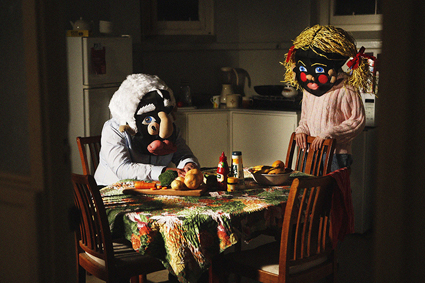
Side Pony, The Confidence Man
courtesy the artists
Side Pony, The Confidence Man
Side Pony’s The Confidence Man is harder to describe. Writer-director Zoe Pepper calls it an “interactive audio work” in which a drama is played out by audience members equipped with headsets and dressed in gigantic hand-crafted masks. It’s an attempt to create an interactive work that still doesn’t dispense with the complexities of storytelling in favour of gadgetry.
“It feels like it’s very much on-trend to create interdisciplinary, interactive work,” says Pepper. “I’d seen a lot of work that was more about the technology than it was about the story, so I wanted to make a work in that style but to focus on the elements that are key to my other work, which is still driven by plot. And to create a style of audience interaction that gave the audience member an anonymity and permission to play, without any humiliation.”
“Zoe Pepper’s a really great director and writer,” says Wynne-Jones, “and she’ll be crafting something fairly extraordinary. There’s more and more interest in that notion of co-authoring a work with an audience, and certainly Confidence Man takes that to the nth degree.”
Every experience of The Confidence Man will differ. The audience members playing out the tale will each hear different audio, while a separate audience sitting outside of the playing space will be able to toggle between channels as they choose which of the scenes being presented simultaneously most piques their interest: “They effectively create their own story by choosing what they want to watch and what to omit,” says Pepper.
If replacing actors with audience members seems a risky proposition, Hydrapoesis’ PROMPTER will negotiate the equally dangerous territory of technology—as a crisis plays out on stage, artists from around the world will be streaming their own responses live as a kind of online chorus.
This work revolves around the ubiquitous teleprompter as a symbol of our age. A journalist accidentally finding himself in the middle of a fictional island as a disaster takes place must cover the event as it unfolds behind him by reading the words his producers back home provide. “So rather than reporting with his own eyes he literally has his back to the event the whole time,” says director Sam Fox, “and it’s that instantaneous reporting phenomenon where no one actually knows what’s happening and the producers are on the phones and the internet trying to find out what’s going down, and feeding him this stream of data.”
The work explores the double bind of empathy in a connected age: “Projecting yourself onto events and indulging in events far away,” says Fox. “In the central narrative we’re looking at the nature of stories and journalism and not having time, where we’ve accelerated to the point where we really can’t get faster than we are now, unless you’re getting predictive. But in the broader narrative we’re looking at what it means to be an international citizen, how we should be responding to international events, from an empathetic and political standpoint. And then I suppose there’s this implied question of acting on your local politics rather than the international, and whether they’re in conflict or not.”
Wynne-Jones is excited by the riskiness of both works. Of PROMPTER, she says “you can be scared of it or not, can’t you? [Sam Fox has] a number of strategies that will be integrating the fuck-ups as well, so it’s not designed to be seamless, but in the way that our experience of media is sometimes glitchy and [we get] only half the story.”
Full details on Arts House’s 2013 Season 2 are at artshouse.com.au.
RealTime issue #116 Aug-Sept 2013 pg. 38
© John Bailey; for permission to reproduce apply to realtime@realtimearts.net
“Q. How many feminists does it take to change a lightbulb? A. That’s not funny!” With this joke, curator Laura Castagnini presents the stereotype she wants to challenge in the exhibition BACKFLIP: Feminism and Humour in Contemporary Art. The four short performance pieces reviewed here were presented at the Margaret Lawrence Gallery on the closing night of the exhibition: a theatrical dialogue, a dance work, a performance lecture and a drag performance.
Castagnini may have done too good a job, because the broadness of BACKFLIP reveals the absurdity of the cliché. It is not that humorous feminist art is a rare beast, quite the contrary: both feminist and humorous contemporary art are huge, overlapping categories, and BACKFLIP amasses a great deal of art without ever quite answering the implicit question: as opposed to what? Without a clear distinction between art about women or gender and feminist art, or specifying the brand of humour on display, the performance pieces had therefore a sort of cataloguing purpose. I did not recognise a unifying theme in the evening, but a lot of ground was covered, resulting in a broad compilation of themes and styles.
The four performance pieces were diverse. What united them the most was possibly unintentional: a certain existential anxiety, an underlying forcefulness, as if coming from a struggle to be seen and heard. The works seemed largely stuck halfway between articulating a statement and merely articulating an existential claim: we are, we exist, hear this.
Mish Grigor’s performance lecture is a good illustration of this halfway-thereness despite, or even contrary to, the material of the work. Grigor, in shirt and trousers, with a fake beard, calmly delivers verbatim a rant by notorious right-wing American shock-jock Rush Limbaugh. The rant covers the damage that ‘feminazis’ wreak on American civilisation by demanding access to contraception, and ends with the highlight of a promise to pay for the feminazis to have safe sex if they promise to post the videos online. It is a singularly horrific thing to hear, not least in May 2013, when Julia Gillard is being barraged with the vilest misogynist abuse of her career, and many Australian women are spending their days in a state of ongoing shock. But Grigor subjects her material to so little critical or artistic force, it is so profoundly unclear what she wants to communicate, that the clearest and most energetic component of the performance remains Limbaugh’s misogynist statement. The atmosphere in the room remains anxiously charged, unresolved to the core. How this experience differs from exposing oneself to the daily attacks on Gillard in the media remains unanswered.
Atlanta Eke presented snippets of her dance performance Monster Body. A sequence of ordinary movement synchronised to otherworldly growls and shrieks—unfortunately, this time merely in a nude bodysuit—lost a lot of its primal weirdness under the bright lights of the gallery. Better located was her urinating vamp performance at the entrance to the gallery, on a little podium. Dancing, urinating and pouring sparkling wine over a pyramid of champagne glasses, surrounded with an audience already plied with the same sparkling drink, in the same glasses, Eke was the predatory, oversexed woman of music videos and television, selling us decadence and champagne and youth and a female body all in one disturbing, grotesque package. Eke, who has performed in conducive international environments, creates work with immense clarity and strength, despite working in an often inaccessible tradition of ‘hard’ performance. Where the other works—both performative and visual—frequently used ambiguity as a screen for their muddled thoughts, Eke demonstrated how to make a point elegantly and without too many rhetorical interjections.
I found the inclusion of Agent Cleave’s piece troubling, although the work itself was excellent. It is a perfect drag performance, lip-synched to “Where The Wild Roses Grow,” with Agent Cleave, an extraordinary gender-scrambling performer, inhabiting with equal ease the femininity of Kylie Minogue and the masculinity of Nick Cave. Through the song, Agent Cleave strips, revealing, under the mourning dress of a southern belle, a masculine body covered in bruises.
This was a performance full of pathos and beauty, but it was firmly situated at the alternative end of drag performance. I am not sure it belonged in the program, not because it was not feminist (all drag performance, ultimately, is) but because drag performance has its own commercial mainstream, its own complex subversive aesthetics, and is relatively under-represented in the official histories of Australian performance art (eg, Anne Marsh’s seminal overview of Australian performance art, Body and Self, does not mention it at all). Agent Cleave’s work, which sits rather close to the queer performance mainstream (Cleave has performed with Amanda Palmer and Peaches, and is a successful pole dancer) first needs to be appreciated as skilled, well executed drag—a performance genre much bigger than performance art—before it can be placed in a gallery. Presenting it in the context of ‘feminist humour’ is particularly problematic, because of the sincere pursuit of gender-scrambled beauty that is, perhaps, at the very core of the political project of queer performance, and very much of Agent Cleave.
A short dialogue between Zoe Dawson and Anna McCarthy, of feminist performance collective I’m Trying To Kiss You, most successfully resolved the tension between being something and meaning something. It is an excerpt of a longer work of theirs, a conversation between two ‘frenemies,’ in which two women sweetly duel, establishing which one is more successful on the planes of lifestyle and achievement—career, sex, relationships, looks—and papering over their fiercely aggressive competition with the evasive, syrupy language of chatter. The competition breaks into fits of abuse and graphic descriptions of erotic longing, exposing the seedy underbelly of communication anchored to the imperative of perpetual niceness. That it is explicitly set in the gallery event is a stroke of genius, exploding the whole event from the inside, like a suicide bombing. What remains is delicate, although descriptive: the ambiguities of female friendship, the psychological darkness of mandatory politeness.
Ultimately, I never felt I got the answer to my question: what is feminist performance? All performance made by women? About women? About gender? In drag? Is it humorous simply by virtue of not being angry? Now that it seems we finally have so much performance by women that it looks less like ‘women’s performance’ and more like just ‘performance,’ I am ready to start classifying it by subject matter rather than the sex of the author.
BACKFLIP: Humour and Feminism in Contemporary Art, performance evening and closing night, Margaret Lawrence Gallery, Melbourne, 23 May
RealTime issue #116 Aug-Sept 2013 pg. 37
© Jana Perkovic; for permission to reproduce apply to realtime@realtimearts.net
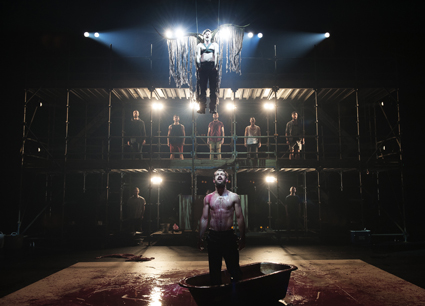
Sons of Sin, Danger Ensemble,
photo Morgan Roberts
Sons of Sin, Danger Ensemble,
Compare your last night of theatre with your first. Like internet dating, the consummation is the same, but the rules of engagement have changed. A decade of ‘independent seasons’ nested within our mainstages has littered the moat-like foyers of our state-funded theatres with couches, reshaped their intractable prosceniums into new configurations and collapsed many of the traditional artform hierarchies.
La Boite Indie Season
The La Boite Indie Season 2013 (parts 1 & 2) is illustrative: three mini-festivals across the year, each with multiple small shows, often playing simultaneously to tiny audiences, snaking through the La Boite complex into rehearsal rooms and out into the surrounding precinct.
Part 1 kicked off with The Séance by Melbourne-based company NO SHOW, one of those breathtakingly simple ideas that ought to have been done before. A dozen spectators cluster around a Ouija board with diva Sophie Webb. Tantalisingly, she is both our medium and the dead celebrity we are trying to reach. Spooky things, including some awkward audience participation, ensue and the show climaxes with Webb belting out Whitney Houston’s evergreen 90s pop standard “I will always love you” in her gorgeous contralto as she exits, lit by a bank of white lights. The natural performativity of the premise never quite lifts into genuine eeriness, I suspect because we are not seated around a table, eliminating many of the possible stage ‘tricks’ of a psychic. Instead, the piece is an exploration of fame and ambition, with a fairly traditional ‘stand and deliver’ performance mode, despite the potential of its intimate scale.
In contrast, This is Capital City strains at the edges of its own form to deliver a spectatorship that is driven by interiority. After instruction about your iPhone/headphone, you are led into the silky night of a Brisbane that has transformed itself into Capital City, a vista that is yours alone, marked by the techno-lullaby of the soundscape. You walk through bars and parks, following markers in the landscape and instructions from your virtual narrator, who becomes increasingly agitated and paranoid, as he cannot remember if he has committed a murder. At various points performers emerge. This is one of the most intriguing aspects of the show as the dialogue runs straight into your ears through the headsets while the performers engage in a looping dumb-show, precise and difficult as they cue their performance through your reactions. This reinforces the sense of control and destiny in the spectatorship as you investigate and re-image the familiar landscape through the noir and dystopian tropes of the plot.
Also deeply mediated by technology is Blindscape by Skye Gellmann and Kieran Law, an interactive circus work performed in the dark, with the audience using smartphones and a guided soundscape piped through headphones to navigate the wine-dark world. Again, a blinder of an idea, pardon the pun, but the compelling promise of all three works was never quite reached. Part 1 felt more like a creative development festival than a season, with each work just an iteration or two away from spectacular.
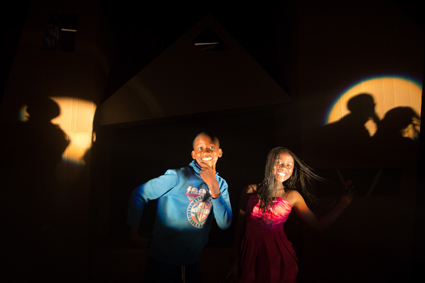
Joy Fear & Poetry, La Boite Indie 2013
photo Jason Boshler
Joy Fear & Poetry, La Boite Indie 2013
Part 2 was much more traditional, starting with Natasha Budd’s Joy Fear and Poetry where the 7-12-year old cast declare, “We are going to be the artists and you can be the kids.” Despite this rallying call, the work relies on tried and true montage drama favourites, with a mix of movement sequences, short scenes and personal stories, interspersed with drawings and reflections projected onto the gorgeous set, an architectural cardboard house with rhomboid dormer windows and matching screens on either side.
Part 2 finished with Tim Spencer’s Show me yours, I’ll show you mine, a clever and original exploration of contemporary Australian sex work. Literally just two performers, two chairs and a projector, the piece is structured around the six interviews that occurred (perhaps?) between an anonymous male sex worker ‘Not-Nick’ and the playwright/performer. The performance from Charles Purcell as ‘Not-Nick’ is disciplined and elegant; his controlled intensity gives Spencer’s witty and reflexive script its plausibility and tension.
Part 3 is yet to be announced, but one of the joys of the Indie this year has been the sense of risk-taking and experimentation, so I am expecting the unexpected.
Judith Wright Centre, Fresh Ground
Like La Boite Indie, the Fresh Ground Program at the Judith Wright Centre has been deconstructing its own institutional bulwarks with edgy programming, and it was also one of the first local spaces to fully embrace cabaret seating, with patrons free to move in and out of the space to buy drinks. Walking into the Danger Ensemble’s new work, Sons of Sin, I was struck by the warehouse formation, with five-storey scaffolding on one side of the empty theatre and, on the other, a beautifully framed white box, whose front side slides up to reveal a stage.
The Danger Ensemble’s visual and performatively charged works never fail to provoke and disturb and this show is no exception. With a cast of nine young alpha males (think the Brisbane equivalent of the cattle calls of Coppola for his movie The Outsiders) baring their souls, their cocks and their white-boy dance moves, it is a tour-de-force of masculine crisis. For women in the audience like myself, safely coupled in middle-aged suburbia, my response to the explicit content was maternal concern rather than horror, but I could see the sense of disquiet and genuine shock in many of the younger women.
The truth or dare format, where the show is structured by a set of over-sized cards laid out in a circle on the floor to trigger certain sequences (short scenes, monologues, improvisations and audience requests), gives the show an air of barely contained chaos that supports the thematic of the young men’s disintegration into alcohol-fuelled despair. However, it has been put together with a great deal of care. The set pieces, riffing off classical representations of masculinity that are presented on the ice white stage, anchor the free forming, roaming sequences on the floor. The scaffolding provides a frame for both the satirical pop culture montages and the final moments of the performance, where a tortured man-angel descends, Tony Kushner via Anne Bogart, our own little piece of New York City in downtown Brisbane.
La Boite Indie Part 1, This is Capital City created by Sandra Carluccio; NO SHOW (Mark Pritchard & Bridget Balodis), The Seance; Blindscape, by Skye Gellmann, Kieran Law, Thom Browning, Gareth Hart & Dylan Sale; 8-25 May; Indie Part 2: Joy, Fear and Poetry, Natasha Budd, 10-20 July; Tim Spencer, Show me yours, I’ll show you mine; La Boite, 10-27 July; Judith Wright Centre, Fresh Ground: The Danger Ensemble, Sons of Sin, director Steven Mitchell Wright, Performance Space, Judith Wright Centre, 7-25 May
RealTime issue #116 Aug-Sept 2013 pg. 39
© Kathryn Kelly; for permission to reproduce apply to realtime@realtimearts.net
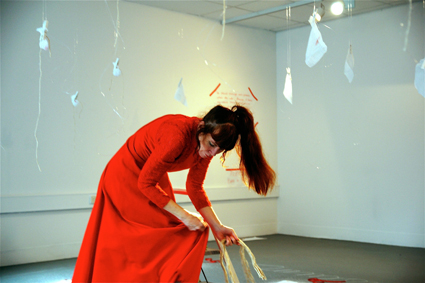
Julie Vulcan, Redress #6 Hinc Illae Lacrimae, or Hence Those Tears
photo Alan Warren
Julie Vulcan, Redress #6 Hinc Illae Lacrimae, or Hence Those Tears
Existence equals one white room, one mesmerised spectator and one flame-haired woman in a blood-red dress. Julie Vulcan’s Redress #6 was one of the exquisite durational live artworks showcased at exist-ence 5, a festival organised by the exist collective “to cultivate an open and visible platform for live art, action and performance arts through altruistic curation.”
This exist-ence is their fifth international festival in six years (2008-2013), the impressive program including a two-day Symposium in Brisbane and a program of performance events in Brisbane, Sydney and Melbourne. As Keith Gallasch noted in his preview in RT115, the exist-ence festival is “unique in terms of ambition, continuity and growing national and international scope.”
Live art demands body and flesh be witnessed and sometimes can be a mixed bag for spectators, but I had an absolute ball at the three-day Performance Festival because there was such a spirit of shambolic risk-taking and experimentation.
Live artists are not the contained and elegant greyhounds you see at so many art-show openings. As a tribe they remind me strongly of my own theatre muckers, ramshackle gypsies and shamanic chameleons, luminous with child-like curiosity. On the first night we all snuck into the printmakers’ opening night around the corridor at QCA where we quaffed free wine and ate expensive cheese before scarpering back for a tired but still crackerjack Labana Babylon, gyrating and prophesying via webcam from her bordello-like New York apartment.
That night ended on the moonlit quadrangle, where, between abutting concrete towers, Swedish artist Henrik Hedinge lay down on the grass in his green top and gold shorts (a nice touch I thought). With a motley crew of helpers he arranged large bamboo poles, which functioned as extensions of his prone body, making pleasing, slightly skewed, geometric patterns. This was an architectural body, but one augmented by wood rather than by techno-industrial material and therefore somehow more vulnerable in its irregularity.
Unlike other images in this series, Hedinge was not strapped into the bamboo extensions and there was an un-easiness watching the poles being moved, over there, here you go, no that isn’t right, try again. While this may have been a conscious strategy, the work lacked the sensitivity and layered detail of other documented images in this lying down series (see RT115, p23). However, images of the work taken on the night from the top of the large concrete towers showed that it was also a matter of scale and perspective. To fully appreciate the delicacy of the body in the flow of the wood extensions you needed to view, like Hedinge’s other documented images, from above and from a distance.
Grappling with body plasticity and mutation was also a theme of many of the local works including James Cunningham’s Antennae. Cunningham, bent double, had strapped to his back and arms bundles of black arcing plastic rods which made a quivering carapace over his body, dislodging ceiling tiles and scaling the floors. The act of standing up took Cunningham a gripping 20 minutes as he manipulated body and carapace, delicately choosing particular angles that would allow freedom of movement for both. In contrast, Karike Ashworth and Anja Homburg chose domestic materials, ribbons and strings, and offered their bodies for us to decorate. While the scissors and other implements looked the most dangerous, the fiercest provocation came from august live artist AñA Wojak who took one of the young women’s hair and plaited it, in full tension, to the back of spectator Henrik Hedinge’s fashionably asymmetrical quiff, a Rapunzel knot, its tension electrifying the sense of time and feminist discourse in the piece.
But I must confess that I was captured, like a rabbit in headlights by Redress #6 Hinc Illae Lacrimae, or Hence Those Tears. Julie Vulcan has a long career as both a solo artist and as part of the Unreasonable Adults and the Frumpus collectives.
This work explored the politics of standing, as protest and as subjugation, perhaps to domesticity, or obsession or even to the act of creation. The standing was interspersed with intense routine, marked by Vulcan’s iPhone timer: task, alarm, re-set, standing, alarm, re-set, task. There were occasional breaks to this extraordinary rhythm, like a long, slow walk through the rocky garden outside the window of the small white room. But the work built its intensity from the dignity given to this slowing and structuring of time through task. A long muslin sheet was kissed and cut and each piece laid on the floor in precise rows. Salt was poured in a long stream, pooling next to each of the muslin pieces and then kissed by Vulcan. Each sheet was wrapped in ice and hung, crying into the salt faces in the floor that echoed the broad and generous curves of the performer’s lips and nose. Hence those tears. The strain was evident, but Vulcan’s absolute commitment made the room like a church, alive with contemplation and shared grace.
My journey at exist-ence ended rather fortuitously with an engaging young animateur, Jamie Lewis, whose piece, untitled, involved a bbq chat filmed while she made us sambal and egg sandwiches on glowing white bread, a sneaky Singaporean comfort food that brokered conversations about place, identity and chili. I wondered about the recording though, sensing a further stage to the work yet to be revealed.
Commendation must go to the tireless and graceful co-curators Rebecca Clunn-Cunningham and Nicola Morton who were there seemingly all day and night, soothing young artists and endlessly resetting the small rooms or outdoor spaces for the next performance. Scuttlebutt around town was that Julie Vulcan had been censored with posters being put up on the glass walls to prevent her breasts being seen by the public when she took her dress off to write on her back with red pen. I’m not sure if this is in any way true, but to my mind, the whiff of indignation it implies is the ultimate accolade for this subversive artform and a tribute to this gathering of true believers.
exist-ence 5, festival of live art, performance art and action art, QCA Project Gallery, Brisbane, 17-30 June
See also Keith Gallasch’s account performances in the Sydney leg of exist ence 5 at PACT.
RealTime issue #116 Aug-Sept 2013 pg. 40
© Kathryn Kelly; for permission to reproduce apply to realtime@realtimearts.net
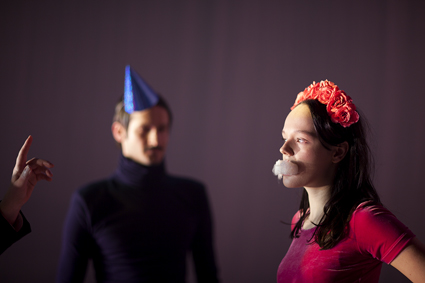
Emily Milledge, Pier Carthew, Story of O, The Rabble, Neon
photo Guy Little
Emily Milledge, Pier Carthew, Story of O, The Rabble, Neon
Critics lamenting the conservatism of Australia’s mainstages will often end their complaint with a shrug and a dark comment about how their audiences will all be dead soon, anyhow. Ageing subscriber bases can only be played to for so long, goes the logic, and sooner or later a more progressive—read younger—audience will have to be found. It’s a Pollyanna-ish suggestion, I think. It equates youth with experiment, risk, innovation, when of course a young audience can be just as reactionary as any other. But more importantly, it ignores the structural conservatism of large companies that need to appeal to a broad base, that rely on familiarity as a marketing tool and that by necessity must at least in part consider a play as a product.
This is one of the reasons why Melbourne Theatre Company’s recent NEON season of independent theatre was met with such welcome. It’s not just that the works produced were radically unlike anything the MTC typically programs (though they were). It’s that these works really were afforded an astonishing degree of independence within the structures of the institution—they weren’t teased and cajoled from above into something they weren’t, or subjected to review and reform by outside eyes. Each of the five companies given a spot in the season was trusted to produce something that wouldn’t bring down the MTC’s walls, and the outcome taken as a whole was one of the most exciting developments in Melbourne’s theatre scene in living memory.
The Rabble, Story of O
It’s odd to remember that all of the works in NEON were inspired by somewhat canonical texts or writings by playwrights who wouldn’t be out of place on a mainstage—Tennessee Williams, Frank Wedekind—given that what we saw in every case was so far from a ‘play.’ The most striking response to a written classic was The Rabble’s Story of O. The company has in the past had much success turning novels into live works, but to use the word ‘adaptation’ in these instances would be a mistake. If theatre, as it’s often said, is a living thing, then The Rabble treats any narrative in the same manner, and their work is a violent wrestling match with the seething, squirming being that is a story.
To faithfully adapt Anne Desclos’ pseudonymously published erotic novel would be a fool’s mission, in any case. The story follows a woman willingly entering into a state of sexual slavery at the behest of her lover, who introduces her to a mysterious world of submission, violence and humiliation. The short work was written as a kind of love letter to Desclos’ partner, himself fascinated by the writings of the Marquis de Sade, and Desclos made clear that the events it describes exist as pure fantasy, with no base in the waking world. It is this, as much as the abjection of the acts it depicts, that makes a stage adaptation seem close to impossible—The Story of O’s power comes in the electric arc that is sparked when words are divorced from their referents.
The Rabble’s Story of O handles this problem with brio. From the outset we’re reminded that words are themselves a weapon. Jane Montgomery Griffiths as the sadistic Sir Stephen lectures the audience on the Lacanian notion of language as phallic tool, with a nod to Susan Sontag’s essay on Story of O which applies the same reading, and from here on the disjunct between the symbolic world of words and the materiality of the body becomes deeply problematised. O desires to become nothing, pure object, no ego, but when this is played out by live actors the pure fantasy of self-annihilation loses the sense of transcendence the original novel gives it and proves a far messier fact.
Mary Helen Sassman is a fascinating O. Almost silent throughout—apart from a genuinely shocking moment of spoken refusal—she somehow becomes more real, more situated as the rituals through which her character suffers become more outlandish. The figures who surround her are just as jarring: Dana Miltins plays Jacqueline, the model O in turn inducts into the cycle of submission, but is herself seven months pregnant, bringing to the role a surfeit of life in a climate of suspended death; Griffiths’ Sir Stephen is both the architect of O’s dissolution and a curious absence of character in her own right.
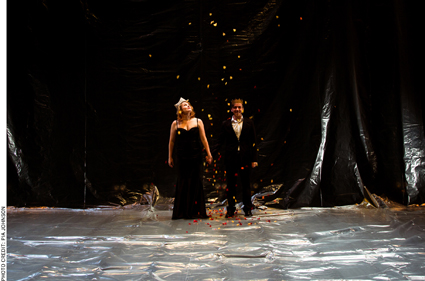
The Hayloft Project, By Their Own Hands, Neon
photo Pia Johnson
The Hayloft Project, By Their Own Hands, Neon
Hayloft Project, By Their Own Hands
The Hayloft Project’s By Their Own Hands is just as much concerned with absence and presence—here, it is the story of Oedipus and Jocasta that is subject to a kind of inversion. That which could never be shown onstage in the Greek tragedies is laid bare, while the lofty power of the spoken utterance is gradually eroded from within.
The work is divided into three parts, each employing a different theatrical language. The first is a genial piece of storytelling in which the events of Oedipus Rex are related to the audience by the two performers, Benedict Hardie and Anne-Louise Sarks (featured in Women + Performance 2). There’s no acting, per se, and setting and character are summoned by the viewer’s imagination. It’s an amiable (if extended) sequence that’s a contrast to the terrible tale it describes.
The second sequence traces the same story through a series of stark, almost silent images, returning to the stage the terrible visions of sex and death that underscore the drama. This is the stuff that words alone cannot conjure, but in their sheer materiality neither can they be integrated into narrative, which after all works to order, to make sense of such things.
The final sequence is something other—a series of short, intimate conversations between Oedipus and Jocasta that eschew both the sense-making narration of the first third and the world-destroying spectacle of the second. It’s a clever kind of theatrical dialecticism, and one that doesn’t entirely satisfy since it seeks to open up cracks in that most familiar of stories rather than seal them up.
These are only two of NEON’s first series of excursions, but they’re a ways from anything an audience expects of the MTC. If there’s a more potent argument for the continued programming of such a bold experiment, I’d like to see it.
See Jana Perkovic’s review of Daniel Schlusser Ensemble’s Menagerie, also in the NEON season, in RealTime 115.
Melbourne Theatre Company, NEON: The Rabble, Story of O, after Pauline Reage, creators Emma Valente, Kate Davis,director Emma Valente, designer Kate Davis, 27 June-7 July; The Hayloft Project, By Their Own Hands, directors, performers Benedict Hardie, Anne-Louise Sarks, design Marg Horwell, lighting Matt Scott, composition Kelly Ryall, dramaturgy Carl Nilsson-Polias,13-23 June; The Lawler, Southbank Theatre
RealTime issue #116 Aug-Sept 2013 pg. 41
© John Bailey; for permission to reproduce apply to realtime@realtimearts.net
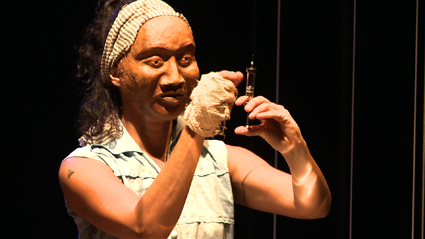
Contagion’s Kiss, Business Unusual
photo Tim Wood
Contagion’s Kiss, Business Unusual
Delicately combining some of the darkest elements of the nation’s history, Contagion’s Kiss is a haunting and poignant piece of theatre that transports you to a world of isolation and hardship, yet also of love and hope. The first all-mask collaboration of Nicola Fearn and Sarah Cathcart of Business Unusual, Contagion’s Kiss pulls you into the silent world of the voiceless.
The performance is set in the 1940s on Channel Island, a leprosarium off the coast of Darwin, its inhabitants (95% Indigenous) forcibly removed from the mainland and made to live in quarantine. It follows the interwoven journeys of three distinct characters: a privileged, teenage white girl, about to embark on a musical scholarship in Sydney, before being diagnosed with leprosy; a young Indigenous female leper who assists the doctor in administering treatment; and an old, well-educated white man who writes reams of cranky yet humorous letters to newspapers in the hope of improving conditions on the island and alerting people to the inmates’ plight: “Please send a large teapot, preferably blue, to complement our mood.”
Set in a time when white ‘protectors’ determined Aboriginal people’s fates and their mixed blood children were forcibly removed, Contagion’s Kiss is a work of fiction based on true events and characters.
By using the effortlessly symbolic historical setting of the Channel Island Leprosarium, Fearn and Cathcart are able to depict the darkest afflictions of society at the time. Away from family, young girls’ fingers fester, white doctors try to ‘breed out the black.’
Sarah Cathcart’s direction assures that all the components of Contagions Kiss run together effortlessly, expertly balancing the humour, pathos and tragedy of the characters’ lives. Performers Fearn, Samantha Chalmers and Conor Fox convincingly convey their characters through adroit physicality and gesture, quickly discarding any audience preconceptions that mask might hinder expressiveness. Chalmers’ depiction of Pearl is so communicative that it is almost shocking when she finally does remove her mask for the curtain call.
The set, designed by Marg Howell, is a piece of art. Literally. Over a hundred rocks hang suspended from the ceiling on fine string, hovering a metre off the ground and almost filling the entire stage. A well-executed exercise in negative space, the set provides both a symbolic obstruction and a palpable emptiness. Each rock hangs alone and lonely, a symbol of suspended lives, a visceral response to isolation, barrenness and barriers—of communication, disease and race.
The characters constantly try to navigate around and through these barriers, and it is not until the sudden appearance of a threat to all of society that they collide—the rocks swing and crash together as the sound of a foreign air attack rings out over the harbour.
Conor Fox’s beautifully rendered puppets and puppetry allow us to witness painful scenes through a dreamlike and distant lens. Strings of Aboriginal people are rounded up in chains and led to the Island, a dying inmate unravels to fly skywards and illuminated huts dot the lonely landscape. Rebecca Adams’ moody and evocative lighting design brings these sequences to life.
Mask and puppetry are complemented by Elka Kerkhofs’ animations that creep through the strings of the suspended rocks to flicker on a screen over a line of crosses at the back of the stage.
Kerkhofs’ visuals and animations are clever and affecting: medieval depictions of plague doctors and anatomy charts, night skies, falling rain and text directly drawn from actual letters or newspaper articles of the day.
Composer and musician Biddy Connor accompanies the piece throughout on piano, violin and, uniquely, the saw. Her score is exemplary and adds an emotional and mesmerising depth to the performance.
Contagion’s Kiss is a clever, unusual and beautiful piece of theatre whose dark historical truths still have resonance today.
Business Unusual & Brown’s Mart Theatre: Contagion’s Kiss, co-writer, creative producer, performer Nicola Fearn, director, co-writer Sarah Cathcart, Brown’s Mart Theatre, Darwin 4-16 June
RealTime issue #116 Aug-Sept 2013 pg. 42
© Gail Evans; for permission to reproduce apply to realtime@realtimearts.net
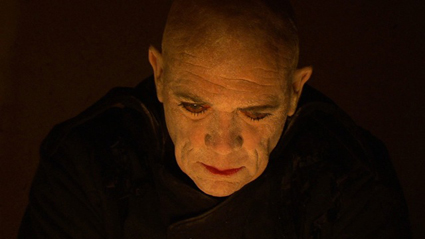
OzFrank Theatre Film, The Castle of Macbeth’s Head
Since 1992 Jacqui Carroll and John Nobbs’ OzFrank Theatre has created performances “which combine Australian form and content with Asian sensibilities and integrity of purpose to produce a Japan/Australian fusion theatre” (website). Drawing on their dance backgrounds, Carroll’s choreographic and directing skills and Nobbs’ design and performance expertise they have created visceral performances seen around the world—from Queensland to Japan and Turkey.
Carroll and Nobbs have now turned their attention from live performance to making films but, drawing on their considerable repertoire, steadfastly maintain their performative principles. Their first is a feature length film based on Macbeth titled The Castle of Macbeth’s Head—more than a hint that the approach will be emphatically psychological, but doubtless with OzFrank’s inherent physicality.
Nobbs tells us that their Macbeth has been in the OzFrank repertoire since 1995: “We’ve travelled all over the world with it—to Nepal, Mongolia, Croatia, all sorts of places. All our other productions have been filmed but we’ve never had much footage of Macbeth so we decided to film it and then to go a bit further and make a feature film out of it. It was originally about 65 minutes but obviously in film you have to introduce things you don’t need to do onstage, so we added another 20 minutes of intermediary scenes.” When Carroll first directed it she stripped it back, focusing on the key psychological moments: “Macbeth has 11 or 12 of probably the best speeches Shakespeare ever wrote.”
Carroll wanted to film in the corridors of a castle, “So we made the set out of a series of moveable panels—basically plastic sprayed with paint and cement to represent a castle’s inner walls. There are no set battle scenes or anything like that. Jacqui just wanted to concentrate what is actually happening inside Macbeth’s head.” Intensifying this is the transformation of the witches into the murderers, Lady Macbeth’s nurse and the doctor, suggesting that they’re projections from Macbeth’s troubled psyche. “It’s the ambiguity,” says Nobbs, “about what’s stimulated by Macbeth’s mind and by, shall we say, outside or supernatural forces. This approach enabled us to shoot relatively cheaply. David Granato (Polygranate Films) has filmed a lot of our work in the past. This is his film really: he’s the director, Jacqui is the producer. It’s a combination of Jacqui’s vision and David’s technical ability to film our vision of the play.”
In the transition from stage to film Nobbs says, “we’ve realised that rather than competing with cinema we’re actually creating very powerful, almost fantasy-like designs and filming them. To say it’s theatre film is probably better than to say it’s film.” It’s also brought a focus on powerful stillness, already evident in the stage performances: “it enables a lot of close-ups. You can sit on the eyes in much the same way as, say, Sergio Leone did in Once Upon A Time In The West. There’s also the distillation of the voice into something that’s much quieter than on stage. And the film shows the impact of the training itself; it demonstrates its universality. While Suzuki is often seen as having some Samurai/Kung Fu aesthetic, that’s a misinterpretation as far as we’re concerned. The film will be very quiet; not at all histrionic.”
Nobbs and Carroll are enjoying the move into film and are “already embarking on a version of Oedipus after finishing The Loves of Don Perlimplin, a lesser-known chamber piece by Lorca. I play Perlimplin but you never see me. I’ve got the camera on my chest. It’s a home-made steadicam (‘chestycam’ I call it) exploring what point of view means and the ways you can cut and edit.”
With documentation of 21 of their works on film and on video, mostly sold internationally through Artfilms, Carroll and Nobbs are now creating a new niche for the expression of their vision and its aesthetic, a fascinating hybrid—theatre-film—which will further their legacy and generate works to come. The film’s launch will be mc’d by Queensland Theatre Company Artistic Director Wesley Enoch. RT
OzFrank Theatre Film and Polygranate Films, The Castle of Macbeth’s Head, Gala Preview, QTC, Brisbane, 27 August; www.ozfrank.com
RealTime issue #116 Aug-Sept 2013 pg. 42
© RealTime ; for permission to reproduce apply to realtime@realtimearts.net
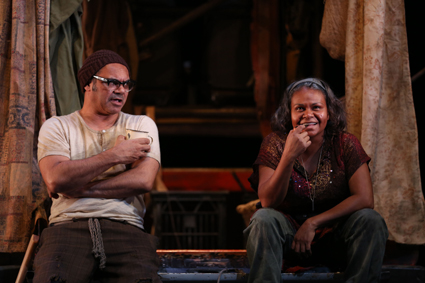
David Page, Ursula Yovich, Mother Courage and Her Children, QTC
photo Rob MacColl
David Page, Ursula Yovich, Mother Courage and Her Children, QTC
During a month in which The Australian’s Rosemary Neill instigated a media skirmish centring on the proliferation of adaptations of canonical European texts on the nation’s mainstages, Queensland Theatre Company premiered an all-Indigenous production of Bertolt Brecht’s Mother Courage and Her Children. Avoiding the brouhaha surrounding the work of ‘auteur directors’ in Neill’s articles, where the original writer’s name disappears from the playbill altogether, Queensland Theatre Company was very careful to name this as Brecht’s play, and Paula Nazarski and Wesley Enoch its translators.
As a translation (into contemporary Aboriginal English, utilising south-east Queensland slang and lingo), the script gleams. It is a crisp and aggressive kriol metamorphosis of Brecht’s text in which language goes a long way to establishing mise en scène; it is also wickedly humorous and had the substantial number of Indigenous opening night audience members responding with emphatic approval. Mother Courage hauls her wagon—a converted (was it a Holden?) ute—around a sparse outback stage, traversing mining camps and the occasional Centrelink office. Christina Smith’s set design is beautifully evocative of the Australian land (and office) scape. Ben Hughes’ compelling lighting designs give us the red dirt and the starry nights, while Smith’s corrugated iron draping gives us the outback, or the simple stunning line of lurid green plastic chairs the unemployment office.
Enoch, who also directed the play, explains its transposition to a slightly futuristic (Mad Max-esque) regional Australia: “[Brecht] uses the 30 years war that swept Europe in the 17th century to discuss the rise of National Socialism in pre-war Germany. In this production we use Brecht’s characters and situations to suggest the relationship between First Nations Peoples and mining…asking ourselves what is the ‘war’ for contemporary Aboriginal people, and we came upon the idea that the greatest issue of contention for us is—do we engage in mining or not?” (Director’s Note, program). The production is more than a translation, then—it’s an adaptation of Brecht’s text from one specific cultural and political context to another, and it is in this yoking of the text to the Aboriginal/Mining question that I’m not convinced the piece has quite landed yet.
Ursula Yovich leads a well-directed, capable and confident cast. Her astute, grounded performance is a wonderful achievement, commandeering as it does the difficult emotional arc of this big didactic play. During the final John Rodgers’ bluesy musical numbers (the Bossman reprieve) the play’s thesis is (I would argue belatedly) articulated:
There’s luck and there’s skills
When a war drags on you have nothing to rely on but your wits
This war could keep going on for 225 years more
And we mob would still not get anything more than we have now
They take what they want and you have to find a way to survive.
I say take their money and live a life that’s full.
Even if they steal your wages, and take away your kids and take away your Land
You gotta keep dreaming it’s gonna get better.
I have always read Courage as a mercenary who has, at the end of the day, sacrificed principle for the dollar. She is self-professedly pro-war. She is financially dependent upon it and there is not much honour in that reliance. Here Nazarski and Enoch seem to be moulding her into a hero who is emblematic of the First Nations People’s survival and endurance. They are having it both ways, in a sense, and this revelation of her as both pragmatist/mercenary and idealist/champion felt a bit too neat or ad hoc—at odds with her depiction elsewhere in the text. That dramaturgical criticism aside, this is an ambitious production that largely succeeds and will rightly be studied on secondary schools’ drama curricula for years to come.
QTC, Mother Courage and Her Children, writer Bertolt Brecht, translation Wesley Enoch and Paula Nazarski, director Wesley Enoch. QTC, QPAC 25 May-16 June 2013
RealTime issue #116 Aug-Sept 2013 pg. 44
© Stephen Carleton; for permission to reproduce apply to realtime@realtimearts.net
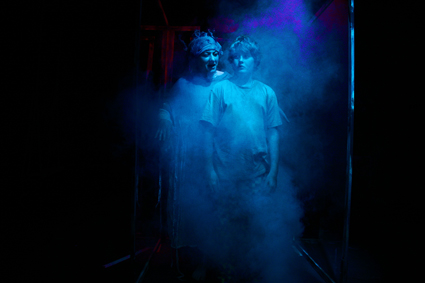
Lieder Theatre, Comin’ Home Soon
At Goulburn’s Lieder Theatre in regional New South Wales on a cold May night I see a verbatim theatre work, Comin’ Home Soon, created from workshops and interviews with prisoners and their families.
Operating continuously in Goulburn since 1891, this regional community theatre is almost as old as the gaol, if not its penal history. In 1884, a massive hand-carved sandstone prison gate and façade designed by colonial architect James Barnet was completed. Such impressive architecture replaced Goulburn’s earliest buildings, a lock-up (1829) and a gibbet (1832), and today it is part of the architecture of surveillance and incarceration of Goulburn Correctional Centre, Australia’s highest security prison. Coming into Goulburn from the north, you can’t miss it—bleak and exposed.
The staging is harsh, defined by an oblique back wall, rough-painted grey, red-streaked, an endlessly receding infinity punctured by four window-sized squares and graffitied with hundreds of counted-off days. High on the proscenium, clocks are painted, dotted—doin’ time Indigenous way?
White light evoking searchlights creates a powerful chiaroscuro of four kids playing cops and robbers. As they squabble about what their dads did and why they were caught, five teenagers walk slowly across the stage behind them. The game gets too hard, the kids give up and exit to their Playstations. More performers enter, adopting curious flower poses for a poetic chorus that contrasts floral images with the harsh life and regime of the prison. Four men enter and address us, recounting experiences of making phone calls from inside. Momentarily there are 17 people on stage.
A series of intersecting games and interactions unfolds between prisoners, their children and the people who work with them. Children contend with each other, absent parents, anger, shame, social workers, prison transport workers and guards. Prisoners describe darker games of secrecy in negotiating incarceration; a father can only speak to his reluctant child through Grizz, a soft toy. We hear promises, lost promises, the elusive promise of the title. Some games loosen up and flow but just as often paralysis takes hold of characters struggling to communicate, as prison life imposes an implacable social straitjacket. How does a long-term inmate relate to his daughter’s account of going to see Lady Gaga?
Alana Valentine’s script structures dense layers of verbatim material by constantly intercutting five defined ‘states.’ The sometimes earnest and awkward delivery by these community actors heightens the sense of authenticity in their performances. Darkly costumed in a monochrome world of grey and black, they criss-cross diagonally between ‘states’ and narrative strands. As ‘states’ shift, the work drives forward. The chords, discordant sound and sustained notes of the score hold the tension throughout, driving the oblique and unsentimental emotional tenor of the work.
The four windows puncturing the back wall open in sequence as prisoners address the audience directly. A slippery dip and swing are play sites, entry and exit points. Mobile frames become X-Ray machine gates. In the only scenes to use colour Nervous Nathan’s fears are physicalised in a fantastical and surreal series of interludes with Gymea lilies called Lillianspooks, a frill-necked lizard and blue-and-white mist.
In a short ‘state’ with didjeridu—a reference to the over-representation of Indigenous people in Australian prisons—the four inmates talk of encountering their Aboriginal culture while in prison and of hunger for ceremony, initiation, language, lore. They speak of regrets for ignoring culture and old people in their youth as they tried to live ‘white-fella way.’ A woman speaks to children about reading Aboriginal painting. So much hangs unsaid. The final scene, a game like Statues, draws all 17 performers into trying their luck at winning—at Comin’ Home Soon.
The play is raw, a first draft followed by one reading and a rewrite. It is intelligent, well-crafted work, emphatic in its clarity, integrity and passionate sense of necessity. The direction, design and sound are sophisticated and the commitment and performances of the ensemble impress. Seven cast members identify as Bundjalung, Wiradjuri, Darug or Bidgigal; five are performing with Lieder for the first time; all are volunteers and locals, visibly determined that their story be heard and seen locally, making the invisible visible. This is the legacy of this community, Lieder Theatre and artistic director Chrisjohn Hancock.
Goulburn jail is harsh, surveillance is constant and punitive but Comin’ Home Soon and the extraordinary local participation undercut that sense of it by reminding us of the humanity of the people incarcerated within its walls.
Lieder Theatre, Comin’ Home Soon, writer Alana Valentine, director, designer, lighting Chrisjohn Hancock, commissioned by Goulburn Regional Art Gallery; Lieder Theatre, Goulburn, NSW, 26 April-11 May
RealTime issue #116 Aug-Sept 2013 pg. 44
© Annemaree Dalziel; for permission to reproduce apply to realtime@realtimearts.net
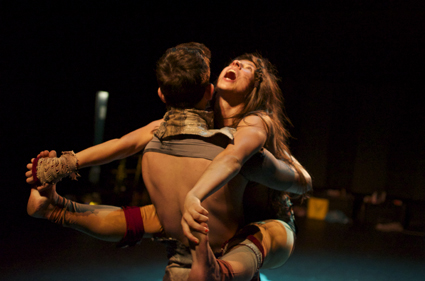
Alexander Baden-Bryce, Lucy Ingham, Phluxus2 Dance Collective
courtesy the artists
Alexander Baden-Bryce, Lucy Ingham, Phluxus2 Dance Collective
With recent global weather events and CO2 in the climate over the 400 parts per million threshold, it’s easy to understand why the paradise-lost motif has inspired choreographer Nerida Matthaei’s de-generator. As she states, it’s a response to the global obsession with the end of the world, and her firm belief that it is the destructive nature of humanity that holds the highest probability of ending our existence.
A dimly lit theatre, chairs retracted. In one half of the space, three large-scale tree-like installations comprising strong lines of black duct tape; in the other a series of illuminated collections, small heaps of outmoded technologies, plastic water bottles, torches, gas masks and such, some mounted and slung on rustic bamboo racks; the space divided by an obtrusive, jagged diagonal line, like a great primordial crack in the earth.
The de-generator narrative finds a man and woman (Alexander Baden Bryce and Lucy Ingham) discordant, infested and alone in their existence. Two solos, one after the other, enlist a language of angular, shaking, primal movement in an intersection with refined balletic control. Groping the darkness, themselves and the audience, who are free-standing in the space, the duo come to terms with their ominous world. An unfamiliar meeting of intricate and dynamic composition sees the male outsmarted and lying on the floor. Bathing him from feet to head, the woman revives the man, and the pair lyrically reconcile. Together they travel through the landscape, where she reveals her collections to him. The journey ends in a particularly lovely moment where, cradled, her hair extends like an extra limb. The work’s last moments are danced in unison, followed by a barrage of topical media sound bites describing catastrophic natural disasters and nuclear war as the silhouetted couple stand hand-in-hand in prophetic revelation.
I sense that de-generator’s intention is to startle. The inevitable examination of mortality is an attempt to portray the gravity of our current situation, and the work’s foregone tone of desolation embellishes this subtext, reinforcing it through the choreographic form. Giddying twists, spirals and extensions, sweaty limbs entwining and snapshot partnered lifts revealed a flexibility in which the intent, if physically possible, would have been to turn the body inside out.
Bleak, stark, abrasive lighting, high-key sound and post-punk-feral aesthetic couture augment the imagined catastrophe and nihilism. Was it misanthropic or merely reflecting on the helplessness of humans in a circumstance that eclipses them? Rendering it as a non-proscenium work meant that it lent itself to either interpretation, as the audience, like marsupials caught in high-beam headlights, were sent scurrying from the dancers. Some stood their ground, but as the work progressed and the dancers became space eaters, a psychology of survival seemed evident, the dancers taking over the centre space and observers gravitating to the sides of the room.
De-generator seeks out our innermost fears in an attempt to observe anxiety over events in which we have little control. Despite this, in the act of sharing her anxiety and having the dancers complete the work hand-in-hand, Nerida Matthaei aims perhaps to bring us all together.
Phluxus2 Dance Collective: de-generator, choreographer Nerida Matthaei, dancers, set and costumes Lisa Fa’alafi, sound Andrew Mills, lighting Keith Clark; Cairns Centre of Contemporary Arts, 22-25 May
RealTime issue #116 Aug-Sept 2013 pg. 46
© Rebecca Youdell; for permission to reproduce apply to realtime@realtimearts.net
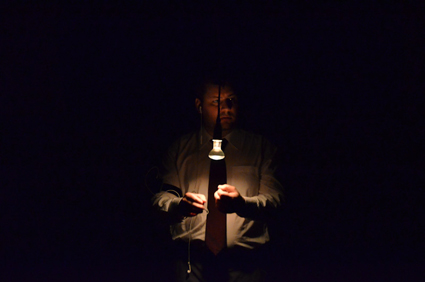
David Williams, Open Your Mouth and Let Words Fall Out
Jennifer Greer Holmes and Heath Britton
David Williams, Open Your Mouth and Let Words Fall Out
Now in its fourth year, the nationally situated ‘hothouse’ Adhocracy continues to bring together South Australian and interstate interdisciplinary artists to explore untested ideas through workshops, talks and work-in-progress showings. The proceedings take place over the three-day Queen’s Birthday weekend at Port Adelaide’s Waterside Workers Hall, the hub of innovative production and performance company Vitalstatistix.
Artists set up and perform in every part of the heritage-listed building from the cavernous main hall to the claustrophobic supper room, their disparate performative entities embryonically grappling with the hopes and anxieties of now: democracy, human rights, corruption, post-industrialisation. Almost all of the works propose questions about the nature of truth in an increasingly illusory world.
In Open Your Mouth and Let Words Fall Out, version 1.0 co-founder David Williams appropriates the bizarre real life testimony of con artist Gerald Carroll to create a nonsensical verbatim monologue. An earpiece feeds him questions from the Commissioner of the anti-corruption operation Atlas. We cannot hear the questions, but we can both hear and witness Carroll’s literally flailing responses. Hounded from above by an elaborate pulley system from which hang half a dozen or so light globes, Williams ducks, weaves and shadowboxes in a breathless physicalisation of the arts of equivocation and deception.
The telling, and not telling, of politically pertinent truths is also central to Love and Boats, an exploration of refugee rights and asylum seeking. Still in its infancy, Love and Boats sees two artists (Karen Therese and Boris Morris Bagattini) and one Human Rights lawyer (Joe Tan) begin an unconstrained conversation about the intersections which characterise the immigrant experience: love and law, freedom and oppression, integration and isolationism. It is unclear what shape or form any finished work may take, but the trio’s use of Skype points towards a mediatised and internationalised response. The showing is framed by impeccable legalese and performance theory, but Love and Boats’ messiness and unfocused passion seem to get closer to the essential, obscured truths at its heart.
Taking its name from a notoriously desperate stunt to reinvigorate flagging sitcom Happy Days, Malcolm Whittaker’s Jumping the Shark Fantastic is an irony-rich attempt to give audiences what they want. It is a ‘residency model’ in which Whittaker presents the results of two days of research within the Port Adelaide community into what both theatre makers and theatre goers want their ideal show to look like, sound like, feel like. The results, which Whittaker presents as a sort of stream-of-consciousness lecture while dressed in a bear costume, are predictably absurd, underscoring the illusion which lies at the heart of our democratic processes: that everyone can get what they want all of the time.
Taking place behind the curtain of the Waterside Stage is Bron Batten’s Use Your Illusion, an investigation into hypnotism and performance drawing on the performer’s collaboration with a clinical hypnotist. Influenced by a recent residency with Chicago Theatre Company The Neo Futurists, it is Batten’s contention that acting is innately fraudulent, and hypnotism one possible pathway to ‘truthful’ performance. There is a tension present in the showing between the application of hypnosis as a clinical tool, and its chintzy appropriation as spectacle by the show business industry. Batten investigates both applications, at one point requesting the assistance of an audience member in seemingly moving a chain with mind power alone, at another playing with the idea that hypnosis can compel her to provide truthful answers to sometimes intensely personal questions provided by the audience. Nothing like a conclusion is ever reached—indeed, the concept of hypnotism is often subsumed by sheer spectacle and Batten’s engagingly self-deprecating personality—but the fact that audience members are ultimately unable to discern the reality of all they have seen is evidence enough of the performer’s useful problematisation of truth in performance.
In Reclamation, Adelaide-based sound artist Tristan Louth-Robins presents an enigmatic soundscape crafted from site-specific field recordings taken in Port Adelaide during the course of Adhocracy. What emerges is a sort of living record of the region’s historical and continuing conflict between the natural and industrial worlds, Louth-Robins’ hydrophones collating a complex and contradictory array of sounds: circular saws, jet-skis, the trilling of dolphins and the clattering bows of harboured boats. Or maybe—and Louth Robins embraces this possibility—it is none of these things and, like so much else we have seen and heard over the course of the weekend, imagination, prejudice and deceit fill the spaces a reality denied to us creates.
Vitalstatistix, Adhocracy, curators Paul Gazzola, Jason Sweeney, Emma Webb, Waterside Workers Hall, Port Adelaide, 8-10 June
RealTime issue #116 Aug-Sept 2013 pg. 46
© Ben Brooker; for permission to reproduce apply to realtime@realtimearts.net
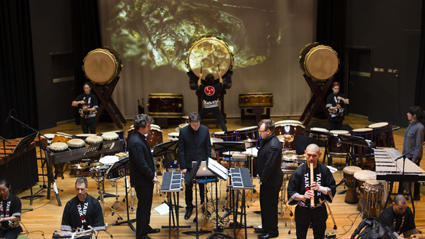
Pulse:Heart:Beat
photo Michael K Chin
Pulse:Heart:Beat
Sister ensembles TaikOz and Synergy Percussion combined for two nights at Angel Place City Recital Hall in celebration of kaleidoscopic city love in Pulse:Heart:Beat, a concert series that has run for longer than a decade. With more than 20 artists, four premieres, three films and the promise of “gorilla cinematography and animation” (program notes) I was thrilled to witness this collaborative hotpot if disappointed by the marked absence of anthropoid apes.
The concert was a celebration of rhythmic colour with references to Austrian waltzes, Japanese Hachijo-style drumming, French-Senegalese artillery, Sydney’s urban beauties, Punjabi bhangara and dirty universal dance beats. Knowing that this sort of musical smorgasbord could divide an audience, the groups were careful to frame their smashing of cultural and geographic barriers with the question, how on earth do we find intimacy in the maelstrom of modern life?
The concert was intimate despite the size of the venue and cultural turf traversed. At times, with Mike Chin aka Tokyo Love-In slinking his way around the stage, camera in hand, live images of the musicians shot from behind revealed to us new aspects of their experience.
Images by Chris Wilson, originally created for a collaborative work with Legs on the Wall in 2011 titled Beautiful Noise, accompanied Synergy Artistic Director Timothy Constable’s reworked composition Cannons of Navaro. Both the sounds and visuals were borrowed, revised, re-presented in the pursuit of new tradition. During Resounding Bell, a frequently recurring piece in TaikOz’s recent repertoire, there were stunning visuals from filmmaker Brad Kremer. An organic mass, ambiguously animal and vegetable, morphed in relationships with water and air as the meditative modal harmonies of two metalophones interwove under a shakuhachi melody.
Composed by Kevin Man and Kerryn Joyce aka Karak Percussion around 2003, Resounding Bell has been expanded to include an improvised shakuhachi solo by grandmaster Riley Lee and, later, a marimba solo, presumably added when Timothy Constable joined TaikOz on a regional tour in 2010. In Pulse:Heart:Beat composer Man played the shakuhachi solo in Lee’s absence, but rather than improvising a new one, he recreated Lee’s solo because it had come to form an integral part of the piece’s sound world. This highlights an important aspect of the way both TaikOz and Synergy approach innovation, consolidation and the time-frames in which these processes come to pass. They demonstrate with their practice that intimacy is achieved by continual application and adaptation to produce recognisable cultural objects in a lived tradition. In this sense, while experimental and challenging thematically, this program was homogeneous and representative of the ideals and nature of both groups.
In post-concert foyer chitchat, I overheard someone say, “TaikOz makes Synergy look like the poor cousin.” I couldn’t disagree more. Are athletes better than academics? Sure, TaikOz players flash their muscles and sweat true to the cultural signifiers that mark taiko, but they play with the same sensitivity and astounding precision as their relatively restrained, concert hall suited Synergy colleagues. If it is the visual aspect of TaikOz’s performance that trumps Synergy’s, then one could conjecture that those pieces featuring excellent quality films would have met the most positive response, but this did not seem the case.
While Synergy shone as a flexible percussion ensemble, this concert was a strange blend of TaikOz’s multiple musical personalities. A group specialising in traditional Japanese drumming that operates a bit more like a dance ensemble, TaikOz simultaneously inhabits the realms of the classical concert hall, pop festival stage, community drum workshop and corporate entertainment. In a brazenly honest offering, the groups presented their vulnerable and raw musical selves to the City Recital Hall audience.
Perhaps the bravest element of the program was the all-hands-on-deck realisation of young Anton Lock’s throbbing Rhythm River. This work featured Lock clutching a microphone in power stance out front while the full combined ensemble reproduced a dub-steppy pulse behind. Lock rapped, percussively spraying rhymes into a deliberately sparse aural backdrop. With all the enthusiasm of a high-school musical chorus, awkwardly aware of the powerful statement they found themselves making, the beat makers did not appear calm and cool enough to assure the Angel Place crowd that it was okay to participate in such a vulgar, contemporary form of music. Yet void of the verbal obscenity often associated with this form of performance, in fact making an offering of thanksgiving, Lock’s lyrics were uplifting. Nothing about his act was insincere. There was no empty bravado or rhetoric in place to hide a divide between philosophy and life lived. Lock stood, just as he is—rehearsed, dedicated, genuine—to deliver his vision for “freedom of expression.” To Lock, and as it seems for both Synergy and TaikOz, genre is but a site in which musical expression can emerge. This concept of incompletion, of fluidity, is what frees them to experiment with sometimes surprising collaborators, ideas and sounds.
For all its variety and experimentation, the program’s energy really took off only in the encores when the pressures of perfection and stamina had abated. The groups had memorised vast amounts of highly technical music, a cerebral feat not to be ignored or eclipsed by their fantastic displays of physicality. As tension lifted, so did the roof. The crowd, baffled though they were, could not help but be swept to their feet by the massive exchange of energy during rapturous encores. The charm snuck up on us…guerilla scintillation.
TaikOz and Synergy Percussion, Pulse:Heart:Beat, Synergy performers Timothy Constable, Bree van Reyk, Joshua Hill, young artist William Cedar Jackson, TaikOz performers Ian Cleworth, Graham Hilgendorf, Masae Ikegawa, Kevin Man, Kerryn Joyce, Anton Lock and associate player Sophia Ang, sound production Hugh Coffey, vision lead Tokyo Love-In, films Chris Wilson, Brad Kremar, Colin Rich, City Recital Hall, Angel Place, 28-29 June
RealTime issue #116 Aug-Sept 2013 pg. 50
© Felicity Clark; for permission to reproduce apply to realtime@realtimearts.net
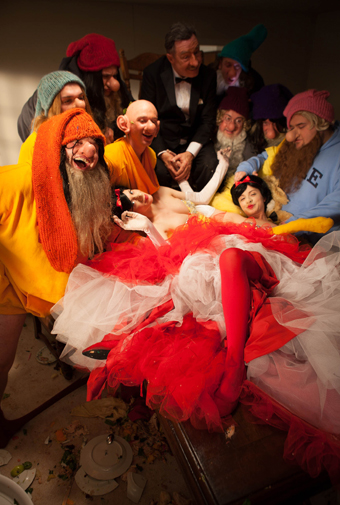
Paul McCarthy, WS, 2013, photo Joshua White
courtesy the artist and Hauser & Wirth
Paul McCarthy, WS, 2013, photo Joshua White
It was a Paul McCarthy fest in New York throughout July with three exhibitions including the massive work at Park Avenue Armory, WS, a psychosexual retelling of Snow White. No artist distills the excesses of American mass culture as McCarthy does. His infantile and excremental performances, full of repressed sexuality and latent violence, expose what really lies beneath the veneer of all those saccharine wholesome ‘family values.’
McCarthy has pushed against constructed notions of normality for the last 40 years. However nothing prepared me for the extremes of WS, which was elemental and primitive in its urgency, its sheer scale and excessiveness in direct proportion to the penetration of the Disney empire into the American psyche.
The Park Avenue Armory, set among exclusive apartments on the upper East Side, is a bizarre setting for the staging of a McCarthy exhibition: a clean and proper exterior for an out of control and messy interior. Entering the massive doors of the Armory, I am aware of the first of many of the skewed worlds that McCarthy offers. WS, or White Snow, is an inverted remix of Snow White, taking the form of a depraved, drunken house party, with McCarthy appearing in many of the video works as a Walt Disney figure or Walt Paul. The Snow White and the Seven Dwarves story, first remixed by Disney in 1937 from The Brothers Grimm original, is in McCarthy’s version, like The Grimms’, visceral and violent.
WS is an insanely ambitious work, including over seven hours of videos, all of which require multiple visits to get through, and a massive enchanted forest with over 50,000 artificial plants and towering trees that are entirely excremental in appearance. Set amid this forest is a recreation of McCarthy’s original, ranch style family home.
Taking over 85 trucks to transport it from McCarthy’s studio in Los Angeles, WS is on the scale of a Hollywood production, appearing like a soundstage, complete with visible camera crews, scaffolding and lighting rigs. McCarthy’s creation is another of his perverse versions of Hollywoodland. Recently the artist purchased over a 1000 acres of desert scrubland to recreate his own fucked-up western town—McCarthy’s Dodge City. I can’t think of any other artist who works on such an enormous theme park scale. His target is mass culture so the idea of more is more and bigger is better has a crazy logic to it. As Walt Paul exclaims in a fit of repeated frustration while in bed with White Snow, “Why does it have to be so big?” “Why does if have to be so big?”
One of the first elements one encounters in WS is sound, an overwhelming orgy of infantile groaning, occasional fits of laughter and screaming fill out the massive Drill Hall of the Park Armory, accompanying videos of Walt Paul, with chocolate sauce soiled underpants around his ankles, frantically screaming at his family of inbred cavorting dwarfs. Walt Paul appears at different times as father, lover, dictator and slave to White Snow. This is Disneyland on crack.
WS provides further weird viewpoints and inside-out spaces: massive billboard-sized video screens; secluded spaces with even darker video content; balcony views allowing one to survey McCarthy’s sprawling Disneyland from above; and views directly behind the massive video screens. These multiple vantage points are echoed in The Dwarf’s house. We peer in through the windows, viewing a crime scene: Walt’s demise, a broom handle shoved in his mouth and exiting his anus.
Such multiple viewpoints ensure the audience is made well aware of the artifice, the fakery of McCarthy’s sound stage. Ultimately he is making the point that mass culture is projected onto us, its reality a slippery construction. On leaving WS one could enter a deranged Disney gift shop, with all manner of Disney merchandise sprawled out over the room, crudely signed and editioned by Walt Paul.
McCarthy is the sublime king of perversion and WS a lasting testament that art doesn’t need to make you feel good about the world to be interesting. John Waters wanted to make films that made you feel dirty, McCarthy’s art makes you feel not just dirty but in need of a good hose down.
RealTime issue #116 Aug-Sept 2013 pg. 52-53
© Ian Haig; for permission to reproduce apply to realtime@realtimearts.net
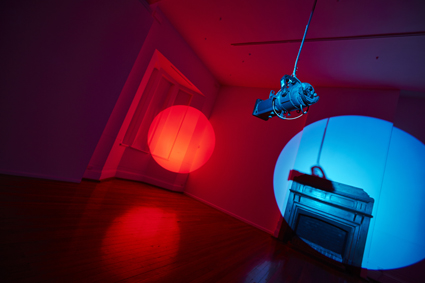
Michaela Gleave, A Day is Longer Than a Year
photo Jessica Wyld
Michaela Gleave, A Day is Longer Than a Year
Two theatre spotlights hang just above head height, throwing large red and blue circles onto the walls. The lights revolve incessantly, elongating into ovals as they move away from their sources, making unnatural eclipses as they pass through each other.
Michaela Gleave is an installation artist who has worked with artificial snow, balloons, fog, glitter and water. Her work forms part of the phenomenological turn in installation art that has for the last decade wanted to simulate nature inside the gallery. With only two lights, this installation is a more austere version of these immersive environments, its sharp poetics resembling the clean edges of 1960s minimalism. Yet nature is at play here too, as Gleave created this work out of a residency with the CSIRO’s Astronomy and Space Science Division.
Space research and minimalism have much in common. They share a fascination with the most elemental of forces and shapes. They share a coldness too, as these elements are indifferent to human fate. In Australia, space scientists work with the most distant of subjects, as they process data from the radio telescopes that dot the country. One of the most recent developments in deep space science is the detection of planets that are orbiting other stars.
The technique involves measuring a shift in the spectrum of starlight. A planet will wobble this spectrum and cause a star to become more red or blue. These are the colours that Gleave uses in her installation, their momentum shifting the shape of the spotlights moving on the walls.
It is as if we are at the centre of some deep space simulation, as Gleave conjures associations with the movement of planets and suns with the simplest of means. Yet the austere beauty of the work is also cursed by the kind of anthropocentrism that haunts space science. The attempt to find extra-solar planets, like the search for water on Mars, is deeply invested with the hope of finding another Earth in deep space. So too Gleave’s cosmic theatre returns us to ourselves, as we are trapped in the middle of the room, for fear of moving and throwing a shadow onto the orbit of lights. The installation turns into a kind of dark cinema that makes the space claustrophobic.
So it is that the cosmos, proving to be so indifferent to us, makes a troubling subject for art. It awes and repulses at the same time, fascinates and horrifies in its mathematical and glorious perfection.
This visitor wanted both something more and something less from this installation, for a sound to accompany the light, or a revolving chair to simulate an astronaut’s experience of the stars. Yet such comforts would move us beyond the subject of Gleave’s installation, which is the inherent austerity of space and time, and the beauty of light.
Michaela Gleave, A Day Is Longer Than A Year, Fremantle Arts Centre, Perth, 8 June–21 July
RealTime issue #116 Aug-Sept 2013 pg. 53
© Darren Jorgensen; for permission to reproduce apply to realtime@realtimearts.net
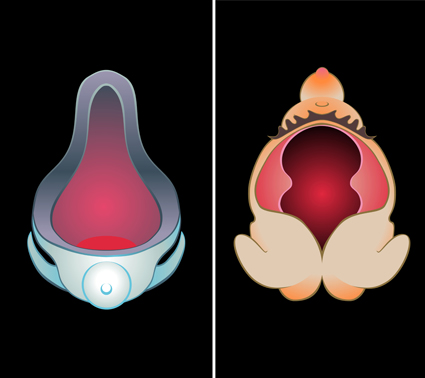
Colour Me Dead—Chapter 5: The Hungry Vagina (animation frame/s), 2013
courtesy the artist and Anna Schwartz Gallery
Colour Me Dead—Chapter 5: The Hungry Vagina (animation frame/s), 2013
The repressed violence inherent in the depiction of the female nude lies at the heart—or maybe the ‘vag’—of Philip Brophy’s substantial exhibition, Colour Me Dead. Traversing art history from the 18th century to the present, Colour Me Dead replays and recodes the naked female in digital animations, video and prints, creating a variegated and sometimes troubling field of reception.
The six works comprising Colour Me Dead parallel the first six chapters of a forthcoming book by Brophy, and indeed, can be ‘read’ as a logical, even educative, sequence. The first work, The Illuminated Nymph, introduces Brophy’s research, which has entailed forensic exploration of over 3,000 artworks. On the wall panel, 15 reference works are reproduced in small monochrome images—from Fuseli’s The Nightmare (1781) to Victor Brauner’s Nude and Spectral Still Life (1939). On a large circular screen, sketched sepia-toned renderings of the original paintings are the backdrop for cartoon versions of their bright-white female subjects, which morph into radiating spines of light, ultimately shattering. Brophy describes them as “flayed; the flesh is stretched and then pinned on a board.” Their transformation suggests both erasure and glorious ascension, too, as they transform into pure absence/pure light.
The Lady in the Lake again refers to a series of canonic artworks, this time revisiting the ‘woman-water equation.’ Four digital prints are bathed in refracting light like the surface of a pond. In each, a central nude stands in one swirling pool or another, flanked by accomplices or scenes of destruction. The first is Venus-like; the second, a siren; the third, a horrifying ghoul; the fourth, surrealist, truncated at the knees. It’s a path from allure to entrapment to the supernatural, with amputation as full stop.
In The Morbid Forest, the same premise applies to the moving image. The darkly sublime Romantic landscape is re-imagined in disconnected scenes, whose contents alarm by virtue of their juxtaposition. Two men dressed in black and camo-pattern stand in various bush locations; their passivity is menacing. Wraith-like females play ring-a-rosy, a child plays in fairy costume, a couple places a flower tribute at a deserted roadhouse. The sense of imminent threat is strong; and the connection between predatory, misogynist culture and the violence lurking in the artistic canon gains momentum.
In The Hungry Vagina, a triptych of deliciously lurid, animated abstractions—now focusing on the literal or symbolic vagina rather than the ‘whole’—open, close and mutate, accompanied by sticky, smacking, sucking sounds. It’s become a game of spot-the-reference (is that Duchamp’s urinal?). In The Sexualised Chimera, ‘pretty’ turns to ‘ugly’ as Brophy creates mock-up 60s-style ‘monster car’ designs: flaming, wheel-spinning mean machines possessed by cackling, claw-nippled or eyeball-popped Medusas and Judiths. In the catalogue Brophy points to “bong shops and heavy metal album covers,” where these hysterical “vulgar monsters” of Thanatos and Eros exist today. With these works I feel myself ‘buying in,’ embracing the aesthetic for better or worse. The threads seem to draw together, producing a bigger, blurrier whole.
I’m often troubled by the replication of sexist tropes in the name of illumination—all too easily it can seem like more of the same: same vagina-dentata, same conflation of woman/sex/death/nature, same monster-feminine. At times I experience this feeling, reluctantly, with Colour Me Dead. I embrace the work and the thesis with enthusiasm and yet find myself wondering, ‘Hang on, don’t we know this inside-out by now?’ I hunger (that ‘hungry vagina’ again, perhaps) for something more irreducible, disturbing, unsettling. It’s a deliberate strategy, Brophy says, to say it like it is (quoting, as it were): he invites the viewer, “to see…or not to see” the sexual violence that exists across the cultural gamut. Perhaps for the male viewer, this invitation might ‘prick’ a little more, hitting that disturbing pitch.
In The Prostrate Christ, Brophy’s narrative seems to reach that more subtle, complex space. A floor-projected video viewed from a platform features two artists’ models posing to replicate dead Christs, pietàs and prostrate figures, aided by two assistants. Echoing The Illuminated Nymph, the original paintings appear as backdrops, here projected behind the models. Brophy comments that the models were instructed to be ‘in control,’ even while being manipulated into position by the assistants. This results in a distinct uncanniness, as process, ‘nude’ and ‘person’ placed on the same plane, inextricable—‘de-composing’ in more ways than one. It’s a moment of relief: a discreet, plain wrapping that completes by allowing a more prosaic story—a space both within and without history, where the nude finally breathes.
Philip Brophy, Colour Me Dead; Ian Potter Museum of Art, University of Melbourne, 13 June- 8 September
RealTime issue #116 Aug-Sept 2013 pg. 54
© Urszula Dawkins; for permission to reproduce apply to realtime@realtimearts.net
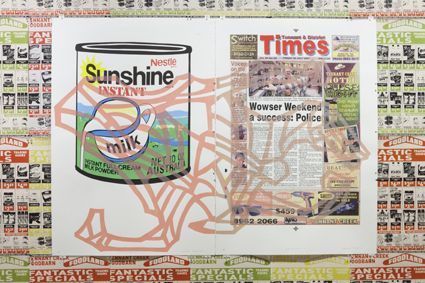
Janelle Low, Ghost Citizens
In recent years contemporary Indigenous art has focused on questions of identity, often personal identity, but with this exhibition, Ghost Citizens: Witnessing the Intervention, we see the return of broader political art about Indigenous Australia.
Along with a number of relevant extant works, the exhibition presents new artistic responses to the “intervention” into Aboriginal communities in 2007, currently named the Northern Territory Emergency Response (NTER), a legislative stripping away of the rights of a minority without regard for international Human Rights conventions along with suspension of Australia’s Racial Discrimination Act.
Ghost Citizens began as an intervention itself, shadowing the 2012 Sydney Biennale. By ‘supernatural decree’ the opening night party coincided with the passing of the legislation to extend the NTER—shockingly for the next decade, a young lifetime. Ghost Citizens, offering Indigenous artists from remote regions peer support, aimed to alert visiting international artists to the fact that not all Australian artists had equal rights. The Biennale curators and many artists attended talks by Eva Cox and Craig Longman from the Jumbunna Centre as well as Hetti Perkins’ launch of Artlink magazine’s “Indigenous Indignation” at Cross Art Project gallery. Income management and other controversial elements can now be applied to any part of the country—including places like Shepparton in Victoria—at the discretion of bureaucracies.
Speaking directly about the role of art in the current political climate, the exhibition draws on works by eight Aboriginal and five non-indigenous artists. Together they represent vast experience in the representation of contemporary Indigenous culture.
During a panel discussion accompanying the exhibition, curator Djon Mundine spoke of cycles in the process of recognition and engagement between white Australia and the Indigenous peoples with attempts at recognition beginning and building only to collapse as the possibility of recognition gets closer. This is followed by a period of retreat and non-recognition when the Indigenous become ghosts again—invisible, avoided and obscured from public gaze.
The bleak and barren Basic Card (2011), consisting of a blow-up banner and associated business cards from Brendan Penzer, displays the government’s new stamp of identity/non-identity. The bureaucratic imposition is emphasised in Penzer’s installation of a collection of sanitised literally white and “approved” supermarket food items and the print-out of the rules that welfare recipients have to live by. It’s a white bread and sugar diet.
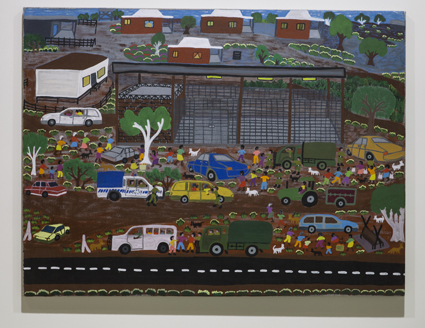
Kylie Kemarra, The Intervention at Ariparra Store, via Sandover Highway, Utopia Community, NT 2010, Ghost Citizens: Witnessing the Intervention
Counihan Gallery, Melbourne
Responses from Aboriginal artists living in remote locations include a painting by Kylie Kemarra titled The Intervention at Ariparra Store, via Sandover Highway, Utopia Community, NT 2010. Here Kemarra depicts troops and trucks herding people into a cage-like store area. Amy Napurulla and Sally MA Mulda paint ground level views of trucks bringing in the portable homes and offices for the new overseers.
The banal is made large in Alison Alder’s mural of grocery prices in newspaper ads from the Tennant Creek grocery, the only supermarket in the remote town. The ordinary looms large like a wall in the mechanics of daily living as the ads are overlaid with pages from the local newspaper that treat the Intervention as a non-event. Jason Wing’s self-portrait behind a government card labelled “Criminal” references the surveillance and digital monitoring [that form part of the intervention].
Therese Ritchie emphasises stigmatisation by stitching the Basic Cards into a gown modelled by Rachael McDinny in her large colour print All dressed up and nowhere to go (2012). Fiona McDonald’s text on landscape prints of Kurnell and of Captain Cook speak of inclusion and exclusion while Bindi Cole’s deeply ironic photographic portraits of people with blackened faces refer to a broader and often rejected Aboriginality.
The laconic left is represented by Chris Chips Mackinolty’s witty new road signs for the NT: And there will be no dancing (2007) and National Emergency Next 1,347,525 km (2007).
Video works include Fiona Foley’s Bliss (2006) featuring haunting images of poppies, referring to the opium supplied to Queensland Aboriginal communities [at the turn of the 20th century] creating addiction and [thereby] control. Other video works contain excerpts from dialogues between activists and artists at Sydney’s Cross Arts Projects.
Ghost Citizens is a collection that documents experiences of marginalisation, of people moved or pushed further to the fringes of Australian society by deliberate government bureaucratic experimentation. It also offers a view into what may be at the fringe of all our political worlds, a portent of wider political futures.
For Indigenous people living in remote areas with little political power, the intervention means discrimination and increasingly segregated and controlled modes of consumption; out of sight and out of mind—ghosts again.
Ghost Citizens: Witnessing the Intervention, curator Djon Mundine with Jo Holder, Counihan Gallery, Melbourne, 16 May-16 June; The Cross Art Projects, Sydney, 21 June-21 July
RealTime issue #116 Aug-Sept 2013 pg. 54
© Vincent Leveridge; for permission to reproduce apply to realtime@realtimearts.net
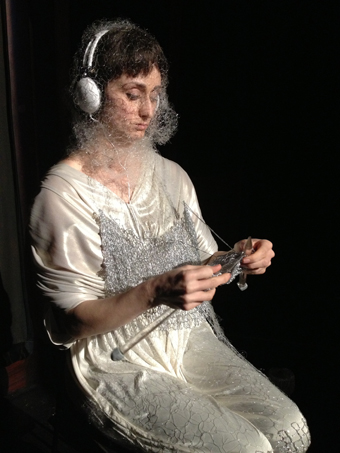
Naomi Oliver, exist-ence 5, Sydney
photo Tija Lodins
Naomi Oliver, exist-ence 5, Sydney
Kathyrn Kelly provides a detailed report on the festival performances in the Brisbane component of Exist-ence. Among a handful of performances in the Sydney iteration at PACT were two particularly memorable works that addressed time and effort in very different ways,
Across the evening, in Self Generating Tranquility Pod, Naomi Oliver sits in a bright pool of light just inside the entrance to the PACT performance space. Clothed in an encompassing white satin, headphones and boots that evoke, perhaps, someone preparing quite domestically for space travel—more inner space than outer—Oliver knits silver thread into a netted layer with which to further cover herself, like a caterpillar encasing itself prior to transformation. The performer’s stillness and concentration yield pleasant contemplation of the values of slow being, making and survival.
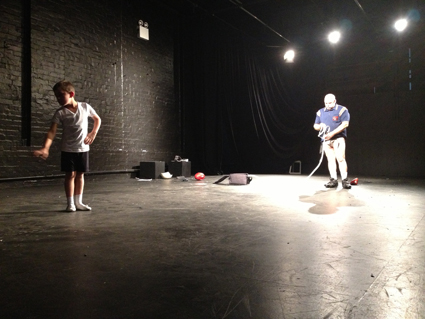
John G Boehme & Beauregard
photo Tija Lodins
John G Boehme & Beauregard
In Sport, performed in the rest of the space, the large-framed John G Boeme (Canada), garbed in a variety of sporting paraphernalia stamps around the stage in spiked shoes indifferently dumping sporting gear of all kinds on the floor while chewing seeds from which he perpetually spits kernels. His 10-year old son Beau ritually bounces a ball against a wall until his father/coach chalks up a target, wordlessly demanding accuracy. It’s the beginning of a series of tests before which the indolent master first demonstrates his own abilities, for example utterly smashing golf balls with violent drives. The boy can’t even connect with the ball.
Things turn more bizarre as the coach spouts platitudes from a self-improvement book (“Success is a marathon, not a sprint”) and, naked from the waist down save for a jock strap and protective cup, places two slabs of butter on his bald head and over them a porcelain helmet-like bowl while, gasping, he sucks oxygen from a tube. Initially the boy skips about (demonstrating balletic tendencies) until it’s indicated that he has to knock a ball off the top of his father’s head with a mini-baseball bat. But the odds against the ball remaining stable are enormous as butter and sweat run down the man’s face. Finally the bowl is abandoned and the ball whacked off his head. The end. Clearly Boeme has some issues with sport—about power relationships, parenting, ego and ludicrous goals. With expressionless ease father and son enact this memorable performance with a detachment that yields both suspense and the laughter of recognition.
Exist-ence 5, PACT Centre for Emerging Artists, Sydney, 19-20 July
RealTime issue #116 Aug-Sept 2013 pg. web
© Keith Gallasch; for permission to reproduce apply to realtime@realtimearts.net
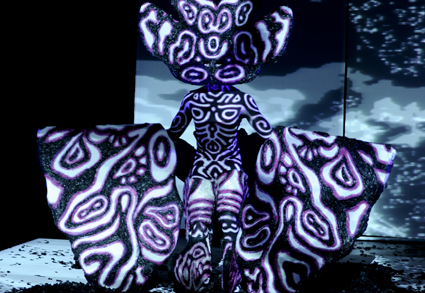
Justin Shoulder, The River Eats (2013)
photo by Heidrun Lohr, courtesy of Performance
Justin Shoulder, The River Eats (2013)
Performance Space’s Show Off season of performance featured a cluster of works including the already acclaimed and touring I’m Your Man (Rosalind Oades) and Opal Vapour (Jade Dewi Tyas Tunggal) alongside Team Mess’ Bingo Unit and Justin Shoulder and Collaborators’ The River Eats, both of which were well received in Next Wave 2012 in Melbourne. Each work confirms the increasing diversification of the means for making and the meanings of performance.
Justin Shoulder, The River Eats
Justin Shoulder is a beloved ‘underground’ talent from the Sydney club scene brought to light in Melbourne by Next Wave in 2012 and this year in Sydney by Performance Space. In The River Eats, aided principally by his masterfully designed masks and costumes (here synthesising gay excess with Kabuki clarity of line) this master of transformation mutates from a quivering bird-like creature to almost himself (largely naked, muscular, coated in brilliant pink), to an abject then defiant simian self and finally into something fishlike, a luminescent, striped exotic you might encounter in the Great Barrier Reef. This final creation in its patterned doublings of itself resonates with the fluid Rorschach imagery in the show’s recurrent screen projections. While the costumes are striking, the movement is only sometimes so, opening with a nimble Baroque bounce and concluding with the delicate wave-like settling and rising of a sea being; in between, and amid some performative longeurs, Shoulder’s steps made much less of his costumes and the work’s potential. Nevertheless he is magical, the very strangeness of his creations exhilarating, not least in their echoing of the design richness of evolution and the promise of its continuance in hybridity to come.
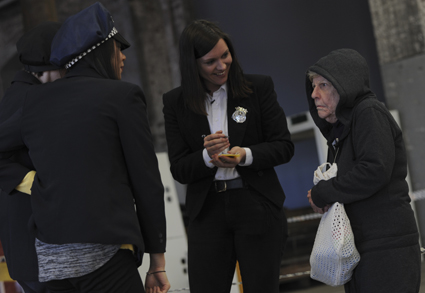
Team Mess, Bingo Unit (2013) The Discovery of the Body scene
photo Heidrun Löhr, courtesy of Performance
Team Mess, Bingo Unit (2013) The Discovery of the Body scene
Team Mess, Bingo Unit
Adroitly exploiting public familiarity with the TV crime detective genre, Bingo Unit is a fun entertainment powered by three engaging performers (Frank Mainoo, Malcolm Whittaker, Natalie Randall) who play key roles, wrangle the audience and, from time to time, improvise as audience members become interrogators, jurors or part of an identification line-up. Amusing pre-recorded improvisations include a series of pairs of non-performers playing policemen on stake-out, each couple inventively reacting to the sudden appearance of the same suspect exiting a house, wiping down and flourishing a heavy sword before tossing it in a bin (“He can’t recycle that!”). You witness these yourself by sitting in the stakeout vehicle on the stage floor, watching the improvisations on a monitor mounted on the car’s bonnet. Other taped improvisations feature detective briefing sessions, delivered by officers with blunt indifference to the horror of the crime.
Wandering about the performance space you can randomly attend a medical forensic session, kick a door in to apprehend a suspect, watch breaking non-news and an interview with the cagey woman (Wendy Blacklock) who found the body, inspect a bedroom with clues (or not) and attend an interrogation and a trial (in which the judge is Chris Haywood). Bingo Unit lacks the chill of the current wave of detective drama (The Killing, The Bridge and the Danish-influenced UK drama Broadchurch) and offers no particular insights into the genre (nor doubtless intends to) beyond our undying fascination with it. But its clever deployment of its participants, live and pre-taped, and its generation of live studio ambience surprises and engages. Doubtless the crime genre will manifest in the game-playing theatre Robert Reid described in RT115 (about which he will reveal an Australian dimension in RT117), with the audience playing an even greater role in solving the mysteries of life—or, as in Bingo Unit, revelling in the abundance of clichés we culture makers endlessly generate and perpetuate.
Performance Space, Show Off: Team Mess, Bingo Unit, creators Dara Gill, Frank Mainoo, Malcolm Whittaker, Natalie Randall, 10-13 July; Justin Shoulder and Collaborators, The River Eats, 3-13 July, Carriageworks, Sydney
RealTime issue #116 Aug-Sept 2013 pg. web
© Keith Gallasch; for permission to reproduce apply to realtime@realtimearts.net
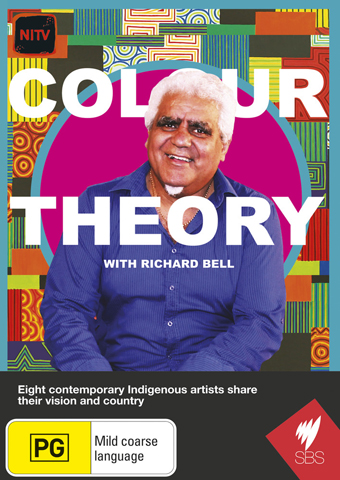
DVD: Colour Theory with Richard Bell
Leading Indigenous artist and provocateur Richard Bell is your amiable host for this excellent series from director James Marshall, producers Susan Moylan-Coombs and Jane Davidson and writer Hetti Perkins. The episodes are wonderfully unhurried, allowing artists to speak for themselves, for the viewer to absorb the art works and, critically, appreciate the country from which they evolved. The selection of innovative artists takes us into film and installation (Warwick Thornton, a wonderful episode, largely filmed in Alice Springs), street art (Reko Rennie), painting-photography (Nici Cumpston), stage design (Jacob Nash and the evolution of Bangarra’s Terrain), painting and sculpture (Tony Albert), sculpture and music (Archie Moore), weaving and sculpture (Vicky West) and exquisite glass sculpture (Yhonnie Scarce).
5 copies of Colour Theory courtesy of Madman Entertainment
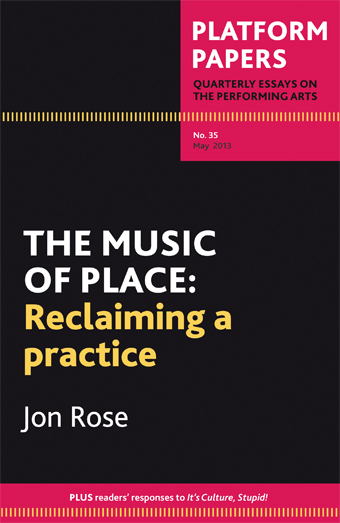
Platform Papers, No 35: Jon Rose, The Music of Place: Reclaiming a practice
This essay comprises a bracing alternative view of the history and nature of Australian music, underpinning an argument for the greater recognition and appreciation, aesthetically and in terms of financial reward, of Australian musicians. In his review of the essay, Julian Knowles writes, “Rose’s approach…closely resembles his prolific and influential musical output. His arguments demonstrate a lateral, creative form of thinking that challenges traditional understandings of history, culture and genre, resulting in a provocative collision of ideas out of which a powerful logic emerges” (see page 48).
3 copies courtesy of Currency House
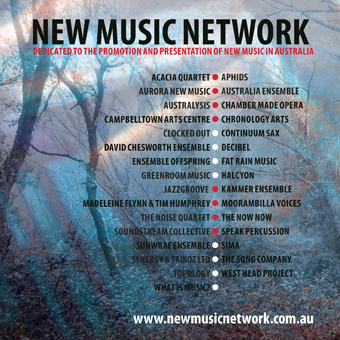
New Music Network: NMN 2013 CD Sampler
The 2013 NMN promotional 2CD set features vivid live and studio recordings of new and improvised works from 27 network members around Australia. You’re in for some surprises with radical gearshifts in tone and pace from track to track, bracing contrasts in instrumentation and works that range from fierce to reflective. The performers are some of the best exponents of Australian new music: austraLYSIS, Chamber Made Opera, Chronology Arts, Clocked Out, Continuum Sax, David Chesworth Ensemble, Decibel, Lawrence English with Aphids, Ensemble Offspring, Fat Rain Music, Halcyon, Kammer Ensemble, The Noise Quartet, West Head Project, The Song Company, Soundstream Collective, Speak Percussion, Sunwrae Ensemble, Synergy Percussion and Topology.
5 copies courtesy of New Music Network
Please note you can nominate for ONLY ONE GIVEAWAY.
Email us at giveaways@realtimearts.net with your name, postal address and phone number.
Include ‘Giveaway’ and the name of the item in the subject line.
RealTime issue #116 Aug-Sept 2013 pg. 56
© RealTime ; for permission to reproduce apply to realtime@realtimearts.net
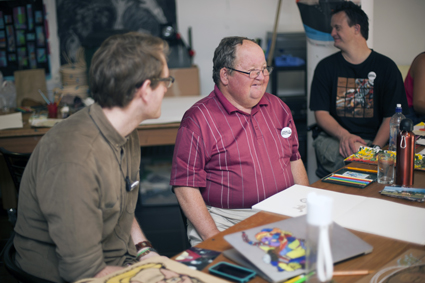
Jeff McCann, Wayne Emerson, Scott Lea, 8 Artists, Eastern Riverina Arts
photo Christopher Orchard
Jeff McCann, Wayne Emerson, Scott Lea, 8 Artists, Eastern Riverina Arts
Continuing our series on innovative arts ventures in Wagga Wagga and surrounding regions, here we look into the activities of the peak advocacy and support body in the area, Eastern Riverina Arts (ERA). I spoke with Scott Howie, Regional Arts Development Officer and practising artist.
Previously an English, Drama and Media teacher in Canberra, Howie moved to Wagga in 1999 to study Film and Television at Charles Sturt University. Dissatisfied with the technological barriers placed between him and actors/audiences in the broadcast medium, he created performance works exploring modes of interactivity, forming his own company Jibshot.
Of the opportunities at the time Howie says, “Things were cheap, people were encouraging. There was a professional theatre company that was interested in working with me as someone doing young and emerging work beyond what they were programming…It was kind of low risk financially. You could afford to experiment. If it didn’t work you weren’t going to lose a huge artistic reputation. We’re talking maybe 12 years ago—regional activity was quite low and it was easy to stand up and say, ‘Hey, I’m somebody who’s practising regionally.’ And it was quite easy to get some funding. It’s much more competitive now that the level of regional activity has just exploded.”
Generating projects, connecting people
Howie suggests this explosion of activity results in part from artists moving to or remaining in the area in order to feel “more connected to the landscape, more connected to community. And certainly for me it’s about that. It’s about having time and space for contemplation.” It’s also due to people like Howie and the activities of organisations like Eastern Riverina Arts. There are in fact 14 Regional Arts Development Organisations (RADOs) in NSW that are triennially funded by Arts NSW and from local council contributions.
Howie describes the role of Eastern Riverina Arts: “We’re about arts and cultural development so we generate projects across the region, promote what’s going on and run training workshops. The whole notion for me is about how we connect people. We’re brokering relationships, whether that’s assisting the local conservatorium of music to tour its work throughout our region to the smaller towns; or bringing in a company like Monkey Baa to tour our smaller volunteer presenter networks; or a big project we’ve just finished—an arts and disability exhibition at the art gallery…And always trying to find opportunities to employ artists at a professional level in a professional manner.”
In the gallery, on the road
The last project to which Howie refers was titled 8 artists and involved extended studio collaboration between four pairings—artists with and without disabilities—culminating in an exhibition at the Wagga Wagga Regional Gallery. The works by Wayne Emerson with Jeff McCann, Angela Coombs Matthews with Kellie Hulm, Vic McEwan with Scott Lea and Jacqui Meyers with Julia Davies included mixed media, painting, mosaic and video installation. (The beautifully produced catalogue is available for download at http://8artists.net/.)
A playful, smaller scale project, Car Boot Gallery, saw Howie touring to 10 local council areas exhibiting works commissioned from artists, one from each area, out of the back of his car. Howie says, “It provided a survey of the range of artistic practice in the area from [artists] with professional exhibition experience to young emerging artists. It’s great for us to get out there and meet the artists so that they know what we’re doing.”
On the performance front, Eastern Riverina Arts is co-ordinating the Short & Sweet Play Festival which has received funding to roll out in regional areas. Local playwrights and actors will be working out of the Cootamundra Arts Centre, an old carriageworks donated by the council to a local volunteer group who have converted it into a 120-seat theatre and exhibition space. ERA is also running a two-year hip-hop dance program with young people across six towns resulting in a series of dance films that will tour the region. The organisation has also just assisted the artists Greg Pritchard and collaborative husband and wife duo The Ronalds in a streaming broadcast project that was part of Underbelly on Cockatoo Island in Sydney.
Speaking up for art
As well as administering a small funding program on behalf of Regional Arts NSW, Eastern Riverina Arts also plays a vital advocacy role in the region. Scott Howie cites a recent example where the Wagga Wagga City Council developed an ambitious public art program including two $60,000 commissions for works sited at the airport. Howie says, “Of course in tight financial situations a lot of people would question the value of that. So we jump into that debate and talk about what it actually costs and what artists actually do.” ERA will shortly be running a one-day conference on public art and art trails, bringing leading Indigenous artist Fiona Foley, who has created a number of significant public art works, from Queensland as guest speaker.
Challenges & resonances
Activity in the region has increased dramatically over the time that Howie has lived in the area. There are now a number of organisations and groups producing contemporary work attracting national attention, such as The Cad Factory (Vic and Sarah McEwan, see RT115), Wired Lab (Sarah Last and David Burraston), White Box Theatre (Kim Hardwick and Martin Kinnane) and The Ronalds (Patrick and Shannon Ronald). However funding is still somewhat limited. Howie ponders, “How many more artists and arts organisations can we sustain at this level? When you carve up the pie who else are we going to be able to support? How’s anyone else going to be able to bubble up?”
Howie also fears that the techno-utopia promised by the National Broadband Network may not fully eventuate. “I do think we’re still going to have a two-speed digital economy. We are going to have lower upload speeds than metro cities…The challenge for us regionally is how we put things in place that allow us to send stuff out. Do we need to have some digital streaming studios that are portable? A lot of the work that happens that’s interesting in our region is site-specific. How do we ensure that we’ve got technology available [for that]?”
The other challenge Howie sees is the lack of critique. “It’s tricky to get people out here to look at the work. Unless you really want to focus on promoting what you’re doing to the metros it’s really hard to even be noticed. So we need to raise that culture of not being afraid to critique the work that’s going on here—and to seek that.” Which is where RealTime comes in. As part of our regional focus, RealTime managing editors Keith Gallasch and Virginia Baxter will be conducting a series of writing workshops in the region to assist in the development of a robust culture of commentary and critique.
Scott Howie is very positive about developments in the region and particularly in audiences. In a follow-up email he writes, “I think audiences are becoming increasingly open to new experiences, things that re-imagine or reconfigure spaces, that have strong local connections either through space, people or content…Knowledge of the genre/artform/discipline is less important as long as the work resonates within communities.” We look forward to exploring these resonances in our upcoming coverage of Cad Factory’s Sunrice Project and the Wired Lab’s Open Day in coming print and online editions of RealTime.
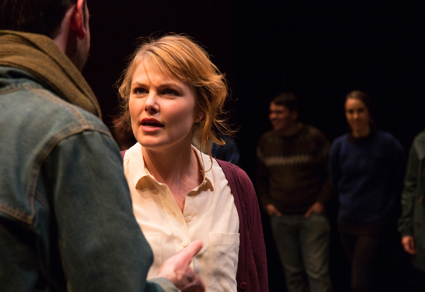
Benedict Hardie, Anne-Louise Sarks, By Their Own Hands, Hayloft
photo Pia Johnson
Benedict Hardie, Anne-Louise Sarks, By Their Own Hands, Hayloft
This year the Melbourne Theatre Company hosted five seasons of work by independent theatre artists and companies under the umbrella title Neon. Three of the women represented were Anne-Louise Sarks, newly appointed Resident Director at Belvoir, and Emma Valente and Kate Davis who are The Rabble.
I am interested in the different trajectories within the industry taken by these women (I talk with Valente and Davis in RT117) and how their feminism is informed by this. Anne-Louise Sarks has, by her own account, ridden the current wave of affirmative action in the theatre industry—not that she hasn’t worked to earn her place. “It did help that management was looking to give women opportunities and I was conscious of what was on offer because of the media attention.” We spoke about how we struggle in society at present to have intelligent and complex conversations about women in leadership positions; the public discourse around Julia Gillard showed this up.
Sarks was introduced to feminism and contemporary performance at Sydney University where she completed Honours in Performance Studies. She was also President of the Sydney University Dramatic Society and ran workshops for women. Her first directing gig was Eve Ensler’sThe Vagina Monologues, a play in which she saw the potential to shift something for an audience. Her motivation to do this work reflected not so much a personal sense of grievance as a feeling for the potential of theatre to change an audience’s perspective on women.
Considering she needed more theatre craft to realise her ideas she decided the VCA offered the most open training for someone like herself interested in making work. A year after graduating she found her way into The Hayloft Project and back into making work. She describes watching director Simon Stone boldly do what he wanted. She learned to be brave from watching his bravura. She describes the Hayloft gang as having been her home base and how forging a path as a solo director has taken her away from this community. In 2011, Sarks held the positions of Associate Artist for Belvoir and Director in Residence at the Malthouse Theatre Company. She made her mainstage debut in 2012, directing Kate Mulvany’s The Seed for Melbourne Theatre Company. She also co-wrote with Kate Mulvany and directed a new production of Medea after Euripides for Belvoir presented in association with ATYP [Australian Theatre for Young People, Sydney] in 2012.
“I have a mission which is not always overt. When I work with existing stories I am updating the work to now. I am interested in how the work speaks to now and very much with how the work speaks to me and to the people I know. That’s where my mission and I collide. Because I am a woman in the world I ask particular questions of the piece, especially of the female characters. That’s how we ended up with By Their Own Hands. It was Jocasta’s story. Medea was the same. I wanted to challenge how people saw those women—or in Jocasta’s case, whether people saw her at all. So my work is feminist but I don’t necessarily sell it in that way. I find that tension really difficult because I am really passionate about being a woman and I want to make work that is feminist. But I don’t want to be separated from the rest of the theatre community by being described as a woman director or as a feminist.
“I believe theatre is unique in the arts. Like all art it’s an exploration of what it is to be human but, unlike most other artforms, that exploration is being undertaken live by everyone in the room at the same time, viewers and performers. When you see a piece of theatre you can’t help but be aware of being in a crowd with other human beings watching other human beings performing stories that are in some sense yours. For me, that means theatre has the potential to shift you. I want to keep pushing back from the stage to the audience. By Their Own Hands (see review) was a large push: ‘What if you stand there and I point at you to make you realise that this story is about you, about us?’ That is celebrating the uniqueness of theatre.”
In this work, the audience is invited onstage by Sarks and Benedict Hardie, her long-time collaborator. Hardie attended Sydney University and then the VCA with Sarks. They both then joined the Hayloft Project and have worked together many times in different roles. (They directed and performed By Their Own Hands; wrote and directed The Nest; and co-devised Yuri Wells which was written and performed by Hardie and directed by Sarks.) They then tell the story of Oedipus, selecting audience members to stand in for the various characters being described. Some take on the roles and some remain as audience while other audience members look on. We then return to our seats and watch the performers set up a series of images that centre on Jocasta’s experience. Finally the pair grab microphones and have a series of poignant and funny conversations as Jocasta (Sarks) and Oedipus (Hardie), delivered stand-up style directly to us.
“Part of my approach stems from the fact that I realised about six years ago that my favourite novelists were men. I then made a conscious effort to read novels by women. The experience really woke me up. I was intrigued by how committed I had been to male novelists, unconsciously devouring these works. And then suddenly, instead of looking in, I was part of those stories. I understand first-hand why this is still so tricky in theatre. Every time a play is produced by women, focusing on women, people ask, “But will this speak to men?” But nobody ever questions whether plays by and about men speak to women—they just assume they’re ‘universal.’ Theatre practitioners can still often discuss work by women as being for a female audience. I realise that to undo this gender bias takes work and deliberate decisions.
“Of course, I also had dealt with the canon in my training at VCA. But I hate ‘history pieces’—doing works as we think they might have been. I fear the audience won’t make the leap. I am a very literal person, not metaphorical. I don’t want the audience to be able to think that’s not about us. This might make people ask, then why work with classics at all? The answer is I like having a beginning point with an audience, to start in the middle of a conversation. It feels that more is then possible.”
RealTime issue #116 Aug-Sept 2013 pg. 36
© Anne Thompson; for permission to reproduce apply to realtime@realtimearts.net
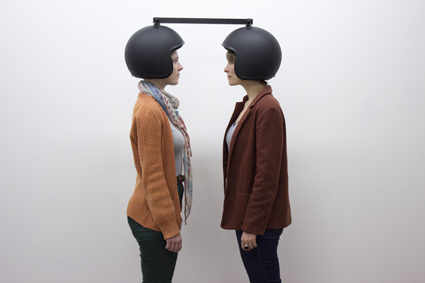
Caitlin Franzmann, Courtney Coombs, Focus, 2012, Fresh Cut exhibition
image courtesy the artists and IMA
Caitlin Franzmann, Courtney Coombs, Focus, 2012, Fresh Cut exhibition
Our 2013 Arts Education feature, Utopias & Horrors, reveals the Zombification of tertiary education but salves the pain with utopian antidotes in which intimacy, the studio, laboratory and the transdisciplinary figure strongly.
Parts 2 and 3 of our Women + Performance column feature an interview with Melbourne director Anne-Louise Sarks and thoughts on the nature of female humour prompted by a performance night at the Backflip exhibition at the VCA.
While right-wing commentators regard Paul Clarke’s Whitlam, The Power & the Passion as left-wing, Dan Edwards in his On the Dox column takes exception to a conservative documentary with a severely limited viewpoint, poorly chosen commentators and a pop cliché style.
Ian Haig sees Paul McCarthy’s vast “psycho-sexual retelling” of Walt Disney’s Snow White at New York’s Park Avenue Armory, while Vincent Leveridge welcomes a “return of broader political art about Indigenous Australia” in Ghost Citizens: Witnessing the Intervention.
RealTime issue #116 Aug-Sept 2013 pg. 3
© RealTime ; for permission to reproduce apply to realtime@realtimearts.net
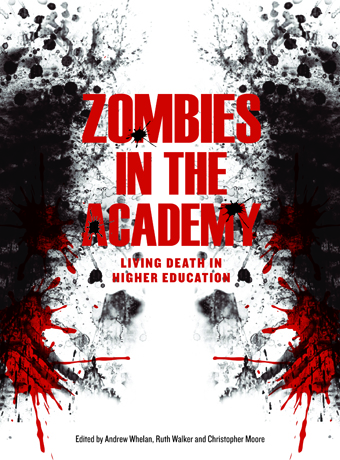 Academics in the humanities and the social sciences like to write about popular culture. They like to use ‘high’ theory, the accredited and validated discourse of the academy, to do so.
Academics in the humanities and the social sciences like to write about popular culture. They like to use ‘high’ theory, the accredited and validated discourse of the academy, to do so.
‘What does World War Z really mean? What would [insert European theorist’s name here] make of it?’ This mode is so common, it has become a kind of bait-and-switch: academics end up talking about popular culture (after all, it is ‘relatable’ for students), while somehow forgetting (how) to talk about the real economic, social and political context in which they are operating. Reality, after all—with its economics, politics, and society—is actually pretty boring, if not outright confusing. Where popular culture becomes the dominant allegory through which the truth of social reality can be understood, academics should engage with it too, or rather, explain at a ‘higher’ level what it all really means. This model of cultural interpretation looks something like this:
High theory → popular culture → social reality
The allegories of popular culture must be decoded, using the most sophisticated, elegant and fashionable intellectual resources available. Meanwhile that real world context, at which the high theory was originally pointed, gets steadily, incrementally eviscerated, such that the grounds on which to say anything at all become increasingly precarious. After the disquisition, the fall.
This old-school critical line is quite well established. However, we would argue for something else: what if popular culture is something we can use, but coming from the other direction? The university: what does it mean? What would George A. Romero or Dan O’Bannon make of it? Better: what would zombies make of it? That is to say: instead of using academic discourses to understand popular culture, let’s use popular culture to understand academic discourses. Rather than having popular culture as a ‘passive’ mass on which the ‘active’ academic analyst performs hermeneutic operations, revealing for our collective benefit what the ephemera of the contemporary really means, let’s have popular culture as a resource with which to understand this curious academic game. This model could look a bit like this:
Popular culture → social reality → high theory
Specifically, let’s take the opportunity to poke a finger into the festering hole which is the blind spot academic critique has about the material conditions sustaining (read: degrading) its own production. Being manoeuvred into social obsolescence is something in which academics have actively cooperated. As our public culture becomes slowly more anti-intellectual, academics have been siloed away, forced by the bureaucratic imperatives of institutional audit culture to produce regular ‘outputs’ of scholarship for paywalled scholarly journals. The public, to whom such erudition is entirely and deliberately invisible, justifiably wonders what academics draw salaries for. Making the outputs unavailable (and thereby, incidentally, allowing corporate publishers to bleed university libraries dry, as they simultaneously profit from the taxpayer-funded labour of academics) is certainly a rather dainty strategy for social closure. But it does not do much for academic activism in a context where budget justification is the highest priority.
This redundant make-work is compounded by the grotesque pretence that everything is ok: that universities effectively serve labour markets and this is their best and true purpose, that ongoing economic ‘growth,’ in the higher education sector and elsewhere, is not only ecologically sustainable but actually feasible, and so on. Exacerbating the problem is the way that universities now operate as incorporated entities producing and delivering various kinds of ‘products’ (degrees, courses, research, students). Students are still the biggest cash-cow for Australian universities, counted as full time participants while their brains and bodies are occupied elsewhere, in the retail and hospitality jobs that serve as the real means of production for their student status.
Contemporary universities insist with revolutionary fervour on ‘business as usual’: in their structure, their branding and their public voice. The idea that scholars might use the knowledge and resources at their disposal to actually unsettle the status quo is increasingly unthinkable. What kind of business model is predicated on actively telling the punters that things—starting with the product that is their education—are not going to be ok? Opposition is foreclosed by the structures of academic labour, the normalisation of short-term or casual teaching contracts. Sessional staff, usually on hourly rates and semester-long contracts, now do 50-60% of all teaching at Australian universities. Besides, who has the time to voice dissent, between filling out forms and massaging the Faculty strategic plan? Between forcing our snouts into the shrinking trough of research grants and the actual work of teaching? Academics have surrendered their social and political responsibilities, becoming hypocrites while doing so. This is in bizarre contradiction to what appears to be going on in the real world, where ‘business as usual’ has been globally confronted with mass protest, financial crisis and austerity, and glaring evidence of systematic governmental abuse of power.
So, let’s run a few scenarios, taking our lead from where we really learnt everything we know: zombie movies. A constitutive feature of this genre is that, whatever happens, there will be some kind of a siege, where survivors fend off legions of the undead. This is a bit like being at a university, in the following ways:
The apocalypse: everything is dead, or will be.
In the archetype, Romero’s Night of the Living Dead (1968), the last stand occurs in a farmhouse. The uni is the farmhouse. Everything outside is undead. The state, the market, the military, the family, religion, mass media, civil society, all other social forms barring the university itself are dead. They keep shuffling about, but it’s all over.
Students are alive. Academic culture is undead.
Academic culture is a living dead culture. It is a ghastly and infectious miasma of putridity, feeding the most pernicious monster: ‘theory.’ It is obsessed with the minutia of the past; corpses we dig up and bury over and over to the antediluvian rhythms of the academic calendar, dismembered into neatly segmented chunks of learning. Preoccupied with archives and protocols, it presents itself to young people as a paradigm case of their own disempowerment and marginalisation. After 14 years of schooling in the hope of something better —nope, all dead here too. At uni nobody can hear you scream, and nobody cares.
Academics are alive. Student culture is undead.
The standard line. Students are dead on arrival, shuffling into the mausoleums of the lecture halls, entombed in their tutorial seats. They are zombies distracted by the pretty lights of their cybernetic devices and the endless noise of their ‘social’ lives mediated across desktop, portable and mobile screens. They push lifeless words around on paper for grades, and don’t think. If students are dead, academics probably had a hand in killing them (the first time, and maybe the second too).
Academics are alive. Administrative culture is undead.
Another popular approach. New public management is a soft target—because it is a bloated and rotting corpse! In Shaun of the Dead (2004), the last bastion of solace is the local pub. The outdated public house is a site of the tired and retired, the misaligned and misanthropic. The administrative culture once serviced the operations of higher education, but now we hunker down as it calls for our brains, fending it off as best we can. Last chance to get a few rounds in, and maybe, just maybe, wait out the apocalypse.
Administration is alive. Academics and students: both undead
.
This variant is a bit more esoteric, and therefore apparently challenging. But think about it: someone has to feed (us to) the bureaucratic machine. Managerialism triumphed in the university sector because academics were unwilling or unable to come to terms with financial and governance structures imposed from without, and so they relinquished control. The only reason academics and students are even populating the frame is because administrators are still fighting to make the frame possible. It makes no difference to the administration if the brains are dead as long as the bodies keep moving.
Technology is undead.
This version is encountered in relation to the discussion around MOOCs, Online Learning, and other ‘systems’ for content delivery and asynchronous communications and content delivery between pedagogues and the student masses. These are tools for systematisation and standardisation. Technology in the many forms in which it colonises academic work is ‘undeadening,’ in that machine processes supplant both intellectual labour and people. Learning and teaching are reduced to clicking.
It is also a convention of the zombie genre that inside the farmhouse, the real threat is the living, with their ignorance, greed and selfishness. The survivors are the real monsters. In this way, contemplating the undead actually teaches us something about what we value about our humanity—ideals that, like community, collaboration, and collegiality, are not best served by contemporary university culture. It is for these sorts of reasons that the contributors to a recent book about zombies in universities have all taken a bite out of the scenarios listed above.
Armed with dead metaphors, the 34 collaborators involved in the collection Zombies in the Academy: Living Death in Higher Education, recently published by Intellect Books, are looking for survivors in the post apocalyptic setting, splattering the brains of high theory with the material critique of those who live, work, study and think under the current conditions in which universities operate. They reanimate debates around theory, pedagogy and the structures of the massified systems of learning. Each chapter directs familiar zombie allegories at corporatised higher education, with often surprisingly optimistic responses to the challenges and pressures presented. None is ambivalent. Rather, each is ‘undeadened’: relentlessly critical, humorous, searching and always informed by the pantheon of the living dead.
Whelan, Moore and Walker are the editors of Zombies in the Academy, Living Death in Higher Education, Intellect Books, London, 2013
RealTime issue #116 Aug-Sept 2013 pg. 5
© Andrew Whelan & Christopher Moore & Ruth Walker; for permission to reproduce apply to realtime@realtimearts.net
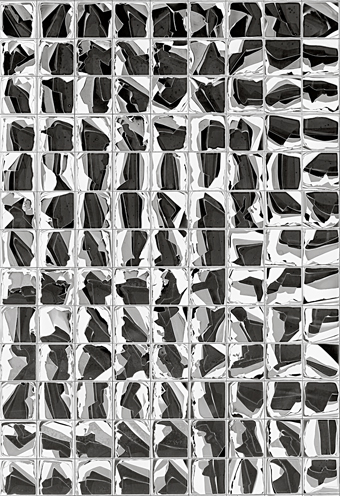
Matt Higgins, Master of Philosophy candidate, Photography and Media Arts, ANU School of Art, Untitled, chemigram, 2013, detail
The invitation from RealTime to ‘think utopian’ lobbed into our email inboxes with startling precision. We feel as though we’ve been down in the educational trenches for so long, only putting our heads above the parapet occasionally, that an invitation for long-term wish lists of new ways to encourage and enhance creativity seemed like a pretty but fragile present delivered from far away.
Utopian beginnings
But of course art schools, despite all the obvious constraints and compromises, still are utopian, or perhaps quixotic, places in which to teach and learn, because the outcomes of creativity are so precious but elusive. We were reminded of this, even before the RealTime invitation, because this year is Canberra’s Centenary, so there’s been much activity celebrating the historical ideal of the city, which was itself in part a utopian project, as well as the history of the ANU School of Art going back 40 years. For instance last semester we had two visiting artists from the UK, Neil Bromwich and Zoe Walker, working with students from across the school’s various workshops on a performance called Art School Anecdote, that celebrated the school’s philosophical roots in the Bauhaus tradition as well as its place in the community; and this semester performance artist Barbara Campbell is working with a different school-wide group of students on RE:ACT which will ‘reactivate’ the historically significant ACT3 performance event, which took place at the School in 1982.
Art school spirit
Seen in this longer historical duration the big deal about art education remains that it is now a thoroughly university education. We have now been an academic unit within the Russian doll of the university system, as opposed to a stand-alone institution, for over half our history. Nonetheless the ANU School of Art today still looks, feels, sounds and smells like an art school, and that sense of a complete creative environment has to be part of any future. It has its own culture where students still spend big chunks of time in the studio, or darkroom or lab, working with their bodies, hands, muscles or brains on detailed, skills-based processes, within disciplines that they feel part of as artists.
The studio as utopia
Our students still engage with materials, be they virtual or physical, and deal with the specific qualities and resistances of those materials. We recite the mantra of ‘studio-based teaching’ so many times that we forget how profound it is, but it has to be the bedrock of any future utopia. Our utopia would therefore still encourage students like master’s student Matt Higgins, who has revived an arcane photographic process called the chemigram, where through the successive application of photographic chemistry, as well as various resists, to photographic paper, either an extraordinary tessellated, lapidary surface is built up, or a remarkably illusory space of abstract 3D forms and swirls is created. This intense, concentrated, studio-based work has not only produced jaw-dropping images (‘How did you do that?,’ people are always asking) but has also led to Matt forming international networks across Europe and the US, linking some of the older generation of ‘chemigramists’ from decades ago with younger artists such as himself on collaborative workshops.
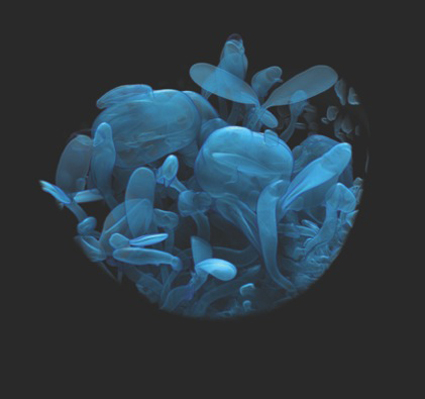
Erica Seccombe, PhD candidate ANU School of Art, Grow: visualising nature at nanoscale
courtesy the artist
Erica Seccombe, PhD candidate ANU School of Art, Grow: visualising nature at nanoscale
The transdisciplinary studio
But disciplines aren’t silos. We’ve also been saying that our teaching encourages ‘multidisciplinarity’ or ‘interdisciplinarity’, or ‘transdisciplinarity’ for so long that we tend forget the future implications of those sometimes glib throwaway lines, which are unfolding right now. The future of interdisciplinarity isn’t so much the simple partnering of artists, or the combining of skills or the translation of forms from one medium to another, it is the fundamental integration of creative spaces—‘studios’ if you like—across wide stretches of creative interest. This can only happen in a university, where there are also creative people down in their own Russian dolls elsewhere, in computer science, applied mathematics, physics, music performance, anthropology, archaeology and so on. Increasingly we are seeing collaborations not only between interdisciplinary students and researchers, but within transdisciplinary spaces.
One such space is custom software called Drishti, developed by the ANU Department of Applied Mathematics, which enables researchers to view virtual microscopic data recorded over time in three dimensions. Visual arts PhD candidate Erica Seccombe has a background in printmedia, but she is now testing the limits and possibilities of this virtual 3D data visualisation in Drishti. In Grow: visualising nature at nanoscale, she has been using 3D microscopy and x-ray tomography to capture the very moment agricultural seeds germinate in three-dimensional, time-lapsed, x-rays. Erica has been working integrally within this leading research group of applied mathematicians and computer visualisers over several years and has mastered the Drishti environment in close dialogue with the software engineers who have also continually developed and refined it. By ‘controlling,’ ‘sculpting’ or ‘moulding’ the data parameters, Erica is producing a work where her audience experiences the moment a seed comes to life in an up-close and personal way they have never experienced before. They not only see the outside of the seed develop as they might with conventional time-lapse photography, but because it is x-ray data they see the internal structure of the seed grow at the same time.
Why seeds? Her project is a response to a prediction of future food shortages due to the environmental crises of global warming and overpopulation. She says, “Our culture grew out of the human ability to harvest and grow seeds for crops, so seeds really are symbolic of what we understand as progress. However, without the natural environment we are nothing, so I think it is crucial to understand the importance of plant conservation. There is a growing understanding that contemporary installation art can provide phenomenological experiences in a way that the hard facts of science cannot. In the digital age it is scientific research and emerging technologies that provide us with a new way of looking at the world. As an artist I’m tapping into that development but resolving the work with an artistic research question, not a scientific one, and this perspective should be considered equally valuable.”

Ursula Frederick, PhD candidate ANU School of Art, Back seats
courtesy the artist
Ursula Frederick, PhD candidate ANU School of Art, Back seats
Trained as an archaeologist and artist Ursula Frederick has just submitted a PhD project on the contemporary archaeology of car culture. Her work seamlessly incorporates tried and tested archaeological techniques and methods, visual anthropology, documentary photography and fine art formal strategies (the grid), in an efficiently integrated transdisciplinary package which would have been hard to imagine as either ‘art school’ or ‘archaeology department’ project 20 years ago, but is becoming more and more commonplace now.
Studio togetherness
The ongoing moment of performance is also being returned to as a transdisciplinary space. Spontaneous and ephemeral creativity, like the repetitive and consistent techniques of the studio, has become a rallying point for explorations between technological innovation and human expression. Ben Swift, a research fellow from the ANU School of Computer Science, asked the question: could the moment in musical performance understood as ‘groove’ be identified in data? Most musicians or performers have vivid memories of that moment in a performance when the shared experience is at its most sublime. It is the consequence of a ‘togetherness’ that is all but indescribable. Using Ben’s custom musical instrument, an iPod Touch App, students from the Schools of Art and Music ‘jammed’ over a number of sessions acquiring both expertise and a shared aesthetic that resulted in moments that were clearly greater than the sum of the parts. The sessions established that the intimate tactile experience of music-making with the touchscreen devices still provided the opportunity to ‘groove’ as musicians.
The studio looks outwards
The utopian vision we have is still ‘studio based,’ still intense and focused, and still potentially across disciplines. And in universities, despite all the current angst, other disciplines—in the performing arts, in computer science, in the hard sciences and in the social sciences—are looking outwards as well. We are all now looking not just for others to ‘interpret’ or ‘present’ our work, but to share creative spaces. Researchers are leading the way, but this future is working its way down through shared graduate and undergraduate courses, and through combined degrees.
RealTime issue #116 Aug-Sept 2013 pg. 6
© Martyn Jolly & Denise Ferris & Alistair Riddell; for permission to reproduce apply to realtime@realtimearts.net
Talking to those who work in the area, it’s exciting to find that what’s utopian to them includes not only ways of teaching screen education, but what that education leads to, the wide variety of activities and employment that expertise in this area is opening up. And it’s even more exciting to realise that it’s not really utopian, because it’s already here. As reported in the Tertiary Open Days supplement in the Sydney Morning Herald on 1 August, “the creative services economy—in particular services such as digital content and web design in fields such as architecture and marketing—is growing strongly.”
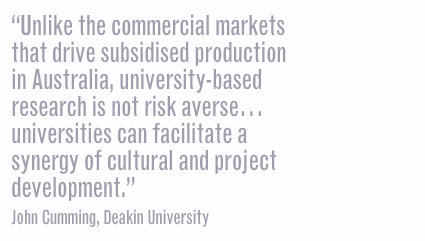
What is still utopian, however, is a better and more fulfilling relationship between the universities and the industry. There’s a belief that universities really need to engage the industry in conversations about ways they can co-operate, and argue that university postgraduate research can actually provide a much-needed forum for innovation in Australian film.
“In terms of employment, media is everywhere, in industries of all types, and media skills are really important for almost every professional these days,” Associate Professor Gillian Leahy explains. “Since our last review at UTS we’ve adopted a much more forward thinking course structure and content in both our undergraduate and postgraduate Media Production courses. While developing film and video skills still constitutes the majority of our course work, all students are learning some sound and new media and working with the web as well. And the image-making, storytelling and structure skills they get from film and video are useful across all media. So they’re all equipped to go out in this time of change and evolving work practices with skill sets that set them up for employment as well as for their own filmmaking.” She adds, “screen production is being used in all sorts of contexts—even wedding videos are now being made with a complete romantic pre-wedding narrative!”
As Leahy explains, UTS has a revised Masters and Graduate Diploma in Media Arts and Production, with more students enrolling for the new pathways provided. “They are forming better teams, as they all have to find work on each other’s projects, and the work itself is looking more sophisticated and with better production values. We don’t really know why the numbers have improved, or why they’re working better together, but it’s happening.”
Stuart Cunningham, QUT
Someone who specialises in forward thinking is Stuart Cunningham, Distinguished Professor of Media and Communications at QUT and Director of the ARC Centre of Excellence for Creative Industries and Innovation. He currently has two projects with great relevance to this area. QUT has just received a Linkage grant from ARC, in partnership with Screen Australia, SBS and the ABC which should contribute to improving the viability of the screen education sector, and the growth of the whole educational market for screen production. With the new requirement in the National Curriculum from next year that Media Arts is to be compulsory in primary schools and expanded in secondary schools, they’ll be carrying out a three-stage survey of schools in terms of their needs in resources, budgets and time for this change, as well as identifying what material is being used and how it’s being used. It’s a three-year project looking at the market for Australian screen content in education, from both supply and demand sides.
Cunningham has also just seen the publication of his new book written with John Silver, Senior Lecturer in Film, Television and Digital Media at QUT. Screen Distribution and the New King Kongs of the Online World (Palgrave McMillan, 2013, and available on Kindle) looks at the impact of the new technologies on screen distribution and the development of viable business models which deliver content to larger and larger audiences across multiple screens, from iTunes, Netflix, Amazon and Hulu to the increasingly dominant YouTube and its global clones. The authors survey the possibilities that are emerging not only for new players in online distribution, but also to what this offers to providers of new content.
Cunningham and Silver argue that there is “good news for independents around the world because the opportunity is there for good content and a sufficient number of more openly accessible video platforms now exist to distribute that content. The potential is there for next generation filmmakers, as long as they grasp the dynamics of social media and the intense feedback loops it creates, to find the right audience online.”
Nicolette Freeman, VCA
The Victorian College of Art, however, has resisted the urge to teach multimedia and gaming, to concentrate on storytelling. “What we’re currently doing is close to utopian,” says Nicolette Freeman, Head of the School of Film and Television. Last year the school introduced a Masters in Screenwriting, and this year a Bachelor of Screenwriting. “We’re putting the writing students together with the writer/director students. They’ll be doing workshops together; they will be on the set, following the process of how a script becomes a film, right through the production to the editing. We’re really interested to see how that impacts on the work that comes out, and the difference between the scripts written by writing students and the writer/director students over the three years.”
Having survived its stoush with the University of Melbourne, VCA is now able to offer electives in filmmaking, not only to VCA students in areas such as dance, but to Melbourne Uni students from totally different areas of study. “We hope students from areas such as science or law could see filmmaking, documentary in particular, as a way to be engaged in their discipline. The electives will offer everything they want to know about how movies are made, then move on to more specific aspects such as acting, censorship, other national cinemas. We’re tailoring the electives to encourage interest in filmmaking.”
John Cumming, Deakin University
At Deakin, they’re also interested in narrative. Script development is integrated with critical evaluation and production through identifying and building narrative structures. Film and Television course director John Cumming says, “The students work with genre in their second year to learn about narrative form and structure, making everything from Westerns to films employing the methods and codes of the French New Wave. They also work in TV studio production, documentary and experimental modes.”
Cumming believes the really utopian future for screen production education would see postgraduate research in creative practice that engages leading professionals. “Unlike the commercial markets that drive subsidised production in Australia, university-based research is not risk averse. At Deakin we’ve begun working with a number of leading producers, writers and directors who see that universities can facilitate a synergy of cultural and project development. Such work can enhance the capacity of industry to critically drive its own development whilst building forums of ongoing support for a new generation of creators who are focused on effectively reaching and challenging audiences.”
Cumming says that, with more than 60% of people now working in the industry having a degree, there is increased understanding of university study and research. “This brings more scrutiny to the contribution that the university sector makes. This needs to be rigorously independent but also relevant and responsive. The film industry in particular is now facing the fact it has had no effective process for high level professional development or succession planning. The university sector can help address this need, as it does in many other industries where the active participation of senior industry figures is integral to academic work. These ‘professors’ of professional practice are a brains trust that can be tapped in a coherent way by engaging them with younger personnel who are now regularly pursuing projects, including feature films, through PhD programs and post-doctoral research.”
A universities – film industry – state screen funders future
Still utopian, however, is a better relationship between universities and the film industry itself, with the federal and state screen-funding organisations still not open to university-industry research linkage, and with postgraduate practice-based researchers still excluded from accessing production funding through government film financing. John Cumming believes that the academy and the industry need to engage in conversations about ways they can co-operate, and that industry needs to understand that universities are not just turning out technicians, but providing graduates and an increasing number of post-graduates who will ultimately determine the future of screen culture. “University research isn’t just about providing statistics, it is engaging with issues of creativity in an applied way and with increasing sophistication. Serious programs of research can explore issues like how Australian films can better identify and reach their audiences, especially for those critical first and second features and documentaries. With the doors of the funding bodies effectively closed to emerging screen practitioners, much of their production is conducted, not only independently, but in near-isolation—on a credit card or with crowd funding. A little bit of academic oversight, professional mentorship and a supportive collegiate of peers couldn’t hurt.”
RealTime issue #116 Aug-Sept 2013 pg. 8
© Tina Kaufman; for permission to reproduce apply to realtime@realtimearts.net
Is there an alternative to institutional flexibility in music education that is not simple conservatism? Such ideas abound in other fields, from slow food to renewable energy to sustainable manufacturing. What might ‘slow music’ sound like and what shift in values would have to come about for it to be taught?
The heads of Australian tertiary music departments interviewed in researching this article overwhelmingly advocated for the flexibility to adapt to a rapidly changing cultural landscape and job market. We may read under “flexibility” the changes that the 400-year-old conservatorium system has undergone in the past three decades, including the introduction of courses in professional practice, the move away from core courses in history, aural studies and music theory, the broadening of the range of musics taught and the appearance of courses in music technology. Conservatoria have always changed with the times and today’s students are hardly the least likely to find a job. The first students were orphans (the “conservatori”) for whom music was a way out of the orphanage in the arms of someone willing to pay. Composer Ernst Krenek (1900-91) remembered the enormous body of casual Privatdozenten at the School of Music of the University of Vienna in 1919 who were paid only from the fees of the students who registered for their courses and who had only the vaguest hopes of achieving stable employment. Still, hoping that the utopian exercise might highlight some educational priorities that could serve as guides no matter what the circumstances, I decided to answer the survey myself as the imaginary Head of the Utopian School of Music.
Long-term into the future
Firstly, the USoM would trade a short-term conception of music’s economic value for a long-term one. With the chances of permanent employment as a musician currently diminishing, music schools are increasingly preparing students for portfolio careers. Such an approach promotes music’s short-term, bread-and-butter economic value. Short-term musical value is produced by the musician who sells works or performances within a particular genre. The professional songwriter, the band and the film-music composer can sell their work for a fee, seemingly creating value out of thin air and making them the darlings of the creative class. Long-term musical value is to be found in the paradigm-changing moments in music that produce their own music industries. Consider the numbers of musicians, administrators, institutions and related industries that have grown out of the introduction of the interval of a third in the Renaissance, figured bass in the Baroque, the 12-bar blues, innumerable traditional song forms or even the explosion of post-WW1 serial techniques. These are enabling moments in music akin to the invention of arithmetic or the formalisation of computation in science. They come about not once every career, but once or twice a century, historically.
Music’s paradigm-changing moments occur in an environment of diverse, parallel musical paradigms and among the short-term production of musical works. At the USoM short-term musical production would be balanced with an overarching view of Western and non-Western music history, theory and performance practice to nurture the next “big bang.” A 13-century student frustrated with the monotony of rhythmic modes would be able to develop proportional notation; we would finally be able to ask a medieval Troubadour whether they sang in multiple parts and Monteverdi would scandalously add chromatic decoration into his madrigals.
Flexibility of human encounters
Secondly, the USoM would trade institutional flexibility for the flexibility of human encounters. As well as existing in a formal community of works, paradigm-changing moments in music rarely occur in social isolation. As contact hours at university decrease, students are discovering that the medium is indeed the message. Even theory and analysis teachers do not just deliver content, but demonstrate how it is navigated, how one thinks in real time. At the USoM Iannis Xenakis would still be able to approach Olivier Messiaen in person and receive that life-changing advice, “you have the good fortune of being Greek, of being an architect and having studied special mathematics. Take advantage of these things. Do them in your music.”
Teachers of all genres and disciplines have this capacity to encourage and inspire while communicating technical nuts and bolts. In my experience they have also been the most flexible part of the educational enterprise. Fifteen years ago my ideal music institution was one where somebody suggested I take up an instrument. Ten years ago it was one in which somebody told me to loosen my right thumb. Five years ago it was one where somebody suggested I trade the library for the archive. One year ago it was one where somebody taught me to program. Last week it was one in which somebody told me about a particular book on music analysis. In some of those cases I was able to be that ‘somebody,’ but in most I was not and relied on the intervention of that most flexible of resources, the human teacher working in a dynamic face-to-face learning environment.
Most importantly, disadvantaged students would be included in the intensive, personalised teaching program of the institution. Just as providing access to information is no longer the task of any educational institution, providing access to information to disadvantaged students is no longer an adequate access strategy. Participation is key. It is only when such students are engaging in music at a high level that measures to increase access will be successful. This means actively teaching and engaging with them from an early age.
Appropriate use of technology
Thirdly, The USoM would trade the buzzwords “innovative use of technology” for “appropriate use of technology.” We are only now, after many expensive failures, learning what technology can and can’t do in education. At the USoM Students would download their textbooks but attend lectures in person, the electronic music students would know when a visual mapping of audio data looked naff and arbitrary, teleconferencing suites would not substitute for studio teachers but be reserved for masterclasses, and interactive performance technology would be developed with musical ends in mind. Tom Dowd would record the first albums onto four-track tape and Elisha Gray would invent the musical bathtub.
A product of one’s own
Yes, a modern musician must have business acumen, but they must also have a specialised product to distinguish them from others. The USoM would nurture a culture of distinct musicians between the globe-trotting musathletes and the community orchestra enthusiasts, a level akin to German Mittelstand businesses that have proven resilient to competition and a changing economy through specialised manufacturing processes. Can we incorporate a long-term view of musical value, social flexibility and the appropriate use of technology into today’s mercurial funding environment? Thankfully the USoM exists in a utopia of unlimited funding where Messiaen and Monteverdi stalk the halls, but as a student in a world flooded with capable performers and easily accessible information, there are definitely reasons to choose a school that offers an intensive, face-to-face and rewardingly high-tech learning environment.
Matthew Lorenzon hosts the Partial Durations new music blog. He is currently completing a PhD in musicology on the rapport of music and philosophy in the works of the philosopher Alain Badiou and the composer François Nicolas.
RealTime issue #116 Aug-Sept 2013 pg. 10
© Matthew Lorenzon; for permission to reproduce apply to realtime@realtimearts.net
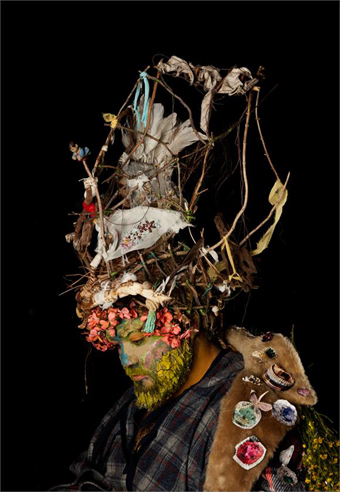
Shan Turner-Carroll, Shan, from the series Primal Crown, 2012, HATCHED National Graduate Show, 2013, PICA
image courtesy the artist
Shan Turner-Carroll, Shan, from the series Primal Crown, 2012, HATCHED National Graduate Show, 2013, PICA
Each year in the Arts Education issue of RealTime, we feature works that catch our eye by recent graduates, often sourced from the annual HATCHED National Graduate Show, presented by PICA in Perth.
Our intriguing cover image is by Shan Turner-Carroll, a Fine Arts graduate from the University of Newcastle, winner of the prestigious Dr Harold Schenberg prize at this year’s HATCHED. In a new take on the portrait, Turner-Carroll displayed a series of “makeshift crowns for his family made from found objects that hold personal significance—relics embedded with present memories and future thoughts” (catalogue). Recently returned to Australia after traveling to his ancestral homeland of Myanmar where he met with local artists and curators and exhibited at 7000 Padauk, a contemporary art space, Taylor-Carroll is currently looking at producing a body of work responding to his time there.
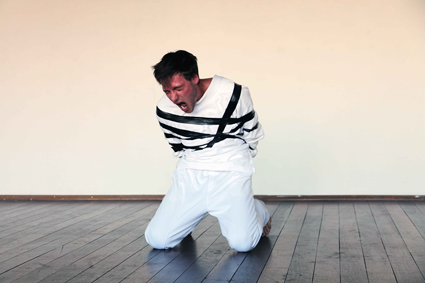
Alex Wolman, Brief Candle, 2012; Hatched: National Graduate Show 2013, Perth Institute of Contemporary Art
photo Maren Jorgensen
Alex Wolman, Brief Candle, 2012; Hatched: National Graduate Show 2013, Perth Institute of Contemporary Art
For our education feature profile a further two HATCHED artists. In his hour-long performance Brief Candle, Alex Wolman, currently completing an Arts History degree at the University of WA, gives us the body in extremis, freeing itself from bonds and shouting until it’s hoarse. Wolman “sees the body as a sensitive and articulate yet deeply flawed medium through which to interact with the world, and is captivated by the thought that every human has one. In this he sees a unique opportunity to utilize a medium that is at once both familiar and strange to all” (catalogue).
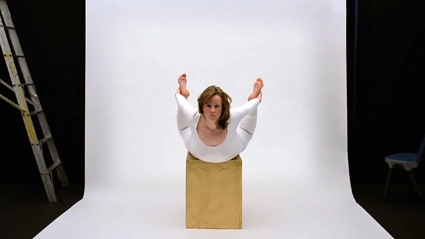
Jen Broadhurst, Abstract Feminism, Historical Construction, 2012; Hatched: National Graduate Show 2013, Perth Institute of Contemporary Art
The work of Jen Broadhurst (Fine Arts/Painting, Monash University) is less visceral but just as sharply focused on the body. She says, “As I have developed my practice I have become increasingly influenced by Feminism and Formalism.” Predominately video-based, with performance as a key element, Broadhurst’s works propose “a dialogue between certain feminist concerns, such as idealisation, perfection, objectification and neo-maternalism and how these ideas have manifested throughout art history” (catalogue).

Caitlin Franzmann, Courtney Coombs, Focus, 2012, Fresh Cut exhibition
image courtesy the artists and IMA
Caitlin Franzmann, Courtney Coombs, Focus, 2012, Fresh Cut exhibition
On page 2, the image is from Focus by Caitlin Franzmann, an interactive installation developed in collaboration with Courtney Coombs during a Backdoor Gallery residency at Room60 and featuring in Fresh Cut, this year’s IMA exhibition of emerging artists. Franzmann completed a Bachelor of Fine Art (Honours) in 2012 at the Queensland College of Art, and recently has been awarded an Australia Council Artstart Grant. “Focus…literally positions the audience to face one another in close proximity and focus on the act of making or not making direct eye contact. The sound component of the work focuses the individual experiences of the participants; one helmet directs attention to the act of looking, the other heightens the awareness of one’s self being looked at” (Rachel Parsons, catalogue). RT
HATCHED: National Graduate Show, 2013, PICA, Perth, 20 April-9 June; Fresh Cut, 2013, IMA, Brisbane, 3 August-21 September
RealTime issue #116 Aug-Sept 2013 pg. 10
© RealTime ; for permission to reproduce apply to realtime@realtimearts.net
As the afterglow of ISEA2013 in Sydney begins to fade it’s a good time to reflect on where media art, an area of practice that has always been inextricably linked to the academy, is headed at the outset of the 21st century.
While ISEA2013 was a dynamic gathering of innovative practices, it also highlighted a significant turning point. Occurring 21 years after TISEA in Sydney—remembered fondly as celebrating the beginning of ‘new’ media art in Australia—maybe ISEA2013 marked the end of this first idealistic epoch. (See RealTime’s Media Art Archive which charts the development of media art practices over this time.)
The idea of ‘newness’ in media art was discarded around the turn of the century/millennium. Given the ubiquity of technology in our lives and the rise of a generation who have grown up switched on and plugged in, is the idea of media art as a distinct form still meaningful at all? (There are, of course, some who would argue it never has been.)
If we look at the relevant funding arm of the Australia Council and its morphing nomenclature, the term ceased to be meaningful in 2005 with the disbanding of the New Media Arts Board in favour of an inter-arts blend. As of May this year, we enter the more expansive, though perhaps more elusive territory of the ‘experimental and emerging.’ This latest change brings back the idea of the ‘new,’ associating it directly with the ‘art,’ leaving the ‘media’ open to interpretation.
So what are the ramifications for education in this area? Are institutions leading, following or fighting this shift away from media as a specific medium towards a more general emphasis on ‘new’ and ‘experimental?’ I interviewed Associate Professor Paul Thomas, from the College of Fine Arts [COFA], University of NSW and asked several key academics from universities around the country, teaching in both fine arts and media studies, for their thoughts on what might constitute a utopian education system for their area of practice.
Demolishing the silos
Paul Thomas’s career trajectory is an interesting case in point. Thomas is one of the early advocates and pioneers of electronic arts, co-founding the group Media-Space in Perth in 1981. He went on to found and direct the Biennial of Electronic Arts Perth [BEAP] as well as developing the Electronic Arts course at Curtin University. Now at COFA he is Head of Painting. Thomas says, “The whole rise of technology, the input of technology into the art school became a misguided direction. It’s just another layer of complexity in the potential to construct and make art.” He believes that as technology has become more ubiquitous, as computers and digital cameras have become part of everyone’s daily expression, students don’t “see why it would be a separate subject. It’s just part of the way they make art.”
Thomas is now working with the idea of the transdisciplinary rather than interdisciplinary. “Interdisciplinarity is part of the major problem of the silos. We say you can do anything you like in media arts, you can paint, you can sculpt, you can make installations and so on, and sculpture and painting would say the same thing. So if everyone is saying this, why don’t we have one course instead of all these different courses?”
Dr Gavin Sade, Head of Interaction and Visual Design at the School of Design, Creative Industries, QUT in part agrees: “Any ideal program would be transdisciplinary in nature—not just multidisciplinary through a combination of classes drawn from within essaying faculty silos, but instead a dedicated curriculum designed by academics with an interest across disciplines.”
Science, the new/old frontier
Sade believes “the challenging question is the importance of media art education. For me the most interesting aspect of media arts is actually the intersection of art and science which occurs within the media arts community as seen for example in the publication Leonardo.” Sade suggests a more complex relationship between the arts and science based on the idea of difference. “Value needs to be recognised beyond instrumental readings of Art as an input for innovation, or Art as a form of visualisation of scientific data.” He seeks “development focused on the difference and similarities of art and science and an appreciation that it is from the difference that new knowledge emerges.”
Thomas is of the same mind. “We’ve shifted away from the media arts and back into arts and science. [Our] understanding of the state of the world, how we deal with different concepts of reality, nanotechnology, how atoms work, how matter is formed [is] becoming a new materialism…There are a number of possibilities to explore the world and the university has a lot of them on its doorstep; so how do we access the sort of atomic force microscopes, the biological and chemistry areas, the spatial sciences?”
Australia does boast a leading example of this art-science fusion, the first of its kind in the world, at the University of Western Australia. SymbioticA was established in 2000 by Professor Miranda Grounds, Dr Stuart Bunt and Oron Catts, offering hands-on laboratory access for artists researching in the areas of art and biology, ecology, bio-ethics, neuroscience, tissue engineering and sleep science. It seems that utopia may lie in the development of more laboratory/studios such as these.
Cutting red tape
Dr Mark Cypher, Senior Lecturer and Academic Chair, Digital Media at Murdoch University, also expresses the desire for a transdisciplinary approach which he sees is currently hampered by bureaucracy and inflexible infrastructures. His utopian wish-list includes: “access to disciplines across campus IT/design/art/science/engineering without the politics; university infrastructure and teaching spaces that enable a wide range of teaching practices rather than chalk and talk or lab models; easy national and international university partnerships and collaborations; and a system that enables the diversification of university funding models rather than relying on bums on seats (student numbers) with a churn and burn mentality to education.”
Pedagogy and the internet of things
A common desire from these academics is for the realisation of total connectivity and subsequent access to ever more vast amounts of information. Katie Cavanagh, course co-ordinator of the Bachelor of Media, Department of Screen and Media, Flinders University shared the story of the first time a student appeared to be ‘fact checking’ her lecture on his iPad. After initially feeling nervous about the idea of being “exposed” she came to the conclusion “that he wasn’t distracted by his iPad, he was entirely immersed in everything we were discussing.” Cavanagh sees future teaching methods as incorporating “live discussions where all threads are visited [online] and the experiential multi-tentacled intermingling of knowledge, research, interaction and discussion in class becomes a critical organic part of every unique lesson.”
Cypher and Dwyer also emphasise the potential of easily accessible online information via what Cypher terms “an open Internet…that enables access to meta-data about all things all the time.” Dwyer gets specific, suggesting a database of interactive projects via something like YouTube: “We could see the code, how a new project co-opts existing projects and the mistakes. The teaching possibilities would be amazing.”
Pragmatic futures
Natasha Dwyer, Senior Lecturer in Multimedia at the Victoria University, offered thoughts on the employment landscape for students: “I hope that one day the word ‘entrepreneur’ can lose its status as a ‘dirty’ word…The fact is that industry is changing (for better or worse) and all types of people in the creative industries such as media arts will need to find their way on unproven paths. We need to be able to help students navigate this competitive environment and somehow inform the shy, the unassertive and others without the ‘entrepreneurial image’ that they too can find a place.”
So who is inhabiting this utopian education environment? Paul Thomas sees the utopian student as a kind of “transdisciplinary nomad.” He asks, “What would this student need if they were to land anywhere in the university, to engage from an arts point of view.” His answer brings us back to the basics of a creative education: “The ability to think, the ability to make and play.”
Whether it’s old or new, trans, inter or hybrid, it seems that these basic creative principles remain immutable.
RealTime issue #116 Aug-Sept 2013 pg. 12
© Gail Priest; for permission to reproduce apply to realtime@realtimearts.net
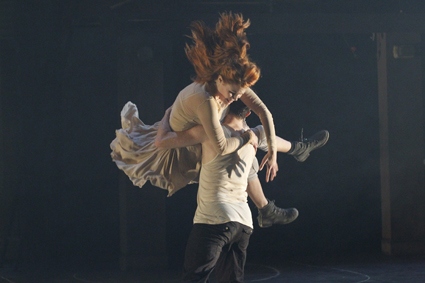
Andrew Carolane, Annabel Marshall-Roth, Article One devised by Bagryana Popov in collaboration with Acting Company 2012, School of Performing Arts, VCA, University of Melbourne
photo Jeff Busby
Andrew Carolane, Annabel Marshall-Roth, Article One devised by Bagryana Popov in collaboration with Acting Company 2012, School of Performing Arts, VCA, University of Melbourne
The university can be a haven for the developing performer, a place to learn, fail, experiment and take risks. It can be a site for safe creative interplay between students, lecturer performance makers and experienced artists seeking postgraduate refuge in which to reflect on their careers and to be challenged.
I asked teachers to share utopian visions for the training of students. It was clear they believed they were already achieving much, above all a sense of community, the transmission of expertise, intergenerational exchange and many ways of thinking and making, above all collaboratively, in an increasing range of forms. The common utopian wish is to make the student experience even more experiential, more immersive and more directly related to the industry in which students hope to be employed or, more importantly, that they will in the long-term create, having been trained to be inventive, flexible and independent.
In this scenario, industry comes to the theatre and performance school, participates in projects and recognizes, as Helen Trenos of the University of Tasmania puts it, that students are in fact emerging artists. As Flinders University’s Julian Meyrick argues, It’s time to get some solidarity back into our profession. To remember, that it is a profession, a lifetime’s commitment, not just a market niche…”
Meyrick urges “real thinking in an ideal vein” rather than ‘utopian,’ while Peta Tait at La Trobe University worries that inconsistencies in the tertiary sector risk making the sustained teaching of performance uncertain, with ramifications for the whole industry.
Melanie Beddie, Robert Walton, VCA Theatre
VCA Theatre Lecturers dramaturg Melanie Beddie and playwright Robert Walton emphasise the opportunity in the BFA (Bachelor Fine Arts, Theatre Practice) for students “to enter a community of extraordinary theatre artists all in the process of learning by doing and making.” The “comprehensively trained actor,” they believe, “will ultimately bring about change and improvement in their art form.” At the same time each will continue “to grow as a performer and theatre maker throughout their working life.”
This optimism is predicated on the belief that “the best makers of theatre have emerged from a context of understanding performance through an experiential immersion in it. In other words an embodied dramaturgy. We focus on enabling each year of actors to work well together. Of key importance is the ability to collaborate. The development and practice of the individual’s agency within the group is paramount.”
Beddie and Walton’s approach extends to a political vision: “When they work well, collaborative ensembles can offer models of alternative society, of sites of resistance, anarchy, radical democracy and inclusion. Staff and students repeatedly ask themselves Brecht’s question “what would you do to make the world a better place?” You can’t wait for some fabled time when you will be ‘ready’ to be an artist: rehearsals are never long enough, you could be more skilled, and there is always greater insight just around the corner. We look to the world and respond with what we have, wherever we are in our training. The practice of being an artist starts now: responding extraordinarily with what you have to hand.”
Rather than offering a ‘personal utopia’ of “becoming famous, becoming ‘someone,’” what Beddie and Walton say the VCA offers “is a set of skills that can allow people to live a life seemingly doing what they enjoy. In Marxist terms, working hard but not toiling. Creating standards of good work for oneself and choosing to live up to them is hard. Shouldn’t utopia be easy?”
Rosalba Clemente, Flinders University
Head of Acting and theatre director Rosalba Clemente declares from the outset, “I am not really into utopian visions but more interested in what is possible—what we can do rather than what we can’t…Students need mostly to work with the absolute best practitioners who have articulated, strong working processes and something to actually teach and know how to teach it—how to help students execute their ideas in three dimensional space—this is a huge task.”
As our surveys of film and media arts education indicate, there is a desire for greater connection between schools and their respective industries. For Clemente that would involve an intensive artists’ residency program: “It would be wonderful to have theorists and practitioners working closely with students in an artistic community—made up of playwrights, devisors, directors, actors, designers—being trained towards the making of new work and how to participate in varied processes, dramaturgical and otherwise. In an ideal world one would then have all the production assistance, including high level digital media etc [required] to realise the work—a way to fully test the ideas.” Clemente wonders if “state and federal agencies could fund a revolving schedule of resident artists to work with schools to make a new work a year, teaching and utilising students throughout.”
On the other hand, Clemente is in no doubt that already “we stimulate our students across our theory and practice units to examine many ways of making work. The Co-Creation unit in the acting course aims to stimulate the actor as dramaturg and creator. It would be great to do more of this work. And more…”
Helen Trenos, University of Tasmania
Helen Trenos is Program Director for Theatre in the Visual and Performing Arts faculty at the University of Tasmania. In an exciting move, analogous to the creation of WAAPA’s graduate dance company LINK, Trenos says, “We are currently working towards the formation of a graduate company comprising our Honours and Postgraduate (MFA and PhD) students…to provide students with the opportunity to showcase their own works as well as enabling professional theatre/performance practitioners to work with students to realise a script or devised work.”
Beyond what one could already regard as a utopian move, Trenos, like Rosalba Clemente, would like “the Australia Council and state funding bodies to establish a grant scheme for professional mentors working in tertiary contexts. Professional mentoring is enormously important for emerging artists and university students should not be exempt from this category. They are emerging artists. Mentoring can be equally enriching for those professional artists sharing their expertise and skills.”
Cath McKinnon, University of Wollongong
Playwright and Lecturer in Performance, Cath McKinnon delineates the approach to training in the University of Wollongong’s School of Creative Arts: “we offer different approaches to the development of new work: creating and workshopping original texts; re-writing classic texts; mashing up texts; collective devising from research. Our push is on students developing skills in several areas so that when they leave they can self-start projects.” The aim is “to teach students how to develop an aesthetic and critical conceptual plan that will frame their mad cultural dreams, desires, passions, interests, so that their audiences can engage with a theatrical or film project in ways that are fun, meaningful, whimsical, real, truly felt, exhilarating. We also want our undergraduate students to connect with our postgraduate students, so that they have the opportunity to influence each other. We aim to create a post-graduate ‘space’ that offers writers and devisors reflective time-out from the industry. A place to regenerate, engage with other artists, ponder where they’ve been and where they want to go.”
As for utopia, McKinnon would like to see “the development of a wider cultural environment where the university is the hub (or one of the hubs) of new theatrical or film work; where the university links those just emerging into the industry (undergraduate) and those coming back to the university for some reflection time (post graduate), with the industry itself.” This, she thinks, would develop an environment of “critical collaboration and celebration” where “critical and aesthetic responses to what is happening around us locally and globally are connected in a way that resonates with audiences…In an ideal world the community and various government bodies would celebrate this emerging stage [for students] and support financially those universities whose major concern is training and mentoring writers and performance-makers…”
Peta Tait, La Trobe University
At a time when mining corporations and their ilk demand ‘certainty’ from governments, the creative arts in universities frequently suffer uncertainty. Writer, playwright and editor Professor Peta Tait writes, “My utopian wish is influenced by recent developments at the National Institute of Circus Arts which threaten the continuation of NICA’s degree course and its unique and irreplaceable training opportunities, and my observations over years of how courses in performance have been threatened or weakened or disappeared overnight.
“I want to see studies and training in the arts in the university sector respectfully and appropriately maintained by all tertiary institution managements so that students continue to receive a high level of teaching and learning across a diverse range of art forms.”
Tait argues that a consistent approach is vital not just for students but for the industries “reliant on the graduates from courses offered in the tertiary sector. Therefore a university cannot be allowed to suddenly change direction and/or reject responsibility for a vital area of cultural activity. There is such a wide variation in the approaches of different university managements to artist training even within a single university, and given how crucial this is for Australian culture as a whole, I want to see study and training in the arts guaranteed reliable specialist decision-making which is transparent and consistent over time. The arts need self managed approaches to study and training that fully recognise what is needed to create an artist.”
Julian Meyrick, Flinders University
Writer, director, theatre scholar and now Strategic Professor of Creative Arts at Flinders University, Julian Meyrick argues,“The ‘new’ in and of itself is not accessible as an intelligible performance result except through new relationships” between processes and product. “Everywhere we see something ‘new’ claimed by an old configuration of order, we find a ‘look’ only. Today’s theatre is very good at looking new when, underneath, it’s nothing of the sort.”
If without indicating what the acceptably ‘new’ might look like, Meyrick turns dialectically to the past: “we also need to step back, to identify axioms and foundations, to draw strength from our history, tradition, and lines of generational transmission…It’s important as part of a living conversation that asks us to interrogate our practice as part of an on-going, collective project. That asks us to be more than just individual producers hawking our wares in a saturated cultural marketplace.”
Like Beddie and Walton, Meyrick believes, “We need to equip students with a sense of what the field is actually like but also with the courage and consideration to effect change within it. Utopian thinking alone is not enough. It just feeds fantasies of personal difference—feeds the cultural marketplace. Another generation of industrial fodder would be a disgrace. It’s time to put a little hope back into the system by fostering the possibility of real transformation.” Meyrick suggests that “This double movement—of forwards into the future and backwards into the past—can only come about through a broad and inclusive conversation.” Such a conversation is vital given that artists “have been played off against each other to general defeat. It’s time to get some solidarity back into our profession. To remember, that it is a profession, a lifetime’s commitment, not just a market niche….”
* * * *
Here is the full text of Julian Meyrick’s response.
Historians joke ‘all ages are ages of transition.’ Theatre and performance-making is ephemeral in the strictest sense of that word, so naturally the processes they use, the things that get made and the values linking the two are also in a constant state of flux. What should be our response to this as educators?
It should be two-fold. On the one hand, we should be reaching out to new ideas and possibilities. To new relationships, in other words. The ‘new’ in and of itself is not accessible as an intelligible performance result except through new relationships. Everywhere we see something ‘new’ claimed by an old configuration of order, we find a ‘look’ only. Today’s theatre is very good at looking new when, underneath, it’s nothing of the sort.
On the other hand, we also need to step back, to identify axioms and foundations, to draw strength from our history, tradition, and lines of generational transmission. In the Australia context, this is a revolution of thought, a radical and usually unwelcome insistence that the past matters. And it does, though not in the way its detractors fear. The past is not important in itself. It’s important as part of a living conversation that asks us to interrogate our practice as part of an on-going, collective project. That asks us to be more than just individual producers hocking our wares in a saturated cultural marketplace.
This isn’t the time for ‘ideal thinking’ in my view, but for ‘real thinking in an ideal vein.’ That sounds complicated, but it’s a simple thought. We need to equip students with a sense of what the field is actually like but also with the courage and consideration to effect change within it. Utopian thinking alone is not enough. It just feeds fantasies of personal difference—feeds the cultural marketplace. Another generation of industrial fodder would be a disgrace. It’s time to put a little hope back into the system by fostering the possibility of real transformation.
This double movement—of forwards into the future and backwards into the past—can only come about through a broad and inclusive conversation. I am tired of one kind of creative practice being ranked over another, one kind of artist over another. The proclaimed tolerance for diversity just leads to shorter shelf lives for hard-won aesthetics, a higher churn rate of creative practitioners. We have been played off against each other to general defeat. It’s time to get some solidarity back into our profession. To remember, that it is a profession, a lifetime’s commitment, not just a market niche.
We need to look at the politics of our creative practices, not in the sense of being over-determined by non-creative goals, but in being mindful of the forces of the contemporary world that militate against the true artistic life. And there are many. We need to discover not ‘our individual market difference’ but our collective, professional vision. We need to discover what it is to be artists.
Julian Meyrick is Strategic Professor of Creative Arts, Flinders University
RealTime issue #116 Aug-Sept 2013 pg. 14,16
© Keith Gallasch; for permission to reproduce apply to realtime@realtimearts.net
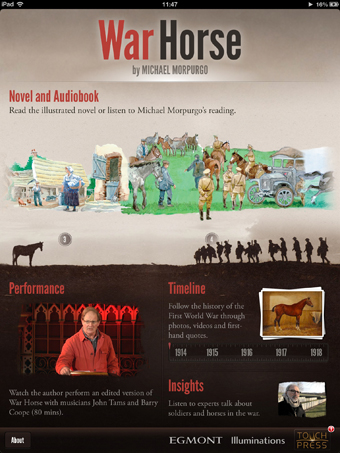
Michael Morpurgo’s War Horse App
With the migration of readership from paper to the e-page, there’s a tide of change in publishing and writing outcomes. But university Creative Writing departments seem reluctant to deal with it. They’re not yet thinking seriously about the fiction and nonfiction of the future. Not even the near future. They’re not yet designing infrastructures for it. When paper publishing is a thing of the past, there’s a danger they’ll still be teaching writing for the past.
Learning the skills of writing for the future already involves the novel as app. An example of the form is this year’s Bologna Children’s Book Fair prize-winning version of Michael Morpurgo’s War Horse. This interactive book produced for the iPad is published jointly by children’s publisher Egmont and Touch Press. The blurb says:
“At the heart of the app is the complete text of the novel, together with an unabridged audiobook reading by the author. Alongside the text sits a Timeline which tells the real story of the First World War through documents, maps, photographs and film. As in the novel, the war is seen from both Allied and German perspectives, with professionally narrated first-hand quotes and over 200 original photographs to bring you closer to the soldiers’ experience.
“The Insights section presents 34 video interviews with historians, experts and the author, which shed light on the inspiration for the book and its historical setting… There is also an exclusive, 80-minute live filmed Performance of War Horse which completes this rich digital experience…The performance includes synchronised transcript and song lyrics. The Performance and Insights can also be streamed full screen to AppleTV.”
So, it’s a fictional, non-fictional, performance, musical and historical work, and it’s exegetical. It’s richly illustrated with photography, graphics and digital cleverness. It boasts various performers, including the author, and has a number of music soundtracks. All it costs is $6.99.
Children are growing up reading books like this. There are many picture storybook and young reader examples. Experimental novelists too have embraced the app. It has been said that the older, conservative generations are grieving over the passing of the paper book, and are still in the first stage of that process—denial. What they also deny is the brilliant future of the book. The War Horse app novel, and others like it, indicate exciting opportunities for reading, for multidisciplinary teaching and for creative writing.
But Creative Writing courses have not caught up. Creative Writing courses have been so excited about actually getting accreditation (and high enrolment numbers) in almost 40 universities in Australia, they have forgotten to think about how radically writing is changing. Ironically, the rise of Creative Writing in Australian universities in the 1990s and 2000s coincided with the rise of the computer and the internet, and especially, the concept of interactivity. Hypertext showed readers that the reading process did not have to be passive. Of course, it never had been actually so—reading was always about interacting—reacting with one’s intellect, imagination and emotions. But hypertext extended the possibilities beyond the limits of the bound-at-the-spine, ink-marks-on-paper, MONOgraph book as we knew it.
Hypertext expanded the book into realms which previously involved further and separate acts of production—the incorporation of visuals, the adaptation to performance, the addition of commentary and glossing mechanisms. All of which required processes of their own—that is: creativity, research and production classified as other than the book. With hypertext, however, illustration, the play or film based on the book, the talking book, the index or concordance and exegetical/critical discussions of the book can be part of the book itself.
Clearly now, the digital book can contain what was previously called research for, adaptation of and extension to the text. This is the new definition of the book—a multi-modal, multi-disciplinary, multi-artform entity. A multigraph, not a monograph.
Strangely, though, I haven’t yet found my students turning up in first year wanting to write the digital book. They actually say they want to be published on paper—they see it as somehow prestigious or authentic—and they don’t say they want paper publication because of the JK Rowling or Suzanne Collins multi-millionaire factor.
For the app-savvy, it seems, paper publishing retains a status that relates to university as a place to learn to write very much better, as opposed to just doing it yourself. I tell my students how excited I am about who will write the first Young Adult novel to go to the top of the charts: it will be done by one of their generation—an app novel about an emerging boy/girl/both band that has soundtrack and clips included. I wish I’d had such a possibility in my future when I set out as a young writer. They look at me askance, maybe just a glimmer of the future in their eyes, when I say things like, “Why don’t you write a multi-modal novel on your tablet? It’s got a keyboard, a camera and a microphone pick-up.”
The future of writing, reading and teaching new books—including how to write them—will be multidisciplinary, multi-arts and cross-arts. The best department for a Creative Writing program will be a Creative Arts department where performance, visual arts, digital and new media arts and music are also taught. Maybe English should be housed there too: the unreconstructed English Department persisting now may otherwise need to be split with History and Philosophy. While donning my bullet-proof vest, I’m also inclined to say that the English PhD is dead, and that from now on it must get multi-arts oriented. Perhaps every doctoral submission in English should include a creative product—a work which shows that knowledge about reading has been fully learnt and extended.
Creative writing courses of the future need to teach many more processes than they do today in order to prepare students for the brave new world of 21st-century fiction and nonfiction.
RealTime issue #116 Aug-Sept 2013 pg. 16
© Nigel Krauth; for permission to reproduce apply to realtime@realtimearts.net
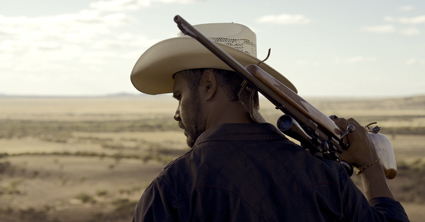
Aaron Pedersen, Mystery Road
photo Ivan Sen
Aaron Pedersen, Mystery Road
It begins when a long-haul truck driver discovers a body at night, in an ominous, visually arresting sequence that sets the tone for what will follow. There’s a dark, seemingly endless highway, street signs (“Mystery Road,” “Massacre Creek”) which hint at a locale with a troubled history, and the Australian outback at dusk: the driver’s torchlight a tiny accent in the darkness.
This is Ivan Sen’s third feature, following Beneath Clouds (2002), a road movie of sorts about the developing relationship between two Indigenous teenagers with markedly different desires, and Toomelah (2011), a window onto a young boy’s life in the former Aboriginal mission, with a cast almost exclusively composed of local non-actors.
While Mystery Road occupies similar social and geographic territory to these films, it differs from them firstly in its use of a predominantly seasoned cast, and secondly in being primarily a genre work which cleaves with great respect to the conventions of the murder mystery, with its narrative lynchpins of the obstructive community harbouring a secret; the detective-outsider; and the dogged, methodical pursuit of the truth. Like the best detective stories, however, it presents us not only with a mystery, but with an unfolding portrait of a particular community and place.
Aaron Pedersen plays the film’s central character Jay Swan, the only Indigenous police detective in his outback home town. Assigned to investigate the murder of the Aboriginal girl whose body is discovered at the film’s beginning, Jay embarks on what amounts to a one-man investigation, caught between an Indigenous population which has rejected him and colleagues he distrusts. Almost every scene in the film is a one-on-one interaction between Jay and an alternating cast of possible witnesses, suspects, family members and fellow cops (the boundaries, as one would expect, are blurred).
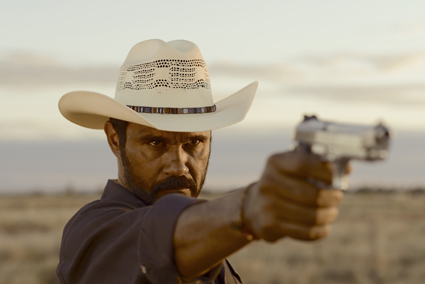
Aaron Pedersen, Mystery Road
photo Ivan Sen
Aaron Pedersen, Mystery Road
Sen emphasises the significance of these encounters by subduing background noise to near silence, with the result that faces and voices take on an almost unnatural clarity. Every exchange is a piece of the puzzle, and the viewer is encouraged to watch vigilantly. This wouldn’t work without the committed performances of Mystery Road’s cast, an impressive concentration of Australian character actors which includes Tony Barry, Hugo Weaving, Jack Charles, Tasma Walton and Jack Thompson. Pedersen leads them in a strong, understated performance as the conflicted Jay, a contained man whose gaze is constantly wary, but who also projects sincerity and dependability.
With its small-town setting, cowboy cops and a good guy in pursuit of justice, Mystery Road has more than a hint of the Western as well as the whodunnit. Visually, it’s as clearly delineated as a graphic novel, displaying a predilection for close-ups and figures silhouetted against sunset landscapes. A recurring aerial sequence shows the geometric streets of the town as Jay drives to houses of potential witnesses. Sen’s skill as an all-rounder (he was DOP as well as writer and director of the film) is clearly apparent. Where Mystery Road falls down slightly is in its function as a detective story. Every scene might be a piece of the puzzle, but not all of these pieces are put together at film’s end, particularly the portentous references to wild dogs which recur throughout but are never satisfactorily explained.
Overall, however, Sen has employed the framework of the whodunnit to create a striking piece of cinema whose stylisation enhances rather than overshadows this story about a misfit cop probing a town with a rotten, racist core.
–
Mystery Road, writer-director Ivan Sen; director of photography, editor, composer Ivan Sen; producer David Jowsey; Arclight Films; released 17 October
RealTime issue #116 Aug-Sept 2013 pg. 18
© Katerina Sakkas; for permission to reproduce apply to realtime@realtimearts.net
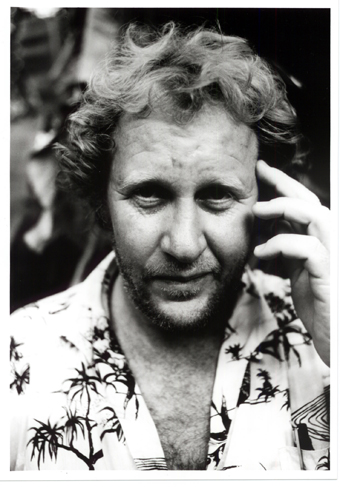
Dennis O’Rourke (1988), during the making of Cannibal Tours, released as free content with permission of Dennis O’Rourke, photo Chris Owen & Camerawork Pty Ltd
I only ever saw him once in the flesh, but I’ll always remember Dennis O’Rourke sitting in the audience at an Australian International Documentary Conference (AIDC), dominating the room with his sheer presence. He wasn’t part of the panel that day, but when he put his hand up to speak, the entire crowd turned to listen. Provocative, emotional and fiercely intelligent, O’Rourke was always worth listening to—and always worth watching. With his death on June 15, Australia lost one of its most incisive and imaginative documentarians.
O’Rourke began his career at the ABC in the early 1970s, making his first documentaries in Papua New Guinea and tracing the initial years of independence for our northern neighbour. Several of these works, like Yumi Yet (1976), brought O’Rourke international acclaim.
Throughout the 1980s he explored the domination and exploitation of Indigenous peoples across the Pacific in extraordinary films such as The Shark Callers of Kontu (1982), Half Life: A Parable for the Nuclear Age (1985) and Cannibal Tours (1988). Half Life is the most horrifying of these, with its images of children deformed by US nuclear testing in the Marshall Islands. But where contemporaries like Bob Connelly and Robin Anderson adopted a more detached, observational perspective in framing the legacy of colonialism, O’Rourke’s work was always distinguished by his reflexive interest in the act of representation itself.
Half Life, for example, sets its disturbing images of the effects of nuclear testing against US-made documentaries about the Marshall Islands from the 1950s. These films blithely described the islanders as “savages,” too simple to comprehend what was being done to their homes by the US military, and grateful for the medical testing to which they were subjected by a magnanimous US government. The jaw-dropping racism of these old documentaries makes clear that the exposure of the islanders to nuclear fallout was not an accident, as was claimed at the time, or even an aberrant lapse of respect for human life on the part of the US authorities. Rather, it was the logical outcome of an entire world view and attendant system of representation that defined white American ‘civilisation’ as human and Indigenous cultures as primitive, disposable leftovers of an earlier age.
The question for O’Rourke in all this was the place of his own camera. Could he position himself as a critic of an imagistic order that has always privileged the white, Eurocentric gaze? Or was he, as a white, camera-wielding Australian, part of the problem?
These questions lurk around the edges of films like Half Life, The Shark Callers of Kontu and Cannibal Tours, but the ambivalence of O’Rourke’s relationship to the documentary form developed into a full-blown crisis in his most controversial and best known film, The Good Woman of Bangkok (1991). In the aftermath of the breakdown of his marriage, O’Rourke set out to form a relationship with a Thai prostitute, paying her to participate in his film. Together they created a “documentary fiction” that placed their relationship at the centre of the microcosm of global inequality that is Bangkok’s red light district, where cashed-up white tourists enjoy cheap sex with impoverished women from Thailand’s rural areas.
Good Woman still has the ability to divide audiences more than two decades on. At the time, many were incensed. O’Rourke was roundly condemned in print, and sometimes in person, by festival audiences convinced that he had exploited his subject. The storm inspired a whole book of essays on the film and the controversy it engendered (The Filmmaker and the Prostitute, Power Publications, 1997). As Linda Williams points out in one of that volume’s most perceptive pieces, many of the audience responses revealed far more about Western documentary viewers—and the unconscious assumptions informing our worldviews—than they did about the film itself.
Further controversy awaited O’Rourke with the release of Cunnamulla in 2000 (RT41, p14) a searing portrait of life in a small Queensland town. With its frank discussions of casual teenage sex, it made for another discomforting experience.
His last completed film, Landmines—A Love Story (2004), was more conventional in its approach, but continued O’Rourke’s fascination with the gap between the material reality of life in developing countries and the way we represent it on screen. The film focused on a couple in Kabul, both missing limbs due to landmines left over from Afghanistan’s many wars. Interspersed with O’Rourke’s observation of their daily lives are old military documentaries extolling the virtues of the landmine as a weapon of war.
No Australian filmmaker, and few abroad, have matched O’Rourke’s sensitive dissection of the relationship between rich Western countries and the world’s poorer nations. Uniquely among Australian directors, he also interrogated the long history of documentary images helping to maintain these global relations of power by fixing and dehumanising the racial ‘other.’ At a time when images are once again playing an integral role in demonising those from faraway places, and helping to justify spectacular cruelty in the name of “border protection,” we need critical filmmakers like Dennis O’Rourke more than ever. Alas, O’Rourke himself can no longer help us.
RealTime issue #116 Aug-Sept 2013 pg. 19
© Dan Edwards; for permission to reproduce apply to realtime@realtimearts.net
The best historical documentaries blast history out of the past and make us re-experience it as a living present, pregnant with possibility, rife with contradictions. Less critical documentaries simply reduce history to a smug justification for the way things are today. Paul Clarke’s two-part Whitlam: the Power and Passion, recently screened on the ABC, falls squarely in the latter category, telling us more about our impoverished contemporary political sphere than it does about the 1970s.
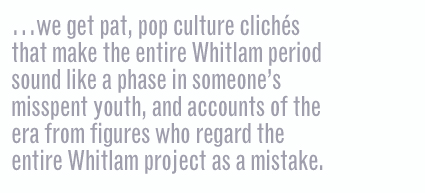
Take the depiction of the period from which Whitlam emerged. One of the distinctive features of the Australian Labor Party under Whitlam was the broad church of ideas the party encapsulated, but you wouldn’t know this from viewing Clarke’s film. The senior leadership of the late 1960s and early 70s included everyone from deeply religious, conservative figures like Kim Beazley Senior to stalwarts of the New Left like Dr Jim Cairns. The fact that Labor encompassed such wide-ranging ideas made it a powerful force for social change. Whitlam’s ability to hold such a grouping together was certainly indicative of the charismatic sway he held over the party and his inclusive approach, but there’s a lot more to the story. In Clarke’s hands, the rich cultural, social and intellectual context of the period was reduced to a colourful backdrop for Whitlam’s personal journey, summed up with a few pop culture clichés such as images of the Beatles and whispered tales of sexual debauchery in the outer suburbs. Ironically, for a film about a politician, there was very little about politics—unless you define politics as a personality contest rather than an arena of ideas.
Although Clarke managed to sidestep any serious consideration of the broader context within which Whitlam worked, even his ‘great man’ approach to history was grossly undermined by unnecessary re-enactments scattered throughout the film. While adding nothing to our understanding of events, these interludes made Whitlam look like precisely the kind of boring, grey politician he wasn’t. Of his learning, elegance and wit there wasn’t the slightest trace.
Whitlam’s attributes were more in evidence in the archival clips of the man himself, speaking at rallies and on television. Watching these brief glimpses of Whitlam in action, it was striking just how far our political discourse has fallen. While present-day leaders treat the electorate like distracted five year olds incapable of digesting anything more than repetitive soundbites, Whitlam actually listened to questions from journalists and attempted to provide considered, intelligent answers. Many did not agree with what he said, but he undeniably said something. Clarke’s rapid-fire approach left little room to explore this startling—from a contemporary perspective—aspect of the Whitlam era. Each time we saw archival footage of Whitlam addressing a question, Clarke cut away within a few seconds, exhibiting the same lack of faith in his audience’s ability to concentrate as our current generation of politicians.
The unrelenting focus on Whitlam also reduced other key figures of the period to bit players, often sketched with little more than condescending platitudes. This was most striking in the portrayal of Jim Cairns, a man who came within one vote of leading the ALP in 1968. There is no doubt Cairns was a complicated, flawed man who ultimately disappointed even many of his closest followers. At the time, however, he was a major figure in Australian public life, who opposed the Vietnam War from its earliest days and who argued his case painstakingly in various books and pamphlets. He was a central figure in the Moratorium Movement, a role completely effaced in Clarke’s documentary. Most importantly, Cairns exhibited a level of compassion in all he did that puts current politicians to shame. In Clarke’s film, Cairns was reduced to the inconsequential, libertarian buffoon he’s been characterised as ever since his fall from grace, neatly forestalling any consideration of his actual ideas or popularity at the time.
The marginalisation of Cairns is indicative of Clarke’s treatment of the entire ALP left, most obvious in his choice of interviewees. The politicians we heard from were nearly all right wingers who have been instrumental in dismantling Whitlam’s legacy. Bob Hawke, the leader who transformed the ALP into a centrist party with neo-liberal economics as its guiding philosophy, was one of the key Labor voices, yet he wasn’t even a part of the Whitlam Government. Liberals like arch-conservative John Howard, who had very little to do with the events of the Whitlam era, were given free rein to rehash the standard narrative of Whitlam’s “disastrous” government. Other interviewees, such as Andrew Denton, were simply irrelevant. In contrast, one of Whitlam’s most able and prominent ministers, Tom Uren, made one passing appearance and was never heard from again. Is it a coincidence that Uren was also of the ALP left, whose defence of the Whitlam project would no doubt be anathema to those who now control both major parties?
The interviewees may have been the result of Paul Clarke’s choices, but it’s hard not to see the perspectives offered in the film as reflecting the ABC’s nervousness regarding political ‘bias.’ After all, the prevailing orthodoxy is that Whitlam’s government was a disaster and the man’s views out-dated, so why give airtime to anyone offering an alternative perspective? The result was a documentary that reassures us all that Whitlam may have been a flamboyant, fascinating figure, but his government was a crazy experiment that we thankfully laid to rest—albeit using slightly unorthodox means. Now we can all look back with the same nostalgic amusement with which we regard pictures of our parents wearing flared jeans.
To truly understand the past, we need to examine the unrealised hopes and ideals of a period, as well as question what actually transpired. Nowhere did Clarke’s film ask why, if the Whitlam period was the unmitigated disaster his detractors paint it as, have so many of his key policies—like universal medical care, higher education for those outside the moneyed elite and reconciliation with Indigenous Australians—enjoyed such longevity? More difficult questions were not even hinted at. Why was Jim Cairns’ affair with Junie Morosi built into such a scandal, while Bob Hawke’s philandering has always been regarded as evidence of his salt-of-the earth blokeyness? Why has no Australian government since Whitlam’s ever questioned the assumption that Australian foreign policy must always be aligned with the interests of the United States—and did Whitlam’s challenge to this assumption contribute to his downfall? It seems unlikely we’ll ever see questions like these seriously considered on the ABC, let alone any other mainstream Australian media outlet.
Instead, we got pat, pop culture clichés that make the entire Whitlam period sound like a phase in someone’s misspent youth, and accounts of the era from figures who regard the entire Whitlam project as a mistake. By implication, Clarke’s documentary asserted that our contemporary politics —with its neo-liberal orthodoxies and spin-doctored bites—is just the way it has to be. In taking this approach, Clarke may have shown us little of the passion, but he certainly showed us where the power now lies—and has done since November 1975.
Whitlam: the Power and the Passion, writer-director Paul Clarke, producers Mark Hamlyn and Penny Robins, ABC Television, 2013.
RealTime issue #116 Aug-Sept 2013 pg. 20
© Dan Edwards; for permission to reproduce apply to realtime@realtimearts.net
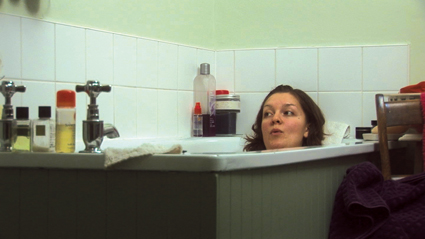
Marcus Coates, Dawn Chorus (2007), video still, installation commissioned and produced by Picture This, Bristol, funded by Wellcome Trust, courtesy of Kate MacGarry Gallery, London
Vocal Folds (curated by Jacqueline Dougherty and installed at Gertrude Contemporary, Melbourne) presents a careful selection of three video works which individually and collectively address the human voice in varied ways.
The installation—like a notable number of Gertrude Contemporary group exhibitions over the past five years—wonderfully grants the visitor access to the material and phenomenal aspects of each work. The ‘white cube’ hasn’t been ignored or destroyed: it has simply become invisible in the face of the installed works, which means that the audiovisual content is comfortably and impressively conveyed without interference by inappropriate architectural edifices, inadequate acoustical accommodation, or improper curatorial assumptions of the audiovisual experience.
Vocal Folds has been refreshingly conceived as a material occurrence, in accordance with its intention to investigate the material effects of the human voice as a generator of palpable linguistics and discursive abstraction.
Valie Export
Valie Export’s film I turn over the pictures of my voice in my head (2008) serves as a critical introduction to these notions. Export’s work is a curious amalgam of linguistic didacticism and visceral scopic spectacle—which for me grants it a somewhat obvious audio-visuality. While this is to a degree typical of Viennese Aktionism and its after-effects, Export’s lugubrious intonation of a convolving Wittgensteinian text seems divorced from the conceit of using a laryngoscope to spectacularise the means of production of her language. For some, this audiovisual merger will intensify the experience (the thrill of inserting scopic and auditory devices into the human body is a longstanding trope of radicalised body art) but I found the work surprisingly monotonal and literal. Regardless, Export’s work posits one recourse to visualising the mechanics of language through the materiality of the vocal apparatus.
Marcus Coates
Marcus Coates’ multi-screen video installation Dawn Chorus (2007) creates a dense field of communicative noise by employing British morning bird chatter. The mass twittering of birds is the first thing you hear when you enter Vocal Folds. It’s a frenetic, exhausting veil of warbling frequencies and piercing harmonic tones, yet it hangs throughout the three galleries in a non-obtrusive way. Fourteen video screens are positioned throughout the space at varying heights and angles, inviting you to wander through their arrangement. At any one time, you can hear at most three or even four birds whistling, but due to the high frequencies of bird sound, it’s quite difficult to locate their position—especially within an enclosed space. After some time, it became apparent that at select moments, one of the onscreen portraits (each of a singular person alone and comfortable in a plain domestic setting) would break into birdsong. But at this precise moment, the video went into hyper mode, indicating that the ‘birdsong’ I was hearing was in fact humans mimicking birdsong at a slowed-down speed, which was then played back at high-speed to replicate the frequency range of birdsong. Of course, to a bird, it would have sounded more alien than avian—like us listening to a computerised simulation of an off-shore call-centre worker reading James Joyce through a fuzz-box and presuming it to be ‘vocalised language.’
Dawn Chorus—possibly unknowingly—recalls a longstanding tradition of composers attracted to the impenetrable vociferousness of birdsong and the complexity of its multifarious modes, dialects and individualised applications. Beethoven—gifted in hearing music both within his head and in the outside world—allowed birdsong to activate lyrical motifs in his pastoral suites, evoking the sensation of being immersed in the musical crossfire of the outside world. Similarly, Olivier Messiaen—skilled organist and ornithologist—spent innumerable hours meticulously transcribing birdsong patterns from which he elaborated complex rhythmic shapes and dense harmonies to simulate birds’ melodic phraseology. Oskar Sala—developer, with Friedrich Trautwein, of the trautonium and early explorer of the intersection of physics and acoustics—processed and transfigured birdsong tape recordings to render them ‘post-avian’ and hence monstrous for Alfred Hitchcock’s The Birds (1963).
Manon de Boer
While Dawn Chorus is largely determined by an extant attraction humans have toward avian linguistic code, Manon de Boer’s two-screen installation one, two, many (2011) treats humans in a similar fashion. Shifting and alternating between two screens facing each other, a suite of three videos is projected, one at a time, and each time on a different screen. One video is a performance by a vocal ensemble in the large reception area of an old building, watched by a handful of visitors; the next is a performance by a solo flautist alone in a small domestic room; the third has the camera focused on a wall while a woman’s voice talks about listening to a tape recording of a lecture by Roland Barthes.
In one sense, there’s something very modish about one, two, many. Contemporary art for nearly a decade now has been progressively aligned not only with performance and performance art history (canonised by and through Marina Abramovic’s Seven Easy Pieces), but also by the performative modes, techniques and practices of a wide spray of arts predicated on both traditional and experimental legacies of performing. Music has notably come into the spotlight here, with many a video-art videographer treating composers, musicians and their audiences like anthropologists fascinated with such brethren. Often it’s like David Attenborough studying a Fluxus performance: the artist seems to be pondering “what are they thinking when they’re performing/playing/listening/etc.?” De Boer’s one, two, many falls into this category. As much as I would like to celebrate the rigour of its cinematised ‘deep listening,’ I hasten to historically and culturally locate its anthropological tendencies. The roving camera, streaming its one-take flow, ably conveys the sense of entrancement endemic to the act of listening—but such camera technique was well established by tracking shots in Busby Berkeley musicals in the 1930s, where space was dematerialised to evidence the temporality of listening. Manon de Boer’s camerawork resembles more the base humanist impulse of anthropological documentation: to evidence the human being in front of the lens, hence the palpable presence of their hair, skin, clothing, posture. Through such a procedure, the human becomes eroticised—yet for no direct purpose. (Not surprisingly, this is precisely what impels most ‘experimental/exploratory/extended’ forms of musical improvisation: humanism.)
To listen, not document
When the Dardenne brothers stayed within the audible breathing space of Rosetta in their 1999 film of the same name, they treated her as if they were filming a combatant in a war zone. This intensifies the psychological claustrophobia which terrorises Rosetta throughout this gruelling film. When in Crazy (2002), Heddy Honigmann places her camera literally in the faces of Dutch UN peace-keepers as they endure the playback of songs they used to assuage their near-insane anxieties while working in debilitating warzones, she captures how the sound of music now ruptures their present space with overwhelming memories of the past. From the gasping breath of a frantic teenager in the former to the silent tears held back by aging men in the latter, the camera is used not to document but to listen. One, two, many doesn’t achieve this, yet—like the Valie Export piece—it affords the opportunity to make these links and consider the wider options of its audiovisual practice.
Yet I’m frankly not confident that visual art professionals are entirely attuned to what I’m saying here. All three videos exhibited in Vocal Folds contain enough visual beauty—from the abject to the transcendental—to satiate the intelligentsia. And I’m equally sceptical that sound/music professionals are interested in the intellectual ramifications of their experimental practices. These videos contain soundtracks and sound designs implicitly opposed to conventional audiovisual cinema practices, thus emboldening those who think audiovision is best discussed as a radical or progressive intermedial venture. Vocal Folds bravely intimates that language can collapse or evolve into a supra-form through the materiality of the voice (something one can imagine Cathy Berberian or Joan La Barbara espousing) but I feel most people will stop just there. The Vocal Folds exhibition for me opened up possibilities from that point, to welcome how the depiction of humans engaged in making or listening to sound or music can illustrate an escape from humanist inscription.
–
Gertrude Contemporary, Vocal Folds, curator Jacqueline Dougherty, Melbourne, 21 June-20 July
RealTime issue #116 Aug-Sept 2013 pg. 22
© Philip Brophy; for permission to reproduce apply to realtime@realtimearts.net
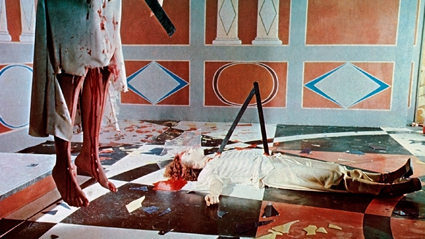
Suspiria
Hovering tensely and amusingly between kitsch and high art, Dario Argento’s Suspiria (Italy, 1977) was the highlight of my several days at Perth’s Revelation International Film Festival, an aesthetically challenging and pleasingly intimate event hosted by program director Jack Sargeant and Revelation Chair Richard Sowada.
Suspiria
Fixated on the tropes of horror and suspense thriller films, Argento elaborates on and lingers over them with calculated artificiality—his world is spatially exaggerated, surreally dreamlike and richly lit with unlikely colours, his characters hyper-types with severely limited vocabularies.
At times Argento’s generation of suspense and shock is masterful (hands plunging though a window and pulling the face of the person inside flat to the breaking glass), at others he over-relishes the moment draining the image of affect—as in the scene with the blind pianist lost with his Doberman amid neo-classical buildings on an empty black space. The ‘consolation’ is that the dog turns on his master, with close-ups of the animal tearing at real meat (but not in the graphic manner of the contemporary horror film where we’d doubtless see the face and throat of the victim). Elsewhere the blood is patently fake, artfully applied, as is a large shard of glass neatly sculpted into a face. Characteristically, Argento’s play with depth of field and the use of doorways (leading into ambiguous spaces or sheer nothingness) yields both existential eeriness and visual delight. These are crafted excesses.
Of apparent secondary concern in Suspiria, narrative provides sufficient foundation for the largely visual realisation of a murder mystery with a witchcraft theme. Music is another matter. Tautly thematic and un-clichéd, its percussion shimmers, bass lines sink into otherworldliness and the musicians’ voices form an enveloping ghost chorus. Performed at REV live by Goblin, the creators of the original soundtrack, to a vivid print and clear dialogue, the tightly cued music gave the film even greater cogency, making for a wonderful audio-visual experience—a heightened viewing of a classic rarely encountered on the big screen.
White Reindeer
White Reindeer (USA,2013) a largely crowd-funded American film by Revelation guest the writer-director Zack Clark, was a cut above standard Indie fare. If conventionally filmed, the creation and evolution of its central character, Suzanne (Anna Margaret Hollyman), a real estate agent whose TV weatherman husband is murdered very early in the film a few days before Xmas, is adroitly realised. Deeply depressed and increasingly manic but largely calm on the exterior, she finds herself sucked into unusual situations (a very funny orgy, drug-taking, a friendship with a black woman—her husband’s sometime mistress—and shoplifting) that take her well beyond her comfort zone and the narrow world of her timid parents (who suddenly divorce) and us with her on a largely unpredictable journey, some of it into deep abjection. What is special is the uncluttered ease and absence of rationalised motivation with which Clark allows his protagonist to go on this journey into excess and potential healing. Also effective is the way the director satirically frames Suzanne’s fall and rise, heightening the sense of an un-nuanced world in which people privately indulge in extremes. White Reindeer is at once funny and sad, and feel-good without being a turn-off: the road of excess into grief by way of abjection leads to a palace of wisdom, if a humble one.
Upstream Colour
Upstream Colour (writer, director, cinematographer, composer, actor Shane Carruth, USA, 2013) was an altogether more demanding experience with little of the Indie inclination to straightforward novel-ish narratives. Its calculated lack of narrative certainty, its distant characters and unusual shooting were too much for some of the audience, while others found it exhilarating. Naturally there was debate, but little in the way of middle ground agreement. The film’s various disorientations make for an engrossing experience as an animator, Kris (Amy Seimetz), who appears slightly off kilter at work, falls prey to a man who drugs her into signing over her property and leaves her lost, amnesiac and deeply wounded. Such is the filming that we share her delirium. Unlike Suzanne in White Reindeer, Kris’ full recovery looks unlikely as she rejects a sensitive if similarly withdrawn male’s approaches, his character tainted for us by obsessive paper folding. Heavy with deeply ironic references to Thoreau’s On Walden Pond, with images of rotting and infection (maggots pushing up veins in her leg, to which Kris takes a knife) and of farm pigs (whose care might signal salvation), Upstream Colour (the title is a clue to solving one of the film’s mysteries) is abundant with excess. But its juxtaposition with the spare characterisations created a dynamic I enjoyed in these pedestrian times, if having to accept the film’s metaphysical pretensions à la Terence Malick.
Sam’s Gold
Sam’s Gold, a short drama by Australian filmmaker Julietta Boscolo and writer Rebecca Clarke, cleverly frames a young boy’s struggle to maintain a sense of self with the tale of a young wizard written for Sam by his gaoled father. The father, reading aloud in prison, is the first person we see before we follow Sam on his way to school listening to the story on an iPod, a gift from his father. Local bullies steal it from him, burning his hand with a cigarette lighter, but he assertively regains the player. The film deftly delineates the boy’s needs (his father absent, his mother delinquent), his courage and ethical good sense.
Interior, Leather Bar
Producer James Franco and director Travis Matthew’s docu-fiction Interior, Leather Bar was inspired by the mystery of the 40 missing minutes (cut presumably in the face of censorship) of William Friedkin’s Cruising, an infamous 1980 film about a detective (Al Pacino) going underground and gay in order to catch a serial killer. There’s much talk about the casting of the Pacino role with Van Lauren, a very straight actor whose objections are met with bland, mumbled assertions from Franco that he wanted to show the warmth of gay male sexuality. After watching the cock fondling and sucking from the edge of the action, sharing meaningful looks with one of the cohorts and joining the subsequent dancing, our new Pacino (“I’m not the same man I was when I came into this”) goes home happy to his wife. Or does he (“touched by the intimacy of the couple”) see something that he likes? There is nothing to indicate
the nature or the depth of the change. The sex scenes are conventional soft core, tarted up with video clip editing and overwrought ambience.
Surkhaab
One of the stranger films in the program was Sanjay Talreja’s Surkhaab (India, Canada, USA, 2012). The leading actor, Barka Madan, a Buddhist nun who has forsaken the martial arts she demonstrates in the film, addressed us in robes and shaved head. Surkhaab is about people smuggling (the relatively good father smuggler and his bad smuggler son) and their clients, in this case an educated, elegant young woman, Jeet (Madan), who has become the victim of aggressive sexism in her hometown in India. In a post-film talk, Madan explained that the director decided that the film was too linearly predictable and asked the editor to re-order it. The result is two intertwined narratives, one following the woman to Canada, the other cutting back to India to gradually reveal the increasing seriousness of the plight that finally drives Jeet to become a refugee. Madan aside, there are naïve performances, some clunky scripting, improbable plotting and a limp feel-good ending. But the film makes it evident that you don’t have to be poor, the victim of political terror or war to be driven to become an ‘illegal’ immigrant. But even if she has found a new home (still as an ‘illegal’) Jeet learns that in Canada “I am just another immigrant; just another story.” More positively, she is a woman at the centre of a serious film, a trend Madan said was developing in Indian filmmaking.
Experimental Showcase
Jason Wen’s Let Everyone Create Their Own Title (UK, 8mins) is a fascinating impressionistic ‘biography’ that conveys some sense of what it might mean to suffer Parkinson’s Disease. Wen limits our vision of the sufferer’s world to a narrow vertical strip of screen in which we view him, his home and nature—each seen as blurred or quaking, utterly still or pondered close-up in intense detail.
In Long Life (1) (Australia), Merilyn Fairskye magically works the horizontal plane, playing simultaneously with our perception of horizon, depth of field and our sense of up and down. Sky and reflective water overlap near what we’d expect to be the horizon, but it takes quite a while to grasp an eerie otherness in which drifting weeds below appear above like a bird flock, ducks float seemingly out of scale with the waterscape above the horizon while what we take for islands drift by. This seven-minute, characteristically contemplative Fairskye work was one of the several works that justified the experimental label.
With a very different perceptual challenge (keeping up with the speed of image turnover), Dan Browne’s multi-award winning Memento Mori (Canada, 28mins; https://vimeo.com/54265266) offers a long, fast ride through a constantly morphing, heavily layered image-scape, which the maker describes as “a meditation on (im)mortality, mediated by a lifetime of images.” The 100,000 photographs and film images (some of them classically ‘experimental’) that constitute the work’s content from the filmmaker’s archive fly by—richly coloured, merging into one another, creating abstract patterns and spectres, their flow occasionally ‘slowed’ by the persistence of a specific image (a police car, a receding railway track). The multi-layered soundtrack comprising radio snatches, toy piano, a man talking at length about death (the film speeds on while the aural plane at one level slows), religious chants, birds and rain is deeply absorbing in itself as well as matching and counterpointing the pulse of the film. The moon, a boy’s hand resting against grass, a tale of a Buddhist monk’s philosophical conviction (“I could have your sword run though my belly without a blink of my eye”) and a chiming church bell in the film’s final moments, complete with a glimpse of the filmmaker’s face, underline a sense of mortality, our spirit buoyed by the richness of what has passed.
Revelation Perth International Film Festival, 4-14 July
Keith Gallasch was a guest of the Revelation Perth International Film Festival.
RealTime issue #116 Aug-Sept 2013 pg. 21
© Keith Gallasch; for permission to reproduce apply to realtime@realtimearts.net
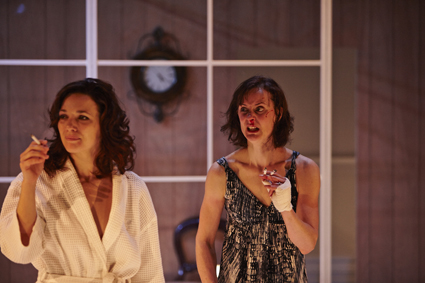
Meredith Penman, Karen Sibbing, Persona, Fraught Outfit & Belvoir
photo Ellis Parrinder
Meredith Penman, Karen Sibbing, Persona, Fraught Outfit & Belvoir
There are nights when it is impossible to mingle in the foyer after seeing a play, chatting about the experience or avoiding it altogether, casually reconnecting with the everyday as if nothing had happened. With Angels in America, The Maids and Persona, something had happened—to me.
The cleansing of fear and pity that is supposed to be ‘Catharsis’ doesn’t quite explain the traumatic impact of some performances. There’s a kind of numbness, an inner silence (not as radical as the one that besets Elisabeth in Persona, but related to it) making it difficult to offer coherent observations. Best go home to a glass of dark red wine, stillness…and silence.
In these three productions, actors and directors conspire to realise performances that take us to emotional limits and beyond to a kind of exhaustion, so much having been demanded that I sense the endurance suffered equally by the actors and their characters.
In Persona the fragile identities of two women (one would love to be the other’s sibling) dangerously overlap. In The Maids two sisters are fatally trapped in a class-imposed identity and a fantasy of revolt; and in Angels in America two men are enveloped by a disease and the politics that attempts to deny and define it; though they never meet they are protagonist and antagonist.
Belvoir and Fraught Outfit, Persona
From the beginning, Persona is sparely paced, words carefully articulated, images pronounced and few: a quietly realistic world in which a nurse, Alma (Karen Sibbing) cares for an actress, Elisabeth Vogler (Meredith Penman) who, having momentarily fallen silent in a performance of Elektra, is now completely speechless, if showing few other signs of illness. Save for a moment when the nurse, panicky about the assertiveness of her patient, rather brutally sedates her, the relationship seems initially simple.
Later in a summer cottage, having volubly and frankly revealed herself in the face of her patient’s silence and beginning to feel that she loves Elisabeth, the nurse finds her confidences betrayed and that she is merely regarded as “useful.” Alma becomes successively angry and violent. The quivering and quaking extremity of the descent Sibbing so powerfully embodies is counterpointed by Penman’s physical restraint. Alma doesn’t see the small signs of her patient’s watchfulness and disapproval.
The power of Persona first resides in its scenario: one person’s illness opens up one in another, a kind of transference in which the nurse, like her patient before her, loses her social mask. However, if we’re uncertain that Elisabeth is actually mentally ill, we come to co-inhabit Alma’s hallucinatory illness when the curtains part, in a Bergman-esque moment, to reveal the cottage surreally stripped back—furnished only with a large Victorian wall clock and a heavy Victorian chair. In a remarkable night-time scene Alma has sex with Elisabeth’s husband (who thinks she is Elisabeth) as the wife, naked, looks on. What’s striking about this scene is not just the abject trousers-around-the ankles grittiness, but the moment when we see Alma decide that she will, vengefully ‘adopt the mask’ and play the wife. Sibbing reveals an astonishing range of behaviour and states of being, from shy nervousness to raging anger, ‘nuttiness’ (in a ragged ensemble of clothing), fearful delirium and temporary calm—listing Elisabeth’s failings before descending into her own silence.
Although a very different, much more earthed performance than Bibi Andersson’s as Alma in the film, Sibbing gets the story about an earlier sexual encounter—with two teenage boys and another woman on an otherwise empty beach and in which she orgasms, feeling real for the very first time—just right. There’s an innocence, shyness and honesty about the telling with just of touch of pleasure—a reminder of Bergman’s account of being astonished at the sense of “shameful lust” with which Andersson realised the lines.
Far superior to Simon Stone and Andrew Upton’s cumbersome version of Bergman’s Face to Face (RT110, 44), Persona’s spareness and its careful re-ordering of material (we learn very early on of the likely causes of Elisabeth’s illness) make for a lucid account. And, unlike Bergman, Adena Jacobs has not cast look-alike actors, instead amplifying the sense of discrete personalities ill-fittingly bonded.
But this Persona is not the far more complex work from which it has evolved. It reverses the ending (if offering one that has its own frightening logic) and, problematically, it empties Bergman’s screenplay of its larger psychological context, reducing it to an existential drama otherwise disconnected from the world, in the same way that Simon Stone ‘denatured’ Ibsen’s The Wild Duck of class, property and environmental concerns. In the film Elisabeth has not only lost her sense of herself as actor and mother, but also of the meaning of a world in which a Buddhist monk in Vietnam immolates himself in an act of protest against war (the image flashes before us when Elisabeth suffers a panic attack). She later gazes at a famous photograph of Nazis rounding up people in the Warsaw ghetto—at the centre of which is a boy (underlining Elisabeth’s guilt about not loving her son). I recall when I first saw Persona in the late 1960s, being shocked by the first image, such was its immediacy in the midst of the Vietnam War. There is no such moment in this stage Persona.
This Persona mimics the film’s famous opening but only to the extent of having a boy, around 10 years old, enter the stage, sit and read a book, regard the audience and move his hand in a slow wave ‘across’ us before exiting. In the film there’s the glare of a projector lamp, the flicker of the celluloid gripping, rapid images of a lamb being slaughtered, a penis, a spider, a barely pre-adolescent boy in a hospital bed reading Lermontov’s A Hero of Our Time, then seen in intense close-up and conjuring with a wave of his hand the faces of Elisabeth and Alma, merging them. Presumably Jacobs’ prelude is simply aimed at establishing the existence of the son whom Elisabeth has rejected, while providing a knowing reference to the film. The film is punctured by another such moment when the celluloid appears to burn (some alarmed projectionists in the 60s stopped their projectors, until the spools came labelled with a warning) and the film ‘starts up’ again, this time with Alma’s deranged view of the world. In the play, in her final confrontation with Elisabeth, Alma wheels in a stage light on a stand (presumably imagining that she’s forcing Elisabeth back on stage) to provide a similar disjunction to the film’s.
The stage production otherwise borrows a little from the film, creating instead its own world and motifs in which the line between reality and its other is sparely and clinically signalled by the ebb and flow of large white curtains (also in the film), accompanied by the low rumble of breaking waves and the murmur of wind. It’s a slightly clunky design (looking more convincing in photographs of its end-on Melbourne realisation).
I was moved and disturbed by Jacobs’ Persona, shocked at its ending, not just because it is Jacobs’ not Bergman’s but by the extremity of its realisation of Alma’s decline in Sibbing’s performance—its eruption out of constraint, underlined by Penman’s nuanced restraint as Elisabeth.
Persona haunted me for days after seeing it, but having unleashed memories of the film it left me asking why, in the end, Jacobs and her fellow creators opt to so reduce the scale of Bergman’s vision? As any number of writers about the film have argued, it questions our capacity to face catastrophes (such as we do now, the largest since the 60s) as well as personal crises: do we hide behind our masks or sink into catatonia? The film will continue to haunt me in a way this play may not, but that’s not to say it won’t leave its own haunting traces in the psyche. [I discuss the production’s film references in a long version of this review online.]
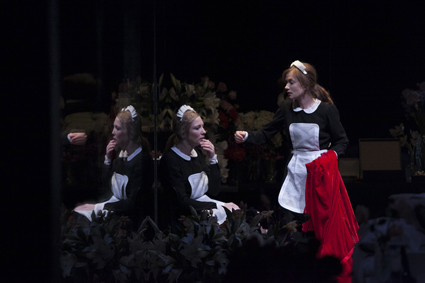
Cate Blanchett, Isabelle Huppert, The Maids, Sydney Theatre Company
photo Lisa Tomasetti
Cate Blanchett, Isabelle Huppert, The Maids, Sydney Theatre Company
STC, The Maids
I felt for Cate Blanchett and Isabelle Huppert at the end of The Maids as I did for Sibbing in particular at the curtain call for Persona—I thought I could see the demands of the performance indelibly written on their bodies.
As with the casting of Jacobs’ Persona, the two women here do not look or sound alike (the sisters they were based on by Genet very much did), but blood, fate and class and a desperate fantasy of vengeance and escape has bound them together. They operate in counterpoint—Claire (Blanchett) tall and elegant when needs be, not at all dissimilar from Mistress (Elisabeth Debicki), their employer, the other, Solange (Huppert) short, energetic, measured. When hyperactively committed to their project to destroy their Mistress, Blanchett’s Claire is a demanding fantasist. Desperately manic when she loses the thread of her performance as the Mistress or her murderous sense of purpose she collapses emotionally and physically, dashing to vomit in the bathroom. When Solange declares, “This is killing us, Claire,” you believe it, and the possibility that Solange will really try to save her sister.
In the hands of the Mistress at the makeup table, praised and patronised, Claire is flutteringly and abjectly fragile (her back is to us but her face caught close-up on the screen). It’s an astonishingly nuanced performance which Blanchett and Benedict Andrews realise as the tragedy of an ordinary life made perverse by servitude.
Huppert’s Solange is the more emotionally consistent of the sisters, more certain of their joint task and finally her own, achieving a kind of victory in which she saves her sister from endless servitude and possibly madness—such is the extremity of Blanchett’s performance and Claire’s final collapse—by killing her. However, her motivation, revealed superbly in the great monologue in which Solange fantasises the public revelation of her deed, is fantasy in the face of actual defeat. Mistress is alive, her gangster husband out of the gaol where Claire’s letter to the police has landed him. Solange’s hubris offers us a sense of tragedy too, if a humble one—she has after all saved her sister at the expense of her own life—in a performance by Huppert that counterpoints Blanchett’s with a calmer energy, comically breaking into ungainly physical exercises, largely controlling the play acting, only momentarily beset with moments of doubt and panic and luxuriating in periods of languor and delight, small details of the great screen actor’s characterisation of Solange caught in innumerable close-ups.
Andrews’ staging of The Maids is not the claustrophobic chamber theatre of many previous productions of the play—this world is agoraphobic, a contemporary wide-open glass-walled penthouse amplifying not only the sisters’ vulnerability and paranoia but also the suspenseful recklessness of their games. In moments of doubt the sisters wonder if they are being watched; is it God? Elsewhere they defiantly flaunt themselves. They are under surveillance, by us the audience. We glimpse cameramen behind the windows; small cameras are installed in the bathroom and on the Mistress’ table. But the sense of intrusiveness is not as effectively or as powerfully realised as it was in Andrews’ The Season at Sarsaparilla and Measure for Measure. The use of verité-style shooting might yield a reality TV ambience but, seeming largely un-choreographed, it creates competition between the stage and very large screen images hovering over it. I’m well used to and like this idiom, but here had to make an early decision to go with the actors (not too hard, I was fairly close to the stage). Nonetheless, the surveillance motif played its emphatic role in underlining the fractured reality of the maids’ lives: Claire becoming Mistress, Solange playing Claire to ‘Mistress,’ reflections multiplying in windows and mirrors and on the screen. Benedict Andrews once again proves that he is Australia’s best stage director, unleashing superb performances in a provocative response to a classic text without spurious infidelities.
The sisters who murdered their mistress in France in the 1930s gouged out the eyes of their mistress and her daughter, as if refusing to ever again ‘be looked down on’ or to be caught by a diminishing gaze. Similarly in Persona, Alma’s hostility to Elisabeth derives from finding that the woman she loves and whose sister she would like to be regards her as merely plain and “useful.” In The Maids the desire to kill the Mistress is ironically counterpointed with a desire to be like her, the double bind evident in the sisters’ abjection, in the face of her condescension, which Debicki plays masterfully. With frightening perspicacity and febrile energy, Blanchett and Huppert render this trap utterly palpable, giving enduring life to Genet’s still haunting vision of the sorry complexity of lives destroyed by power, resonating with our own humiliations and resentments in the problematic order of things.
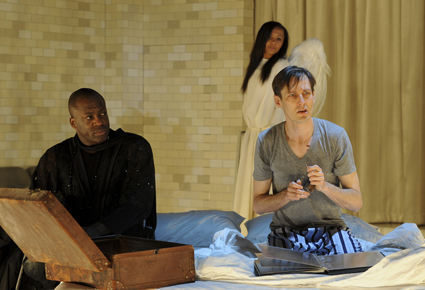
Angels in America, Belvoir
Belvoir, Angels in America
Protagonist and antagonist never appear together in Tony Kushner’s Angels in America. They are the emotionally and politically diametrically opposed Prior Walter (Luke Mullins) and Roy M Cohn (Marcus Graham). We experience their differences as the dynamic that drives this epic “Gay Fantasia on National Themes.” Mullins’ and Graham’s performances are psychologically and physically rich in detail and drive, the best work I’ve seen from each.
This “fantasia” with its nightmares and its angel (a mundanely realised one with small wings standing on a chair but all the more chilling for the painful ambiguity of its message) finally yields a ‘happy’ ending, a sense of hope if with many provisos and lives and love lost. Graham’s Cohn starts out fast and loud, calculatedly unmodulated, crudely logical, the ultimate self-denier, until reality finally takes a grip on him, the fault lines in his psyche cruelly revealed if not fully faced—his fears embodied in projection (the ghost of the alleged spy Ethel Rosenberg he had executed) rather than confession, which is beyond him. Graham invests his Cohn with a pulsing, defiant energy that never quite leaves him, even when succumbing to AIDS-related illnesses and night terrors.
Both men are isolated: the furtively gay Cohn by his own choosing, Prior deserted by a lover (Mitchell Butel) terrified by the symptoms of illness. Both are funny: Cohn coarsely if revealingly so while Prior is a true wit. Cohn’s demonic vulgarity barely dissipates, even in the face of those he has destroyed, but Prior’s humour evaporates with a profound darkening of his spirit in the absence of unconditional love. Together these men represent the tragedy of AIDS and of a nation, embodying hubris, suffering, insight and radical aloneness; it’s an America we know all too well, even more divided now by cruel absolutes.
The dynamic between Prior and Cohn plays out on other levels, in the relationship between Prior and Louis, Cohn’s aide Pitt (Ashley Zukerman) and his wife Harper (Amber McMahon), between Cohn and Pitt and, bridging the two worlds, the dauntingly wise black man Belize (Deobia Oparei—appearing also as the chilling Mr Lies). Fleshing out this world culturally and historically is Robyn Nevin as a Rabbi, a tramp, an ageing Bolshevik and the ghost of Ethel Rosenberg (shades of Thelma Ritter). Alan John’s choice of American iconic music alongside his own also evokes a larger and more present cultural picture. The sense of ensemble playing is tautly consistent as the performers work a largely empty, flexible space bound by huge tiled walls that suggest bathroom, public urinal and hospital in an un-well world. Despite some oddly determined interval breaks that test engagement, Eamon Flack’s lucid production provides relentless momentum and highly articulated characterisations.
The existential crises that dog the characters in Angels in America are induced personally and politically, circumstantially and wilfully, Kushner never letting us forget the big picture, one philosophical and cosmological. It’s a lot to take home, to let settle in the psyche beside Persona and The Maids, to ponder when I eventually rise out of the numbness, that emotional exhaustion and its consonant empathy with the performers of these challenging visions.
A French play, an American play and a variation on a Swedish film: we make these classics ours while we await our own.
Belvoir, Fraught Outfit, Persona, creators Adena Jacobs, Dayna Morrissey, Danny Pettingill, Belvoir Theatre, 26 July-18 Aug; Sydney Theatre Company, The Maids, writer Jean Genet, translation Benedict Andrews, Andrew Upton, Sydney Theatre, 8 June-20 July; Belvoir, Angels in America, writer Tony Kushner, director Eamon Flack, Belvoir Theatre, Sydney, 1 June-27 July
RealTime issue #116 Aug-Sept 2013 pg. 34-35
© Keith Gallasch; for permission to reproduce apply to realtime@realtimearts.net

Heathfield Place, Temporary Democracies
photo Heidrun Löhr 2007
Heathfield Place, Temporary Democracies
When Michael Dagostino, director of the indefatigably innovative Campbelltown Arts Centre, approached live art practitioner and curator Paul Gazzola with an idea for a project that would engage with the suburb of Airds in a NSW public housing area that is subject to demolition and re-settlement, Gazzola came up with the title Temporary Democracies.
“People often live in these houses for a short period of time in which they have a democratic right to make them their own. Some have been there for 30 years plus and others for two or three years.” Dagostino explains, “Airds will be transformed—70% of it is going to be knocked down and re-built over the next 10-15 years and a large percentage of the population relocated elsewhere.” Gazzola recalls “looking at these empty houses as offering a great opportunity for artists to be able to work with as sites for setting up installations or for drawing materials from or just as reference points. So, Brian Fuata is working on the foundations of a site that’s already been demolished. Two other artists are working inside the houses, setting up events and installations. Indigenous artist Nicole Foreshew is filming the demolition of a house. When suddenly a house disappears you see more of what used to be there before, she says. We’re temporarily extending the lives of these houses.”
Dagostino says that the project has the support of the NSW Land and Housing Association in order to “to engage the community in a positive way about the changes to Airds, allowing artists to tell the stories of the residents and work directly with them to build up a rapport.” Gazzola points out that there is a relocation team acting as middleman between the government department and the community, softening the impact of the relocation: “they’re involving local people in re-generation of old ideas of renewal. They hold the Airds Out Loud event four times a year for the community to discuss the design program. ‘What would you like? Where should roads and infrastructure change?’ The team seem to have tried their best to connect with the people rather than delivering a potentially top-down strategy.”
At the end of last year at one of the Airds Out Loud events. Gazzola, artsworker and writer Rebecca Conroy and artist Robert Guth mingled with locals they’d met previously when discussing the Airds project with artists and the community. “It’s like constantly announcing yourself, about being there.” Dagostino concurs, “This project is one of a number in which we have a long-term relationship with the community. It’s not a fly-in-fly-out kind of attitude. And that’s important for all the projects that we do. The first time we go in we are these strange aliens but the next time we go in things become more familiar, the community knows who we are; the next time we become part of the community. That’s critical.”
“It’s always been proposed as a two-year project,” says Gazzola, “This is really the starting phase about how to work in these houses, how to make it all operate, get the people on side.” Campbelltown Arts Centre’s success with community related projects has been evident in projects directed by Rosie Dennis—Driven to New Pastures (2010), Life As We Know It (2011), where senior citizens from the area appeared onstage, and especially Minto:SiteLab and Minto:Live 2011 which featured artists-in-residence in the local shopping centre and library.
For Temporary Democracies, Gazzola selected 12 artists in 2012 to visit the site. “I introduced them to the people running the relocations team and community groups. We discussed the Radburn Principle—the US architectural plan taken up in Australia where the houses were built with their backyards facing the roads; the cul-de-sacs and the front of the houses had big open spaces where people could communicate across these green corridors. But locals and the Housing Association saw it as a failed architectural plan that produced easy disappearance routes for thievery and drug dealing. You look at the houses, you really do enter through kitchens as front door entrances.”
New Zealand artist David Cross, says Gazzola, “has picked up on the idea of the house itself as an object and the Radburn flipping of entrance and exit. After Radburn, the Housing Department tried to ‘turn the houses around,’ putting more windows on the street side and putting the backdoor as the front door. David’s proposed that you walk up the stairs and then slide down a chute out of the back door! This follows on from the games he plays with inflatables that are very much short, immediate engagements with a re-shifting of your perspective.
“Elizabeth Woods is working on a table tennis project, it’s got its big ideas but people playing games together is an easy way in. Tanya Schultz from WA who works with Pip and Pop [partner Nicole Andrijevic] makes beautiful installations from [brightly dyed] sugar, a bit like the mandalas. I thought of having something that was really beautiful in an area with a lot of destruction but beauty all around it. It’s insanely beautiful. You drive in through an incredible green corridor and it’s treed and right on the edge of the river. Tanya’s talking to communities, asking them to build little objects, photographing them and making wallpaper to be installed in one of the houses.”
Canberra-based artist Robert Guth’s works are about cooking food as a social act. He’s bought a pop-top caravan which he’s re-building with the Airds/Bradbury Men’s Shed group, converting it into a community cooking trailer for ongoing use. That’ll be on the project site. We’re putting something back into the community that’s functional—art doesn’t have to be about an aesthetic relationship.”
Paul Gazzola says that he constantly wonders, “what’s the most relevant approach. What makes sense? It can’t be layering some high-end art speak over the top. That’s just going to disappear into the ether and be irrelevant for the community.” He adds, “The project might be titled Temporary Democracies, but the legacy won’t be temporary.”
To provide continuity and perspective, Gazzola approached Rebecca Conroy “to come on board to develop a website to contextualise the project from a more global perspective.” You can read Conroy’s first essay and other material on the project website. Gazzola is emphatic, “We’re not just pointing at Airds as a little local entity that doesn’t really have any relationship to anywhere else.”
Paul Gazzola promises an intriguing experience if you visit Temporary Democracies on the 16th and especially the 17th of August when all the works will be operational against a background of cranes and earthmovers as Airds transforms from one temporary democracy into another.
–
Campbelltown Arts Centre, Contemporary Democracies, curator Paul Gazzola, artists Lachlan Anthony (VIC), Darren Bell (NSW), Rebecca Conroy (NSW), David Cross (NZ), Benjamin Forster (WA), Nicole Foreshew (NSW), Brian Fuata (NSW), Robert Guth (ACT), Nakkiah Lui (NSW), Bennet Miller (WA), Kate Mitchell (NSW), Tanya Schultz (WA), Elizabeth Woods (QLD); 13-17 Aug; Heathfield Place, Airds, NSW, www.temporarydemocracies.com, www.campbelltown.nsw.gov.au/LiveA
RealTime issue #116 Aug-Sept 2013 pg. 32
© Keith Gallasch; for permission to reproduce apply to realtime@realtimearts.net

Jeff McCann, Wayne Emerson, Scott Lea, 8 Artists, Eastern Riverina Arts
photo Christopher Orchard
Jeff McCann, Wayne Emerson, Scott Lea, 8 Artists, Eastern Riverina Arts
Continuing our series on innovative arts ventures in Wagga Wagga and surrounding regions, here we look into the activities of the peak advocacy and support body in the area, Eastern Riverina Arts (ERA). I spoke with Scott Howie, Regional Arts Development Officer and practising artist.
Previously an English, Drama and Media teacher in Canberra, Howie moved to Wagga in 1999 to study Film and Television at Charles Sturt University. Dissatisfied with the technological barriers placed between him and actors/audiences in the broadcast medium, he created performance works exploring modes of interactivity, forming his own company Jibshot.
Of the opportunities at the time Howie says, “Things were cheap, people were encouraging. There was a professional theatre company that was interested in working with me as someone doing young and emerging work beyond what they were programming…It was kind of low risk financially. You could afford to experiment. If it didn’t work you weren’t going to lose a huge artistic reputation. We’re talking maybe 12 years ago—regional activity was quite low and it was easy to stand up and say, ‘Hey, I’m somebody who’s practising regionally.’ And it was quite easy to get some funding. It’s much more competitive now that the level of regional activity has just exploded.”
Generating projects, connecting people
Howie suggests this explosion of activity results in part from artists moving to or remaining in the area in order to feel “more connected to the landscape, more connected to community. And certainly for me it’s about that. It’s about having time and space for contemplation.” It’s also due to people like Howie and the activities of organisations like Eastern Riverina Arts. There are in fact 14 Regional Arts Development Organisations (RADOs) in NSW that are triennially funded by Arts NSW and from local council contributions.
Howie describes the role of Eastern Riverina Arts: “We’re about arts and cultural development so we generate projects across the region, promote what’s going on and run training workshops. The whole notion for me is about how we connect people. We’re brokering relationships, whether that’s assisting the local conservatorium of music to tour its work throughout our region to the smaller towns; or bringing in a company like Monkey Baa to tour our smaller volunteer presenter networks; or a big project we’ve just finished—an arts and disability exhibition at the art gallery…And always trying to find opportunities to employ artists at a professional level in a professional manner.”
In the gallery, on the road
The last project to which Howie refers was titled 8 artists and involved extended studio collaboration between four pairings—artists with and without disabilities—culminating in an exhibition at the Wagga Wagga Regional Gallery. The works by Wayne Emerson with Jeff McCann, Angela Coombs Matthews with Kellie Hulm, Vic McEwan with Scott Lea and Jacqui Meyers with Julia Davies included mixed media, painting, mosaic and video installation. (The beautifully produced catalogue is available for download at http://8artists.net/.)
A playful, smaller scale project, Car Boot Gallery, saw Howie touring to 10 local council areas exhibiting works commissioned from artists, one from each area, out of the back of his car. Howie says, “It provided a survey of the range of artistic practice in the area from [artists] with professional exhibition experience to young emerging artists. It’s great for us to get out there and meet the artists so that they know what we’re doing.”
On the performance front, Eastern Riverina Arts is co-ordinating the Short & Sweet Play Festival which has received funding to roll out in regional areas. Local playwrights and actors will be working out of the Cootamundra Arts Centre, an old carriageworks donated by the council to a local volunteer group who have converted it into a 120-seat theatre and exhibition space. ERA is also running a two-year hip-hop dance program with young people across six towns resulting in a series of dance films that will tour the region. The organisation has also just assisted the artists Greg Pritchard and collaborative husband and wife duo The Ronalds in a streaming broadcast project that was part of Underbelly on Cockatoo Island in Sydney.
Speaking up for art
As well as administering a small funding program on behalf of Regional Arts NSW, Eastern Riverina Arts also plays a vital advocacy role in the region. Scott Howie cites a recent example where the Wagga Wagga City Council developed an ambitious public art program including two $60,000 commissions for works sited at the airport. Howie says, “Of course in tight financial situations a lot of people would question the value of that. So we jump into that debate and talk about what it actually costs and what artists actually do.” ERA will shortly be running a one-day conference on public art and art trails, bringing leading Indigenous artist Fiona Foley, who has created a number of significant public art works, from Queensland as guest speaker.
Challenges & resonances
Activity in the region has increased dramatically over the time that Howie has lived in the area. There are now a number of organisations and groups producing contemporary work attracting national attention, such as The Cad Factory (Vic and Sarah McEwan, see RT115), Wired Lab (Sarah Last and David Burraston), White Box Theatre (Kim Hardwick and Martin Kinnane) and The Ronalds (Patrick and Shannon Ronald). However funding is still somewhat limited. Howie ponders, “How many more artists and arts organisations can we sustain at this level? When you carve up the pie who else are we going to be able to support? How’s anyone else going to be able to bubble up?”
Howie also fears that the techno-utopia promised by the National Broadband Network may not fully eventuate. “I do think we’re still going to have a two-speed digital economy. We are going to have lower upload speeds than metro cities…The challenge for us regionally is how we put things in place that allow us to send stuff out. Do we need to have some digital streaming studios that are portable? A lot of the work that happens that’s interesting in our region is site-specific. How do we ensure that we’ve got technology available [for that]?”
The other challenge Howie sees is the lack of critique. “It’s tricky to get people out here to look at the work. Unless you really want to focus on promoting what you’re doing to the metros it’s really hard to even be noticed. So we need to raise that culture of not being afraid to critique the work that’s going on here—and to seek that.” Which is where RealTime comes in. As part of our regional focus, RealTime managing editors Keith Gallasch and Virginia Baxter will be conducting a series of writing workshops in the region to assist in the development of a robust culture of commentary and critique.
Scott Howie is very positive about developments in the region and particularly in audiences. In a follow-up email he writes, “I think audiences are becoming increasingly open to new experiences, things that re-imagine or reconfigure spaces, that have strong local connections either through space, people or content…Knowledge of the genre/artform/discipline is less important as long as the work resonates within communities.” We look forward to exploring these resonances in our upcoming coverage of Cad Factory’s Sunrice Project and the Wired Lab’s Open Day in coming print and online editions of RealTime.
Eastern Riverina Arts, http://easternriverinaarts.org.au/
RealTime issue #116 Aug-Sept 2013 pg. 32
© Gail Priest; for permission to reproduce apply to realtime@realtimearts.net
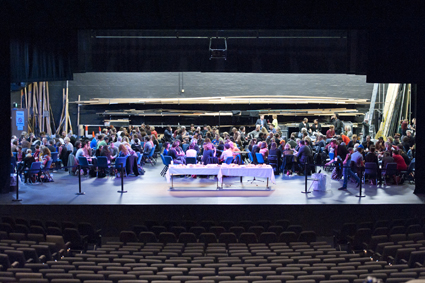
Australian Theatre Forum 2013
photo Angie To
Australian Theatre Forum 2013
The third Australian Theatre Forum was held in Canberra in May. Over 300 of us gathered on the cavernous stage of the Canberra Theatre Centre to be sung into the mood for discussion and exchange by Robyn Archer, who reminded us, via Brecht, that for this bleak existence mankind is never undemanding enough. A sobering prelude to curator Alicia Talbot’s forum question: what is not possible?
Unlike the previous two forums, this one eschewed the open space approach, by which we the people create the event’s agenda, and instead opted for the more conventional conference mix of keynotes, panels and break-outs. This provided both the advantages and disadvantages of the package tour. On the one hand, it guided me towards sessions that I might otherwise have skipped as being marginal to my interests. I would not have normally chosen to listen to an account of setting up a chain of Vietnamese restaurants, but Nahji Chu’s session brought home to me how little we theatre professionals have innovated when it comes to thinking about our business models. On the other hand, I found myself trapped in other unproductive sessions where I longed for the permission to get up and move to another. For example, the keynote by the Nature Theater of Oklahoma began promisingly but its invitation for us to consider the value of theatre soon descended into an ugly display of name-calling among the audience and in the context, to leave was to ‘walk out.’
The session on rehearsing the future by Lenore Manderson and Kristin Alford reminded us that there is little point in trying to predict the future—better to accept that it will probably come at us from the angle we least expect, and to develop our resilience to respond to the unimagined.
As an example of this randomness in our destinies, David Milroy told us in his keynote that he first got into theatre when he was called in to replace an actor who had dropped out on winning the lottery. Milroy went on to invite us all to imagine an Australia where white people are the Others, their rights and choices determined by the research done on their culture by Aboriginal people, who would then benignly champion the whites’ cause and tell their stories for them. We Others got the point, and there was a unanimous vote at the end of the forum for the development of best practice standards in the creation of Indigenous theatre.
The forum program included a series of tours to various Canberra institutions engaged in collaborations with artists, and I chose the trip to the CSIRO, that one-time exemplar of nation building through research and development. What artist doesn’t have a lurking envy of the quantifiabilities of science, its brick-on-brick accumulation of verified knowledge? On the gum-treed slopes of Black Mountain, we peered at insect collections, smelt the formaldehyde and even pressed our noses to the window of a workroom housing a genuine, lab-coated scientist.
A later break-out session asked what contribution regional theatre made to the development of contemporary practice. A special connection with local communities was cited, but, as Suellen Maunder pointed out, why are regional theatres expected to identify their communities yet metropolitan theatres aren’t? Maybe because the city folk can see only markets.
There were two sessions where we got to hear from Majors: first the major theatre companies, then the major festivals. We Minors sat and listened and then were allowed to ask a few questions. But as Wesley Enoch said, the truth is the major companies are not the ecology—they are places in the ecology with a particular role, which, for him, was making works of scale. A good point: that’s what they do well and should stick to. It’s been a positive development that the larger companies have stopped setting up their own ‘cutting edge’ playgrounds, and are now supporting the existing smaller companies who do developmental work so much better (see John Bailey’s report on MTC’s NEON).
The festivals session was illuminating. Some of the artistic directors couldn’t articulate their role beyond being taste-masters who distinguish good from bad art. They should fear for their jobs—Google’s working on an algorithm to do that. Others (mostly female, mostly local) talked about the multiple things that festivals can be for both artists and communities. Robyn Archer saw single focus festivals being the future, while Edwina Lunn spoke of how festivals need to show work that is important now, in this particular time and place, even if it is still quite raw. Jo Duffy stressed the need to ‘wring the juice’ out of visiting artists by plunging them into contact with local artists. The commitment of the smaller festivals to their communities was salutary, and puts in relief the tired thinking that makes larger festivals indistinguishable from each other.
Tony Grybowski, the new Australia Council CEO, looking as nervous as a nice boy on his first date, talked to us about where the Council was heading and what it would do with its new money in the first year. He said there would be no surprises, which, given the many changes, was a surprise.
Ria Sulistyani from Papermoon Puppet Theatre in Yogyakarta told us how she developed her idiosyncratic contemporary style through Google—looking at what others had done and adapting it to her needs. And she gave us a taste of the tensions she experienced when creating a work based on the events of 1965, that dark period in Indonesia’s past when thousands were killed.
The forum ended with a series of post cards, provocations and small group discussions. The event shared a day with the TippingPoint Australia gathering, and its convenor Angharad Wynne-Jones challenged us to come up with things we would do differently to cope with climate change. While her call was to us personally as citizens, it reminded me that the theatre artist’s social duty had been a recurring theme throughout the three days. David Milroy had said that his burning passion was not for theatre but for what theatre could do. How much can theatre do? Robyn Archer evoked Brecht at the opening, yet The Threepenny Opera didn’t stop Weimar Germany going into the abyss. This doesn’t make the work a failure—it is still doing its satirical work long after its original targets are gone. One answer to Alicia Talbot’s challenging question might therefore be: it is not possible to know if our work will make a difference, but we make it anyway.
Australian Theatre Forum 2013, curator Alicia Talbot, Canberra Theatre Centre, 29-31 May
RealTime issue #116 Aug-Sept 2013 pg. 31
© John Baylis; for permission to reproduce apply to realtime@realtimearts.net
TippingPoint brings artists, scientists, curators and environmentalists together to encourage creative collaborations exploring climate change and culture. At TippingPoint Sydney 2010 there was a sense of urgency about the effects of dangerous climate change, but there was also a sense of optimism. At TippingPoint Canberra 2013 there was still that urgency, accompanied by a more pessimistic view of the future.
The day began with a welcome to country from Aunty Agnes of the Ngunnawal people. Significantly she ended with the words, “You are welcome to leave your footprint on our land.” Next was a conversation between futurist Kristin Alford and anthropologist Lenore Manderson. In her research Manderson had encountered displaced people in the Solomon Islands who say, “Now I live here,” because their traditional atoll home is under water. She posed the question, “How do we make the future as real and as tangible as now?” Alford pointed out that Canadian astronaut Chris Hadfield, who recently sent many photos of Earth back from space, had had a powerful effect on peoples’ perception of the planet. She asked us, “What is a radical change that you can make?”
Former CSIRO scientist Graeme Pearman outlined in graphic detail the bad news for humans and other species, illustrating his talk with climate graphs and images of endangered animals. Some scientists argue we have entered a new geological era called the Anthropocene: an informal geologic chronological term that marks a point in time when human activities are having a significant impact on the Earth’s ecosystems. In regard to climate sceptics, Pearman ended his presentation with a quotation from John F Kennedy: “The great enemy of the truth is very often not the lie; deliberate, contrived and dishonest, but the myth: persistent, persuasive, and unrealistic. Belief in myths allows the comfort of opinion without the discomfort of thought.”
Christine Milne, leader of the Greens, delivered a very passionate speech inviting artists to make the emotive artworks that will create a paradigm shift in the minds of the public. She said that the Greens had run their climate campaign on rational argument and scientific facts and they had failed. Therefore it is time to engage with emotions, re-empower people and rethink the way we live on our home, planet Earth. Wow! If only she was this animated when appearing on TV! Imagination is the key resource of this century, she said.
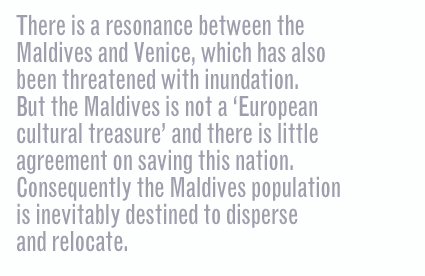 Eight artists presented their imaginary projects for the not too distant future; 2033. Performance director Nigel Jamieson, whose As the World Tipped—an impressive aerial show in Hyde Park for the 2012 Sydney Festival—was created in reaction to the Copenhagen Climate Change conference, presented an image in which future monsoons and floods in Asia result in hundreds of millions of boat people coming to Australia. Playwright Hannie Rayson took this idea further, talking about naval-like flotillas of people heading for Australia in 2033, resulting in our fighting a war to defend ourselves and ultimately losing. Australia, now Java Granda, is divided between African, Indian, Chinese and Indonesian territories, with the Republic of Australia holding on to Tasmania and a section of Victoria. Rayson proposed to create an exhibition, Birds of Passage, in the Melbourne Exhibition Centre, exploring bird and human migration [with 129 exhibits showing bird flights between the 129 nations of the Earth as trajectories for better cultural communication. Eds].
Eight artists presented their imaginary projects for the not too distant future; 2033. Performance director Nigel Jamieson, whose As the World Tipped—an impressive aerial show in Hyde Park for the 2012 Sydney Festival—was created in reaction to the Copenhagen Climate Change conference, presented an image in which future monsoons and floods in Asia result in hundreds of millions of boat people coming to Australia. Playwright Hannie Rayson took this idea further, talking about naval-like flotillas of people heading for Australia in 2033, resulting in our fighting a war to defend ourselves and ultimately losing. Australia, now Java Granda, is divided between African, Indian, Chinese and Indonesian territories, with the Republic of Australia holding on to Tasmania and a section of Victoria. Rayson proposed to create an exhibition, Birds of Passage, in the Melbourne Exhibition Centre, exploring bird and human migration [with 129 exhibits showing bird flights between the 129 nations of the Earth as trajectories for better cultural communication. Eds].
Not all of the artists outlined dystopian futures. Ross Ganf predicted that we will all join the Scouts and save the planet. An artist with a positive outlook was opera singer and producer Deborah Cheetham, a Yorta Yorta woman who believes that the visual and performing arts are the most powerful way by which we may know the world and give meaning to everything in it. She said that we should look at the situation through an Indigenous lens to create and dream and save the planet. This statement sparked some interesting conversations later about what it really means to see the world through an Indigenous lens.
The next part of the event was run as Open Space: a self-organising conference where participants write their own topics for group discussion. Open Space is guided by the “law of two feet.” People can choose to be bees (pollinators of ideas), giraffes (looking over shoulders of groups) or butterflies (looking beautiful and hanging out at the tea urn). Some sessions proposed by participants were: How do we deal with green wash? Why is dystopia sexier that utopia? How can artists work to reimagine the future? Should natural ecosystems have legal rights? How can we bring down the coal industry?
There were only three of us at the latter discussion, but by this time of the day it was exactly what I felt like talking about. Scientists have been quite clear in communicating the dangers of burning the huge coal reserves in places like the Galilee Basin in Queensland. Even if Australia does embrace sustainable energy practices for our own needs, if we continue to send vast amounts of coal to Asia we are dooming ourselves to a dangerously warming world.
Perhaps the fundamental question for TippingPoint was, can the visual and performing arts communicate the urgency of the situation to change people’s behaviour? As a visual artist I feel the medium is extremely powerful, and there are endless examples of effective political work. However the mainstream visual art world is mostly conservative and market driven. Exhibitions that explore climate change are either given bad reviews or ignored completely. The performing arts are often more radical. Recently I saw the performance Birds with Skymirrors by MAU dance company from New Zealand at Carriageworks, exploring the damage to island nations of the Pacific, especially Kiribati (RT115). It is an enigmatic work delving into dark ecologies.
This year the art collective Chamber of Public Secrets, co-curators of Manifesta 8, is curating the Maldives Pavilion in the Venice Biennale with an ecological focus. The title of the Pavilion is Portable Nation: Disappearance as work in progress—approaches to Ecological Romanticism. There is a resonance between the Maldives and Venice, which has also been threatened with inundation. But the Maldives is not a ‘European cultural treasure’ and there is little agreement on saving this nation. Consequently the Maldives population is inevitably destined to disperse and relocate.
Of course, it is desperate times already for those island nations. Do we wait for desperate times to directly affect our lives before we do something? And do we continue to kowtow to the prevailing postmodernist status quo that visual art shouldn’t take an activist stance?
The 2013 TippingPoint Forum, producer, facilitator and TippingPoint Australia Director Angharad Wynne-Jones; co-presented by TippingPoint Australia, Australian Performing Arts Centres Association and Theatre Network Victoria; supported by the Dara Foundation, The Canberra Theatre Centre and the Centenary of Canberra; Canberra Theatre Centre, 29 May
RealTime issue #116 Aug-Sept 2013 pg. 30
© Josephine Starrs; for permission to reproduce apply to realtime@realtimearts.net
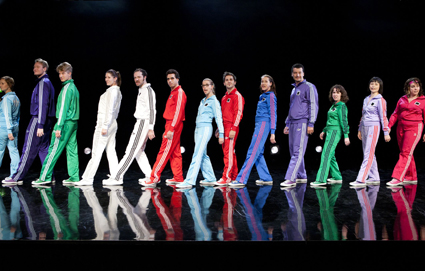
Nature Theater of Oklahoma, Life and Times 1-4
photo Anna Stocher/Burgtheater Wien
Nature Theater of Oklahoma, Life and Times 1-4
I spoke with Pavol Liska and Kelly Copper, the Artistic Directors of Nature Theater of Oklahoma, ahead of their Melbourne International Arts Festival season of Life and Times: Episodes 1-4. An epic 10-hour performance that narrates the life story of Kristin Worrall, one of the company members, Life and Times will eventually have 10 episodes with a combined running time of 24 hours.
The company’s earlier work No Dice, presented at the Sydney Festival in 2009, was an astonishingly inventive four-hour musing on storytelling constructed from recorded phone conversations.
Why try and cover the entire life of a person?
PL Remembering No Dice (see RT89), the question is ‘can you tell me a story?’ You know, any story. So that show became about the failure to tell a story, and then in the process of failing to tell a story, we told many different stories. And we wanted to do a story that is a life story: somebody’s—a person’s story. So I called Kristin and I didn’t expect that she would talk, ah, for so long. I expected that she would tell me her life story in maybe a couple of hours, but at the end of the first phone call she was at age eight, so I had to call again. At the end of the second phone call she was at age 14, etcetera etcetera until she was at age 34, I believe. And so, the attention that she took, and the gift that she gave us, we thought that it deserved an epic treatment. It felt like a goldmine, and it felt like—why keep looking further? Why keep trying to find another text for another show when we have this and we can just dig down in it and stay inside it. For a long time.
Do you treat each episode differently in terms of performance style?
PL Well, Episode 1 is an opera/musical, depending on where you are and what you feel, like, is more, more glorified. Episode 2, it’s an exploration of dance to me. And Episodes 3 and 4 are done in the shape of a murder mystery.
Why a murder mystery?
PL We go into rehearsal with a problem—how do we turn this material into theatre? What does this material really want? And we throw many different ideas at it, until one of them really sticks. Like, the genre of murder mystery felt the most appropriate to this age and the ideas that it expressed. There is lot of confessional, you know; you start to experience religious inklings, the world gets out of joint. And the genre of murder mystery is always about a world that’s out of joint, that it tries to put back together somehow. Our sincere hope is that people see beyond the genre, beyond the parody. We really work hard to get past it, even though we really also work hard to put the genre in the foreground. To orient the audience. You always have to turn the material and open it up. We do a barbeque between Episodes 1 and 2.
KC The actors cook.
PL And we serve dessert between Episodes 2 and 3. So it’s continuous, you know, we have not been slack. The actors get out of Episode 1 and then go straight to the grills and start grilling, and then everybody goes around the building and gets their hamburgers.
KC We do like to keep the audience close to it.
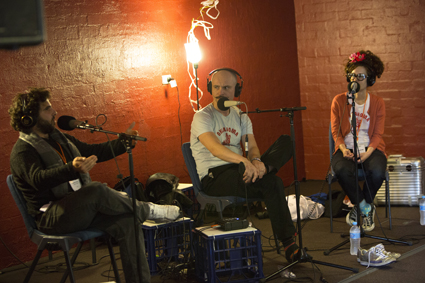
Nature Theatre of Oklahoma at the Australian Theatre Forum
photo Penny Bradfield
Nature Theatre of Oklahoma at the Australian Theatre Forum
PL I want to create more time with people. It’s a necessity. When people ask me “why is the show so long?,” I say, “It’s too short.” What is it, 10 hours with a human being? It’s not that long. And I want to keep extending it so that we get something out of it, we get to know each other, and we have some kind of, you know, revelation. Something unexpected happens. And it’s hard to make something unexpected happen when you just do a show, when I’m performing, when I’m being a dancing monkey for you. What generally happens is that after five or six hours of being together you stop seeing me as your dancing monkey. You have to take your own responsibility. Do you have endurance? Do you have it in you? Have you prepared for this? In my experience the audience prepares, and they know that it is going to be long and there’s nobody really saying, “Oh I’ll just check it out for the first hour and see what happens.”
Nature Theater of Oklahoma, Life and Times: Episodes 1-4, Arts Centre, Melbourne International Arts Festival, 23-26 October
See also Jane McKernan’s review of Rambo Solo (2010); and Keith Gallasch’s account of No Dice (2009)
RealTime issue #116 Aug-Sept 2013 pg. 27
© David Williams; for permission to reproduce apply to realtime@realtimearts.net
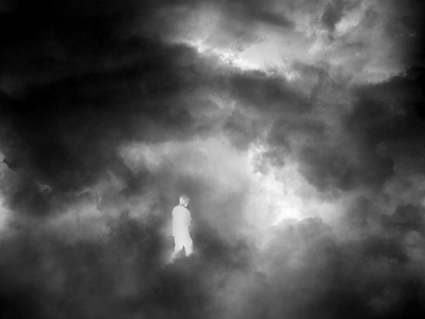
Kurt Hentschlager ZEE Beam In Thine Own Eye – Dark Mofo 2013, MONA
image courtesy the artist
Kurt Hentschlager ZEE Beam In Thine Own Eye – Dark Mofo 2013, MONA
Within a minute of entering Zee, I feel panic rising in me like a wave of nausea and, review or no review, I am out. It is unsurprising given the warnings at the entry, the attendant’s verbal description and the waiver I signed, but still, this artwork has triggered something in me I didn’t know existed.
The work—where the participant is immersed in a theatre-fog-filled environment dominated by strobe light—is by Kurt Hentschlager and is part of Beam in Thine Own Eye (BITOE), a curated exhibition for the Dark Mofo festival. Here, installations by 15 artists are selected to affect rather than for effect.
Originally biblical (Matthew 7:3), the show’s title is reinterpreted by David Walsh and his curators to evoke the real and flawed self, shining from within—the mind’s eye. My newfound fear—garden-variety claustrophobia or not—seems to be a resident within this internal reality.
Ivana Frank’s We Close Our Eyes and See a Flock of Birds draws me back to lengthy childhood hours exploring the space behind my eyes. Here, up to five people are admitted to a small cylindrical space. We sit facing the curved inner wall, its surface studded with LEDs. With eyes closed, the combinations of flashes across this wrapping grid offer up a continuous light show behind our lids. Colours change, patterns emerge and condense, clear imagery is elusive. I do not see birds, but others note glimpses. Each observation is slightly different.
Introducing this effect more gently, Anish Kapoor’s Imagined Monochrome is a calm treat. I book days ahead for my 20-minute massage ‘by’ this celebrity artist. Under his written instruction, a trained masseuse works my arms, neck and head while I lie with eyes closed in a white room under a bright light. Some minutes in, it is as though I shift into another visual space where bright colours flash, coloured orbs pulse. I am once again that childhood explorer, but unlike in Frank’s piece, here I have time to ponder what Kapoor describes as “the prisoner’s cinema.” At the end, eyes covered by the masseuse, I ‘see’ a field of blue and experience a sense of resolution as though this entire performative work were structured in order to allow me to access this unambiguous ‘other’ space.
Across Sullivan Cove, Sound to Light is a collection of collaborative outcomes installed and performed within the upper floors of the Salamanca Arts Centre. It has a decidedly underground feel when compared to its big cousin BITOE. The opening night is a crowded, slightly chaotic experience where it is easy to miss key performative moments while lost in the maze of exhibition rooms, but several works remained installed afterward. Composer Dylan Sheridan and artist Laura Hindmarsh’s Between Attraction and Monstration is a quiet, delicate piece best experienced alone. As I stand within a semicircle of tall, narrow, paper screens, light and film projection shift between moments of collaged film imagery and my own flickering shadow. I feel like a fragment of early, experimental film.
Equally enjoyed alone, The Geometry of Innocent Flesh on the Bone is a collaboration between artist Oscar Ferreiro and composer Heath Brown where robotic devices are strapped to sections of bone, mounted to the back of a plywood ‘animal.’ Surface mikes on the robotics feed sound back into the work composed by Brown. Deep, regular pulses within the composition, layered against the irregular, robotic squeaks of the devices, create the illusion that I share a lair with sleeping beasts.
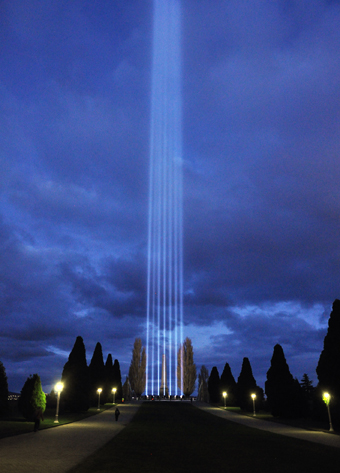
Ryoji Ikeda, spectra tasmania, photo Rémi Chauvin
image Courtesy MONA
Ryoji Ikeda, spectra tasmania, photo Rémi Chauvin
Breaking apart the closed space of other Dark Mofo works, Ryoji Ikeda’s spectra affects the entire Greater Hobart population. Located at the Cenotaph, the public artwork is formed from a grid of 49 powerful xenon searchlights directed to the heavens. From sunset the work builds in strength to the point where lights beam 15kms into the night sky and the distinctive ‘ping’ within the accompanying digital soundscape seeps into homes across the city. This is an undeniably sublime artwork from a distance, but best experienced up close. Rugged up against the wind and rain, hundreds of people stand in and around the work gazing skywards. I visit on the opening and subsequent nights and the shared reaction is one of quiet delight, as people explore this ephemeral cathedral. It is at its most magnificent in driving rain, when the texture of each raindrop is illuminated and night rainbows form along the column of light. Social media feeds repeat the plaintive “I will miss you spectra” in the days after its closing.
With plentiful night hours, winter is the perfect time for works like these. It is almost as though the dark cavern that is MONA has elastically stretched to encapsulate all of Hobart, such that we encounter art at every turn and works with light create shifts in our internal and external realities. While many works are affecting, I am certain the apocalyptic beam of spectra will be the visual and spatial memory that stays with us all as a collective index for this first Dark Mofo festival.
MONA, Events Tasmania, Hobart City Council: Dark Mofo, Hobart, 13-23 June
RealTime issue #116 Aug-Sept 2013 pg. 26
© Judith Abell; for permission to reproduce apply to realtime@realtimearts.net
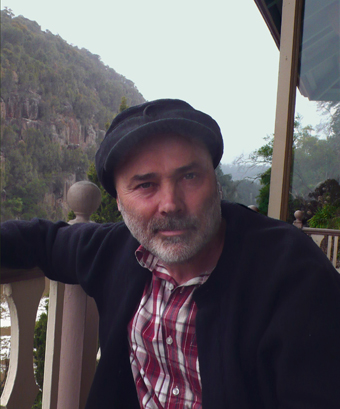
Bill Burns
photo Krys Verrall
Bill Burns
Seriously idiosyncratic Canadian artist Bill Burns is a featured guest of Launceston’s 2013 Junction Festival. His art has humour, bite and an intriguing diversity of means that focus on our relationships with nature, politics and the art market. His work has been shown at London’s ICA and New York’s MoMA and his nine books include Dogs and Boats and Airplanes told in the form of Ivan the Terrible (a photo-montage version of Eisenstein’s film featuring only dogs, boats and aeroplanes).
Although famed for being, as one writer put it, “a fabricator of small worlds that contain big ideas,” like his Safety Gear for Small Animals (1993-…) which comprises small hard hats, safety vests and respirators for all manner of beasts, Burns is creating a very large, live work for Junction.
Dogs and Boats and Airplanes Children’s Choir is a collaborative artwork performed by a 100-strong children’s choir sourced from four Launceston schools. The children, aged 8-12 years, will chorally mimic the sound of dogs, boats and aeroplanes in a libretto of their own making. Fifty other children will create the set, props and lighting for the live theatre performance which includes the making of pageant floats. I spoke with Bill Burns by phone not long after he’d visited his first school in Launceston.
You’ve produced this work before but the scale of it this time looks amazing. You’ll be marshalling many forces—a corralling of cats.
That’s true. In a lot of ways it’s a premiere because I’ve never done a live version. We’ve done some recorded versions with children in a studio but never with 100 children and never live.
Are you working on your own or do you have a team?
There’s quite a big team. First of all, it wouldn’t be possible without the support and expertise of the Junction Festival team. Then there’s a choral director, Amanda Hodder, from Tasmania—quite a well-known musician and choral director in this area. The artist Krys Verrall is travelling with me to work on the pageantry for the project, which takes place in between the choral movements. All of it is a very collaborative process with the children basically writing the libretto and developing the pageant.
I was working yesterday for the first time at one of the schools and it was pretty exciting. The kids are pretty pumped-up about it. The only thing to do now is to wrangle them into shape.
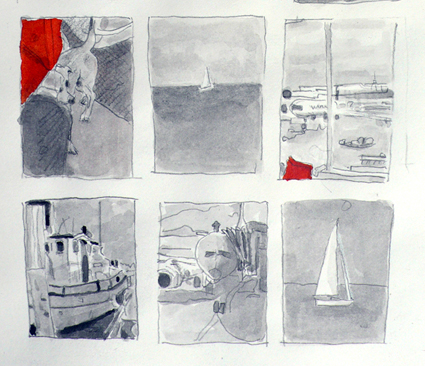
Dogs and Boats and Airplanes, Bill Burns
You’ve done works with children talking about birds and using mechanical bird sound devices (Bird Songs for Toronto, 2008), but why children making non-verbal simulations of the world around them?
I think that all of us can be artists, so I wanted to find a way that kids could be artists without having to go through all the hoops of acquiring certain kinds of technical expertise. And my work has a lot to do with expanding who can be creative in society. So for instance, I think all of us can be artists and that’s the way I would like my society to be—a place where everyone is an artist. But we have that drilled out of us.
Why specifically dogs, boats and aeroplanes?
I’m very interested in dogs and I feel like the connection between humans and dogs is really important to cultural history as well as natural history. So it’s this kind of relationship that borders quite nicely between nature and culture. And then, a lot of my works in the past have been about the tension between nature and advanced industrialism. So the idea of using the sounds of dogs and the sounds of boats and aeroplanes seemed like a way to bridge those tensions and look at them. And also being artists in the 21st century, we tend to travel a lot and I see a lot of boats and airplanes, but I also see a lot of dogs in different cities. So I’ve come to know dogs in Asia and South-America and the Caribbean and throughout Europe and the Americas. And I know that a dog in Paris and a dog in Seoul have different characteristics and they socialise differently. So you have this curious relationship between us and the dogs. And, of course, the dogs have this long history of working with humans as our worker dogs and protecting our sheep and so on. And those are very connected to human history. You know, dogs came out of Central Africa as well. So they come from the same place we do and we have a very long history with them.
I guess there’s a certain kind of sonic appeal for children in making a sound work.
Sometimes you forget the most obvious things and that’s one of them. It certainly appeals to the children. The boys gravitate towards the F18s sometimes but everyone is a pretty good howler and barker. Curiously, the boats tend to be more difficult. I think maybe they’re a little bit less known in our sonic culture.
There’s diversity in your art making, from watercolours to survival suits for small animals and your Guantanamo kit (Boiler Suits for Primates, 2009, a 1:5 scale model of everything that prisoners received when they arrived at Camp X-Ray in Guantanamo Bay, Cuba). How do you see them all fitting together?
Partly in that relationship between nature and the way things are going with advanced industrialism. A lot of my work has to do with that tension. One part of my work I’m looking at now is the relationship that artists have with the sort of industry of art. I think the Wall Street Journal recently was quoted as saying that art is becoming the fastest growing industry in the world. If you look at the auction results of the last four or five years it’s true; there’s nothing out there that has this kind of exponential growth. But, of course, the relationships are kind of strange and somewhat corrupted. I’m not to say they that anyone in particular is corrupt but there’s a kind of perverse relationship inherent in the fact that a contemporary artist like Peter Doig or Gerhardt Richter sells paintings at a higher price than Rembrandt—things like that. Not to say they’re not really interesting artists themselves, of course. But if you look at the stock market it’s not surprising that there would be a kind of a rush to this kind of possibility of inflated values for certain kinds of objects.
So a lot of my current body of work is looking at this kind of conspicuous consumption concept and the idea of what they call Veblen goods. Veblen was a Scandinavian economist at the turn of the 20th century who actually coined the term “conspicuous consumption.” The idea is that certain kinds of objects accrue value by virtue of their price tag. [It’s] a kind of reversal of Jeffersonian economics, the law of supply and demand. This is a case where the bigger the price tag the bigger the demand. You see that with fine wines, jewels, with watches, whiskey and with art. Those are the kind of curiosities I’m looking at. For me it’s a way of looking at the way we live in our society
You’re providing a counterpoint to excess by re-directing our attention as you’re doing in Dogs and Boats and Airplanes Children’s Choir?
Yes. At the same time I like to encourage younger artists because a lot of people are wont to say that art is a difficult field and there’s no money in it. And that’s far from true. While it is a difficult field, there’s a lot of money in it. It’s just that like everywhere else it’s concentrated.
Junction Arts Festival 2013, Bill Burns and Big Pond Small Fish, Dogs and Boats and Airplanes Children’s Choir, The Princess Theatre, Launceston, 6 September; http://junctionartsfestival.com.au; http://billburnsprojects.com/
RealTime issue #116 Aug-Sept 2013 pg. 29
© Keith Gallasch; for permission to reproduce apply to realtime@realtimearts.net
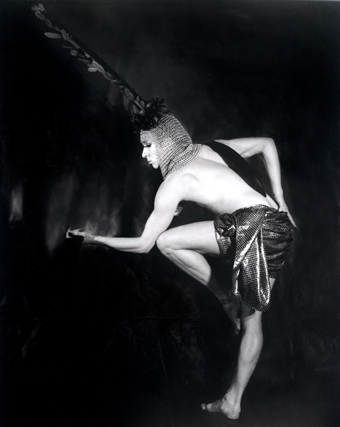
Francois Chaignauld
photo Odile Bernard Schröder
Francois Chaignauld
Despite some claims for a ‘palimpsest’ approach through a focus on dance history, I couldn’t really think of this year’s Montpellier Danse festival as a whole, but rather as a series of discrete works. That said, director Jean-Paul Montanari is a well-informed guide for his survey of a history that is honoured in Europe and the USA in a way that genealogies of Australian dance certainly are not. The staging of Maguy Marin’s classic, May B (1981) and a chronological trilogy from Trisha Brown spanning the years 1989-2011 showcased the ability of this festival to draw from the archive with panache.
Maguy Marin
May B is an important work linking French contemporary dance to the country’s mime tradition. Using clown-like facial and body prosthetics and with clay covering their skin and clothes, the characters in the piece are dusty remnants of a forgotten village. They move in rhythmic unison and follow one another’s behaviour, whether marching, dancing or barking garbled noises. This pattern is broken when two female characters spar, a birthday cake is shared and the group travel, leaving the stage from the front, climbing awkwardly down into the stalls and reappearing upstage. Selfishness is a key theme but also care and loneliness —a study in universals played by a very committed cast and with a compelling use of regimented chorus work.
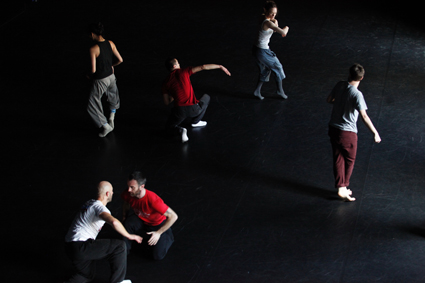
Corner Etudes, Emanuel Gat
Emanuel Gat
Emmanuel Gat, the choreographer-in-residence at this festival, provided the public with access to his choreographic process across a week as he devised the last part of a quartet of ‘etudes,’ Part 4: The Surprising Complexity of Simple Pleasures. This strategy follows his very Cagean interest in opening up composition to the contingencies of real life. (Gat has been writing about his choreographic approach on his website.) We joined him at the last rehearsal, but some members of the public had followed the whole week and the exercise appeared to be very successful in building a relationship with his audience.
The final work, Corner Etudes, builds on Brilliant Corners which I saw in 2011, continuing Gat’s interest in music as a compositional point of departure. The audience was invited onto the stage of the cavernous Theatre Berlioz in Montpellier’s Corum for the first three sections: a group, duet and quartet. Sitting around a square of light, the perspective and ambience was dazzling. The duet between Michael Löhr and Francois Przybylski included an original song performed by Przybylski and the quartet was a delicate study in collapsing spaces between bodies. For The Surprising Complexity… the upstage back wall was flown up in a grand gesture and a seating bank appeared facing out into the absent audience. In rehearsal we witnessed the atmosphere of egalitarianism as Gat does, as he states, ‘let the work happen.’
Mature artists (including Australian Genevieve Osborne) with diverse technical backgrounds, amazing facility and creative investment had each developed movements to a song of their choosing. In composing these voices into a single work, Gat shifts each of them between dancing and singing and layers material by bringing one song to the front and having the dancers adapt to this ‘score.’ He then adds a second song that gives them a choice of temporal structures to follow. He subsequently adds and subtracts dancers (where in other sections these choices seem to be ‘called’ by the dancers as they name someone and cluster to them), ending this section with Przybylski and Milena Twiehaus collapsing the space between two solos so that they are dancing on top of each other, with arms stretching through armpits and scraping slowly across necks. This final solo of the piece was quiet and mesmerising. The movement choices of the dancers are often intriguing and while the final composition has something in common with William Forsythe’s clustering of energy within groups and across space in an ebb and flow or breath-shaped pattern, this movement is of a more terrestrial order with everyday gestures included and bodies more firmly connected to gravity. The inter-relationships are also more intimate and gently confronting.
Trisha Brown
A single performance from the Trisha Brown Dance Company delivered a survey of works from across her mid- to late career when she began to choreograph with music: Astral Convertible (1989), If you couldn’t see me (1994), and I’m going to toss my arms—if you catch them they’re yours (2011). The remarkable thing about the 1989 piece is that it looks so like Cunningham with its Robert Rauschenberg set and John Cage score, its silver unitards with bizarre ‘fanny skirts’ on the girls differentiating the sexes, and some very shape-based movements. This reasserted a continuity in American modern dance for me that has been smoothed over by the intensely detailed analysis of that nation’s dance history which emphasises the important differences in what is fundamentally very similar.
The dancers were surprisingly young and had an attitude of calm non-fussiness, delivering movement material with minimum effort and an ample softness. The trademark little skips, lightning changes of direction, oddly awkward partnerings and leaps, and deceptively simple compositions of the group in space were all operating across the three works. Arms were kept to a minimum with an emphasis on the trunk of the body initiating movement and the limbs following on. Brown’s interest in the basic mechanics of the body and real effects of gravity and weight were in evidence as the simplest moves were performed with clarity and delicacy. It was a thrill to see Brown’s work live, especially as she is retiring from the head of the company due to failing health.
Cridacompany
This French company’s piece, Manana es Manana, begins with three men bent over a pile of potatoes, tossing them into the centre of the mound over and over with an amplified soundscape of the puttering noise produced. These simple means set the tone for a performance that shows what a body can do in simple, funny and awkwardly moving sequences. The only woman of the quartet is a thin, lanky, beautiful but morose character who attempts to do her hair and put on her shoes while the men shake her arms and legs to tragi-humorous effect. The three men then toss her around like a plank of wood in inventive and risky ways—dropping her and clapping before catching her, balancing her on their shoulders and turning themselves around while she stays where she is. A homemade video shows them in the Alps and one of them free-jumping off a mountain from a dizzying and alarming camera viewpoint. It’s hard to describe some sequences to give due credit. One performer juggles with hacky sacks while changing clothes, accompanied by a voice-over pronouncing how good he is. The humble somersault is worked into intricate weaving patterns and simple lugging becomes a hefty ‘ballet’ as the men move each other like sides of meat. It’s simple circus delivered with compositional simplicity and a lot of personality.
Francois Chaignaud
Dumy Moi was my last show in Montpellier and a cracker. I had heard about Chaignaud’s partnerships with Cecilia Bengolea including an expressionist dance modelled on early 20th century work and a duet performed with glass dildos in their bottoms. But nothing could have prepared me for this work. Chaignaud emerges from the dark as a massive shape: he is wearing what looks like a traditional Asian dancing outfit with a hoop of feathers attached at his waist and bare bottom showing, wings and chest plate of gauche sparkly decorations in plastic, a headpiece of feathers and shiny arm and leg plates. Made up like a Chinese opera performer and singing deeply like a Japanese Noh actor, he performs simple turns and promenades. This section ends with spinning and I wonder where he can go from here wearing that outfit. But the next section sees him extricate himself from it with style, singing in-between in a falsetto voice—this in itself is astounding. Combined with the series of outfits and immaculate dance moves his performance, experienced in the round and at close proximity, is a tour-de-force.
The next outfit comprises a hat of full-sized birds with a long plume of feathers curling around Chaignaud. A feathery jacket completes the transformation and he jumps delicately and high. This is the beginning of his most choreographic section with impressive held arabesques and deep second pliés, delicate running sequences and slow walks balancing on demi-pointe. Chaignaud adds to this outfit a five-foot wooden headress and continues with his dancing and singing in the most awkward postures. It felt like a salon performance for the rich and spoilt (he calls it a ‘recital’): a baroque treat and a must for the next Sydney Mardi Gras Festival.
Montpellier Danse 2013, Montpellier, France, 22 June-6 July
RealTime issue #116 Aug-Sept 2013 pg. 28
© Erin Brannigan; for permission to reproduce apply to realtime@realtimearts.net
Contemporary composers often attract the language of cartography, if not conflict, as they chart, navigate and territorialise a shifting landscape of styles. As part of the Latitude and Totally Huge New Music Festivals, The West Australian Symphony Orchestra’s Perspectives program (to be followed by the Frontiers program on Saturday), surveyed some of the less radical—though certainly current—trends in contemporary classical composition.
It is sometimes gratifying to hear composers pull back from the furthest reaches of musical invention because they return with the wisdom of their journeys into the unknown. In Close to the Edge, Roger Smalley paints a post-impressionist seaside landscape with pianissimo warbling clarinets, swelling orchestral textures and playful tutti rhythms. Washes of orchestral colour depict the horizontality of horizons, shorelines and stretches of flotsam in this study of timbral balance and development.
The Latitude concert afforded the rare opportunity to hear a master of classical minimalism reinterpret one of today’s most influential rock bands. Steve Reich’s Radio Rewrite is a ‘cover’ of Radiohead’s “Jigsaw Falling into Place” and “Everything in its Right Place.” Reich disassembles and reconstructs the harmonies and melodies of the songs into movements of fast, leaping woodwind melodies, slow, lyrical string vocalises and rushing, racing scales.
Twenty-one year-old composer Jared Yapp introduced the world première of his concerto for viola and orchestra, The Ecstatic. A red screen glowed below the aqua, silver and mauve art deco interior of the Astor Theatre. Violist Giovanni Pasini dug into the epic portamenti and guitaristic fingertapping of Yapp’s piece like a stadium rock god. The composer contrasts the rock-and-roll sublime with flatter, more ritualistic textures that turned Pasini from a god into a sacrifice.
David Sawers’ The Greatest Happiness Principle is based on the ideas of the utilitarian philosopher Jeremy Bentham, including his infamous “panopticon,” a prison design in which all the inmates could be surveyed without being able to tell whether or not they were being watched. After comical episodes of mechanical rhythmic displacements, call and response and creeping pizzicati, the orchestra breaks out of the conductor’s control, playing various instrumental effects such as double bass glissandi described by conductor Paul Daniel as “the worst stomach ache in the world.” If the orchestra’s timid toots and scrapings were their idea of the people’s revolt then Bentham may rest peacefully in his grave. It would be great to see WASO look further into the repertoire for “orchestra gone wild.”
With sonic variety and colourful instrumental exploration, the 5th of the International Computer Music Conference concerts prominently featured works for percussion and electronics. In Chatterbox, Oliver Bown [UK/AUS] and Miriama Young [UK] saturated the room with sound—from Raspberry Pis [credit-card-sized single board computers]—planted under the seating. Spatialised sine waves were juxtaposed with a wonderful, shimmering static layer. Chatterbox was imaginative, never losing itself to electronic music clichés.
In Giulio Colangelo’s THAUMA for two guitars and electronics, Vanessa Tomlinson and Louise Devenish drew their drum mallets and turned the hollow bodies of guitars into resonating sound blocks. Scraping and picking at the guitar surfaces, they brought out all the natural resonances of the instruments, which were amplified and thrown around Hackett Hall by Colangelo’s sophisticated electronics.
The first work utilising traditional percussion instruments was USA composer Dan Van Hassel’s Fzzl for snare drum and electronics. Van Hassel teased out the possibilities of the instrument’s seemingly simple body by electronically resonating the snare, delaying and spectrally morphing the band-like rhythms, shattering any presumptions the audiences had about the instrument.
American Seth Thorn’s Dahinterstehend for DrumKat explored percussion in the computer-generated realm. Vanessa Tomlinson hit a pad to created altered drum sounds that resonated out of Hackett Hall’s surrounding speakers. In an aleatory compositional method akin to those used by the New York school of Browne, Cage and Feldman, the timbre of the ‘drums’ changed according to how many times the pad was struck. Dahinterstehend had an interesting premise, which slightly missed out on being profound once the novelty of its system had run its course.
Red River, a work for bass drum, cymbal and electronics by Perth composer Sam Gilles, utilised the excessive sounds of the bass drum and cymbal to create electronic sound that resounded around the hall. While I feel that there could have been at times more adventurous writing, the spatialisation created a dark and rich sound world.
Using a cajon [percussion box] with electronics, Cort Lippe’s (USA) Duo seamlessly flowed between acoustic and electronic events. Charles Martin’s playing was vigorous, adding a wonderful sense of theatricality while drawing out every scrap of the instrument’s capabilities.
Inlovewithanothergirl.com, for snare drum and electronics, saw composer Rodrigo Constanzo scratching and scraping the skin of the drum with his fingers, producing exciting textures amplified through the surrounding speakers. While the ideas were interesting, a certain lack of control hampered the piece from reaching its full compositional potential.
The final piece of the night, US composer Jerod Sommerfeldt’s SamSara for vibraphone and electronics, created layers of sound by utilising the pure sounds of the vibraphone and spectrally manipulating them through the speakers. The layers created, however, often lacked subtlety, drawing attention to their generated nature and so diminishing the effects of a consistent sound world and structure.
Perhaps the most versatile concert in the ICMC series so far, this night of percussion and electronics saw a vast array of compositional strategies for some of the seemingly most basic instruments.
International Computer Music Conference & Totally Huge New Music Festival, Percussion and Live Electronics, Hackett Hall, West Australian Museum, 16 August
RealTime issue #117 Oct-Nov 2013 pg. 44
© John Barton; for permission to reproduce apply to realtime@realtimearts.net
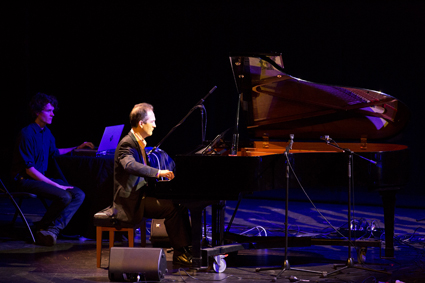
Michael Kieran Harvey, works for piano and electronics, THNMF13
photo Brad Serls
Michael Kieran Harvey, works for piano and electronics, THNMF13
In the International Computer Music Conference’s second concert’s works for piano with live electronics, pianist Michael Kieran Harvey attacked each work with inimitable energy and precision.
Takayuki Rai’s Discrete Transfer extends the piano beyond its usual gestures with live electronics, utilising a fragmented musical language that often resembles the piano works of Iannis Xenakis. Robert Seaback’s seed.signal. for piano and live electronics presents a Varèse-esque montage of sound objects both on the piano and via electronics, creating a brooding atmosphere with dark, rich chords interrupted by electrical ‘shocks.’
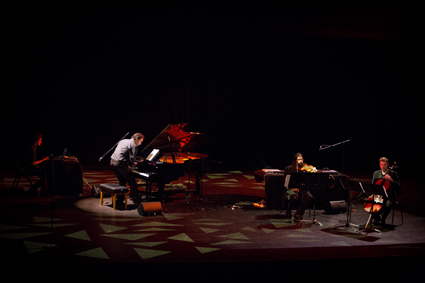
Stuart James, Aaron Wyatt, Tristen Parr performing Daniel Mayer’s Lokale Orbit/Trio 1 for violin, cello, piano and electronics, THNMF13
photo Brad Serls
Stuart James, Aaron Wyatt, Tristen Parr performing Daniel Mayer’s Lokale Orbit/Trio 1 for violin, cello, piano and electronics, THNMF13
Austrian-born Daniel Mayer’s Lokale Orbit/Trio 1 for violin, cello, piano and electronics changed the tone of the evening. Utilising hand-muted strings inside the piano, Mayer created a repeating pattern from which his entire piece was built. Using electronic reverberations from the string instruments, Mayer then generated an acousmatic soundscape, the sounds of the instruments becoming unrecognisable in their processed forms.
With reference to Helmut Lachenmann’s seminal composition Guero, Anthony Lyons’ Trace Elements I/II for piano and electronics began with the keys themselves as its point of departure. Electronically amplifying and reverberating the sound of Harvey’s hands running over the keys while he played a simple, yet fragmented, melodic line, Trace Elements I demonstrates that the piano is indeed a percussion instrument. Trace Elements II moved in a different direction, focussing on a simple harmonic triad and using microphones to resonate its partials through the theatre. After a very creative first movement, the second lacked the same creative drive, falling short on engagement and experimentation.
After the piano works, Julien-Robert Legault Salvail’s Fit into the crowd for bass clarinet and video took as its point of departure video and audio of a large crowd. As the clarinettist played behind the screen, the video faded so that she appeared to emerge from the crowd. Engaging in a debate with the chaotic voices of the crowd, the bass clarinet became a voice of expression, exposing the barrier between public and private and negotiating questions of individualisation in a world where the voice of the self can so easily become lost.
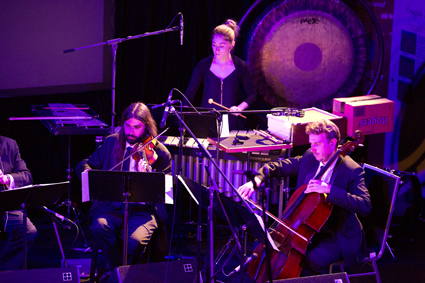
Decibel performing Alvin Curran’s Way Out Back
photo Brad Serls
Decibel performing Alvin Curran’s Way Out Back
Drawing attention to the relationships that constitute musical phenomena is crucial for Agostino Di Scipio, who opened the International Computer Music Conference with a critical discussion on the cybernetic relationships between musicians and technologies as shaped by the acoustic space.
In Di Scipio’s model of composition, the computer affects itself through the performer and the performer affects him/her self through the computer, transforming the acoustic soundscape. Di Scipio addresses these relationships in Condotte Pubbliche (Public Conduct/Conduits), an electroacoustic sound installation where the ambient sounds of visitors are filtered through two brass tubes fitted with two microphones and two earphones atop two loudspeakers feeding back the manipulated sounds via a laptop. This use of the acoustic space as an explicit object of the composition is reminiscent of Alvin Lucier’s 1969 composition I am Sitting in a Room .
Performed by Decibel, Di Scipio’s Texture/Residue (2006) for violin, cello, flute, bass clarinet and computer, explored the detritus of the classical repertoire by having the performers read Brahms without bowing or blowing to expose usually inaudible, rhythmic key taps and string scrapes. These sounds are fed back into the resonant spaces via computer processing, showcasing the underlying factors that bear heavily on any performance.
Alvin Curran’s keynote address was an eloquent call to arms for proponents of new music. Listing styles and influences like a beat poet he derided hackneyed occidental mentalities and business-as-usual compositional devices while recognising the difficulties for contemporary composers competing with the ubiquity of recorded musics of the past, a situation he admits the electronic artists of his generation helped to create.
Curran’s Way Out Back, commissioned and premiered by the Decibel ensemble, echoes the stylistic impasses of Western art music discussed in the composer’s address. The beginning of the work (a synchronised three-note, rhythmically displaced melody) sounds like an ironic take on minimalism. The rhythms fall apart then pick up again, climbing to a shrieking cacophony of murderous screams alongside piercing electronics and strings.
The Key Note: Works by Agostino di Scipio, Alvin Curran, Haco and Warren Burt, The West Australian Museum, 11 August
For Haco and Warren Burt’s performances see also Matthew Lorenzon’s account.
RealTime issue #117 Oct-Nov 2013 pg. 43
© Steve Paraskos; for permission to reproduce apply to realtime@realtimearts.net
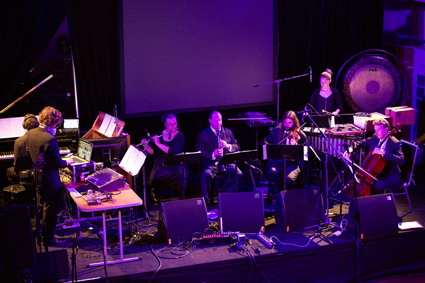
Decibel performing Alvin Curran, THNMF13
photo Brad Serls
Decibel performing Alvin Curran, THNMF13
The world première of Alvin Curran’s Way Out Back by the Decibel ensemble reflects the search for bridges between instrumental and electronic composition during the 2013 International Computer Music Conference.
A rhythmic phase on three notes gradually falls apart, making way for a backbeat on two cardboard boxes, leading into a variation on one note played by bowed vibraphone, overblown flute and scraped tam-tam. Comically exhausting these textures, the piece then moves into more electronic terrain, with various filters manipulating the live sound. Suddenly, the ensemble breaks out screaming, overbowing and generally worrying their instruments. Their protest is played back, filtered, over the speakers, before the ensemble plays a funereal chorale. The new work resonates with Curran’s keynote address that narrated, in the finest beat prose, the glorious and disastrous legacy of his generation. The old protest is the new convention, including screaming; advances in music technology have spawned a music industry that perpetuates a canon and homogenises tastes.
Texture/Residue continues Agostino di Scipio’s exploration of dynamic relationships between computers, performers and their acoustic environments. In a paradigm of composition Di Scipio calls “Audible Ecosystemics,” sound from the performer or from the performance space itself alters the way a computer modifies live or synthesised sound. The process becomes recursive as the computer’s output is diffused back into the space or modifies what the performer plays. The process is both an instantiation and a criticism of technological determinism, encouraging a practical knowledge of the agencies of the different components of a hybrid performance.
Incorporating the room into the ensemble of flute, clarinet, viola and cello, the work contributes to the chamber music tradition. There is also something of the chamber work in the compact form of the piece. The ensemble plays a series of short bursts without producing tones. The instruments’ fingerboards and keys control high, echoing, granular sounds that become ever more like the original instrumental clacks and rattles as the players apply breath and bows.
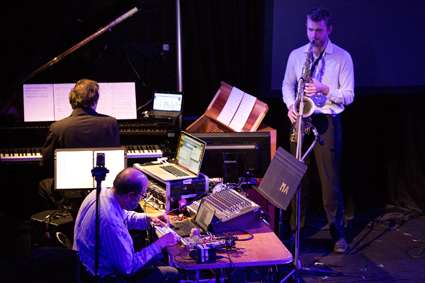
Warren Burt, Without Glue, THNMF13
photo Brad Serls
Warren Burt, Without Glue, THNMF13
In Without Glue, Warren Burt tests the improvisatory skills of pianist Stuart Little and saxophonist Sean Little by sending them harmonic and gestural directions via laptops on their music stands. The resulting smooth jazz is fairly conventional, except for the filters, reverberation and glitches introduced by Burt. Improvising on the instrumentalists’ improvisations, Burt demonstrated a different sort of virtuosity, accentuating the saxophone’s changing register with ‘squelching’ delay effects and ornamenting their mellow tones with bursts of sound like science-fiction laser beams.
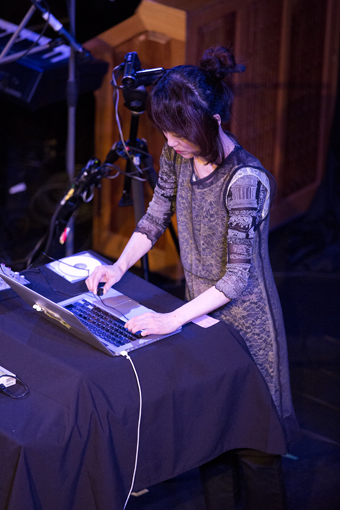
Haco performing StereoBugScope, THNMF13
photo Brad Serls
Haco performing StereoBugScope, THNMF13
In StereoBugScope, Haco listens to the complex and changing magnetic field of her laptop with a pair of small microphones. The crackling, humming interference varies from task to task, beginning with an explosion of oscillations of different frequencies when the laptop is turned on. Haco separates each activity with a refrain: the gentle hum of the hard drive and two different tones produced by the logic board. Some activities produce the expected sounds: a DVD whirrs, a track pad clicks (sort of). Other sounds are more surprising: the deep throb near the monitor or the high whistle of the ‘sleeping’ computer. The intended effect is a new appreciation of—possibly even sentimental attachment to—the technology around us. I will certainly never again turn on my laptop without imagining the spaceship-like storm of magnetic activity emanating from it.
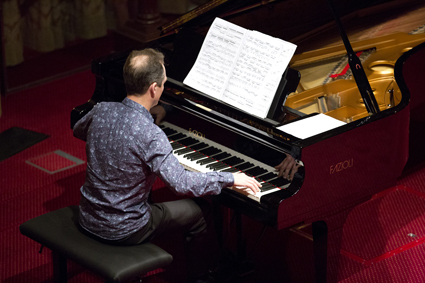
Michael Kieran Harvey, THNMF2013
photo Brad Serls
Michael Kieran Harvey, THNMF2013
The musical grotesque can sometimes struggle to find an audience. As the success of contemporary music in film has shown, overblown gestures, dissonance, difficult timbres, the very soft and the very loud can find sympathetic ears when presented alongside other arts. Two new works performed by Michael Kieran Harvey at Perth’s Government House Ballroom show the expressive potential of contemporary compositional techniques through programmatic alliance with literature and painting.
In the centre of Harvey’s own Psychosonata is a traditional sonata form with classically ‘pianistic’ lyrical flights and arpeggios representing the orderly, supposedly ‘healthy’ mind. This structure is obscured beneath a texture of fast and dissonant runs; thundering chords and stubborn, persistent lines built out of an obsessively recalculated nine-value series representing the supposedly ‘psychotic’ mind. In composing this musical palimpsest, Harvey drew inspiration from the paintings of Frank Auerbach, where extreme psychological states are represented by complex agglomerations of paint over otherwise traditional portraits. I like to think that Harvey’s resultant musical surface shows thought not so much as order and disorder, but as variations in density. As both Harvey and Elliott Gyger show at the end of their works, a dissonant chord can connote ‘orderliness’ if played slowly and softly across several octaves.
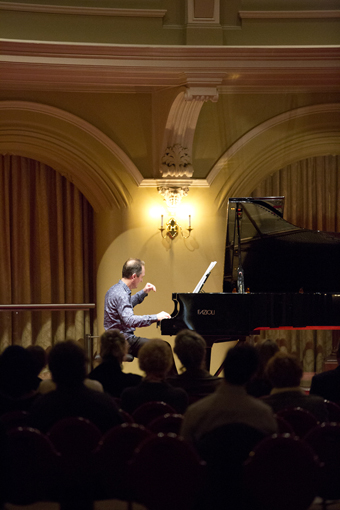
Michael Kieran Harvey, THNMF2013
photo Brad Serls
Michael Kieran Harvey, THNMF2013
Elliott Gyger’s hour-long INFERNO for solo piano (after Dante) is composed in, as Harvey puts it, an “unfashionably uncompromising” language. While such music can also express positive affects (including the sparse beauty of INFERNO’s final movement “Stars”), Gyger shows how the techniques of Messiaen, Carter, Ligeti, Birtwistle and other post-war avant-garde composers are particularly well suited to depicting the nine circles of hell with their tortured bodies and rivers of water, boiling blood and ice.
In the Prelude, Gyger transcribes the nine lines of the inscription above the gates of hell into dense chords rapidly alternating with rolled clusters. The two gestures also conjure images of the wasps and maggots chasing those who committed neither good nor bad deeds in hell’s “vestibule.”
The river of water crossed by the ferryman Charon is depicted by descending passages in racing, machinic rhythms. Rather than the common ‘water’ effect of undulating, pointillist glistening, the regularity of Gyger’s gestures creates a sound like a pixelated image or a monophonic, 8-bit sound effect from an early-1990s computer game. This effect is punctuated by tones ‘dropped’ into the stream, unleashing a similarly pixelated ‘splash’ of notes.
The lustful, blown about by the winds in hell as they were by their passions in life, are depicted in a flurry of sensual modal devices. Whole-tone harmonies, snatches of pentatonic melodies, open fifths and soft, smoky chords twist around and past each other over the keyboard.
As the wrathful fight each other on the surface and the slothful sulk deep in the river Styx, a languid bass ostinato contrasts with wet, slapping chords.
The river of boiling blood is depicted by the same material as the river of water, but this time furiously frothing and bubbling across the whole range of the piano.
Less iconic scenes—such as the first circle of hell where virtuous non-Christians live in an imperfect heaven—are harder to decipher. The “ten trenches of fraud” is used as an opportunity to reprise material from the rest of the cycle in a series of variations.
All of the punishments in Dante’s Inferno have a poetic justice about them, such as the avaricious or miserly who must duel by pushing enormous weights against each other. As a non-signifying art form, can music express the poetic justice of Dante’s punishments? Perhaps only in the sheer difficulty of playing the piece itself.

Michael Kieran Harvey, THNMF2013
photo Brad Serls
Michael Kieran Harvey, THNMF2013
Perth’s Government House Ballroom blazed with intensity as Michael Kieran Harvey performed a solo recital for the Totally Huge New Music Festival. Performing his own work for solo piano, Psychosonata (2012), and Melbourne-based composer Elliott Gyger’s Inferno (2013), an epic musical examination of Dante’s classic work, Harvey showed why he is one of the country’s leading contemporary classical pianists.
Psychosonata is a work that by the composer’s own admission has “no narrative.” However, while the piece may be devoid of melodic consistency, it is anything but devoid of colour and rhythmic flamboyance. Moving seamlessly between the three piano pedals, Harvey utilizes every tiny part of the piano’s timbre. With audible influences ranging from jazz to Elliot Carter, Harvey has created an engaging and interesting work that is demanding not only on the performer’s technical abilities, but also on the listener as the piece never holds a singular line of thought for long.
Psychosonata negotiates the depiction of a madman. However, what is most compelling is how much beauty emerges from this unpredictability. It is a beauty that perhaps reflects the madman in all of us who create meaning where none may actually exist.
Guided by Dante’s epic poem, Elliott Gyger’s Inferno depicts Hell in nine etudes, the scenes conjured by Harvey’s transcendental virtuosity. Gyger writes that the work is influenced by Romantic composer Franz Liszt; it is easy to associate it with that composer’s Années de Pèlerinage in terms of Inferno’s thematic movement and demands on pianistic skill.
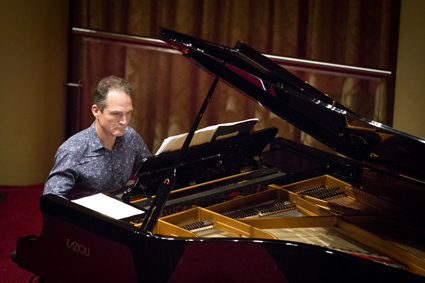
Michael Kieran Harvey, THNMF2013
photo Brad Serls
Michael Kieran Harvey, THNMF2013
What is drastically different from Liszt however is the harmonic and rhythmic world that Gyger creates. Building on harmonic sonorities and then disassembling them with splintering dissonance, Inferno teases out the darkest colours of the piano at the extremes of its pitch ranges, relentlessly casting the listener into the dark and alien world of Hell. This hour long tour de force is a journey into an inescapable world of torment, which somehow remains coherent. Unlike Liszt, who tempered his fits of passion with the music of beautiful meadows and flowing mountain streams, Gyger flings us into the depths of Hell, from bursting flames into its most decrepit recesses.
Michael Kieran Harvey is nothing short of a national treasure, who should be recognized for not only his technical prowess but also for his humble support of new Australian works. This concert was no easy Sunday afternoon waltz, but it rewarded those willing to make the effort with a profound musical journey.
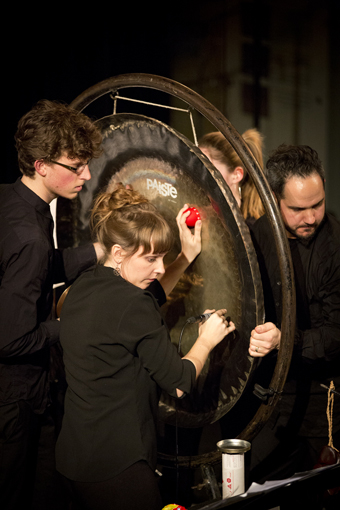
Mickrophonie I, Transducer, Speak Percussion, THNMF2013
photo Brad Serls
Mickrophonie I, Transducer, Speak Percussion, THNMF2013
Featuring the world premiere of Robin Fox and Eugene Ughetti’s Transducer in conjunction with Karlheinz Stockhausen’s seminal work, Mikrophonie I, the West Australian Museum’s Hackett Hall was transformed into an enclave of fantastical sound worlds that shook up even the most stubborn ears.
Transducer is a work almost entirely devoid of instruments in the traditional sense. Sticks, ping-pong balls and coins are used to instigate acoustic events for which microphones act as receptors. These events are then spatialised and manipulated around the hall through eight speakers, projecting sounds almost alien from their original source. The spectacular players of Speak Percussion perform the work with great dedication, as their bodies become integrated into the piece, with microphones picking up their movements and transmitting them into the electronic sound world.
With direct references to Reich and Cage, Transducer is a work more about playing within the electrical sound space than precise reproduction. Hisses and spits of feedback comprise the core soundscape, which is manipulated with expertise by Robin Fox, creating dynamic sound events. The piece evokes moments of harmonic beauty, especially when sine wave tones are emitted from different speakers that are “played” as microphones are randomly swung over them. At other moments, all turns to cacophony, and one is transported into huge sound worlds of electric currents crashing against one another, disrupting and dispersing in a display of uncontrollable power.
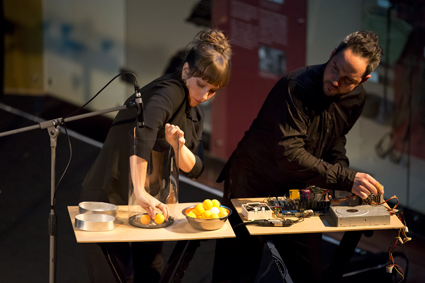
Leah Scholes, Eugene Ughetti, Transducer, Speak Percussion, THNMF2013
photo Brad Serls
Leah Scholes, Eugene Ughetti, Transducer, Speak Percussion, THNMF2013
While Transducer manages to create moments of wonderment in tensions between pure and static sound environments, it is not without its weaknesses. The performance is often reduced to novelty, as performers seem to move from one idea to another with seemingly little relation to each other. While improvisation is integral to a work like this, it can also diminish the overall effect. Nonetheless, this was a bold and powerful work.
An early work in his oeuvre, Karlheinz Stockhausen’s Mikrophonie I (1964), is for tam-tam with four players scratching and scraping its surface. These sounds are then picked up by handheld microphones and beamed out through speakers situated around the ghostly expanse of Hackett Hall. The players “speak”, either with their voices or with various shapes of cups, tubes and even children’s toys, into the tam-tam. Communicating with each other, sometimes in harmony, at other times in conflict, the players negotiate the tam-tam’s metallic surface like explorers of an alien planet.
The performance by Speak Percussion was profound, as they communicated with each other with soul-bearing intimacy through the surface of the tam-tam. In a work that requires communal agreement not only in performance, but also in deciding the order in which the piece is played (the score allows for multiple approaches), Speak Percussion showed their ability to perform not only as phenomenal soloists but as a group that is able to negotiate complex sound worlds.
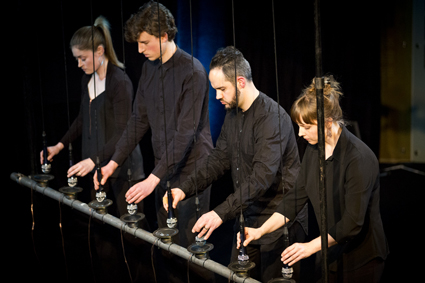
Transducer, Speak Perecussion, THNMF2013
photo Brad Serls
Transducer, Speak Perecussion, THNMF2013
Tucked away in a wing of the Western Australian Museum, Hackett Hall is a little-known architectural relic. Tiers of empty bookshelves rise up to a painted vault, remnants of almost 70 years of service as part of the State Library. Ornate stone- and metalwork hangs over a vacant interior. Buildings, like musical compositions, can fall silent for centuries, only to return to noisy life under very different circumstances.
One hundred years after the hall’s completion, Speak Percussion, Robin Fox and Byron Scullin bridge the present and the past by juxtaposing the new microphone-based work Transducer with Stockhausen’s Mikrophonie I from almost 50 years ago.
While Mikrophonie I turns the microphone towards a tam-tam (more commonly known as a “gong”), examining its normally inaudible sonic properties “as a doctor ausculates a patient,” Transducer turns the microphone on itself, exploring its materiality and developing ingenious ways of manipulating feedback.
Both pieces demand precise choreography from the microphone-wielding performers. In Mikrophonie I the four performers adoringly stroke and massage the tam-tam. In Transducer the instruments manipulate the performers as their movements are dictated by the physics of oscillation in sound, electricity and the swinging of the pendulum.
At the beginning of Transducer Eugene Ughetti walks onstage and picks up a speaker tied to a common cardioid microphone, a device certain to release a squeal of ear-splitting feedback as the sound received from the microphone is played back to the microphone through the speaker. Swinging the device around his head, Ughetti lengthens the cables until the microphone-speaker describes a circle almost as wide as the stage. Four microphones at the corners of the stage are diffused through eight speakers, placing the audience in the center of a roaring, spinning, pealing vortex.

Mickrophonie I, Transducer, Speak Percussion, THNMF2013
photo Brad Serls
Mickrophonie I, Transducer, Speak Percussion, THNMF2013
The piece progresses through the steady addition, transformation and subtraction of sound sources, giving the performance the air of a geometrical demonstration. Matthias Schack-Arnott, Louise Devenish and Leah Scholes enter and hold up naked speaker cones to Ughetti’s circle, modifying a rhythm of feedback by fanning around the perimeter.
At other times, the four players surround a tall frame of eight microphones hanging above eight speaker cones. The microphones are swung above the speakers, creating phasing rhythms that shift in timbre from ‘whooshing’ sounds to hollow, flute-like tones, their pitch descending as the pendulums slow. The performers must move forward and backwards as they adjust the swing of the pendulums or stop them still over the speakers.
At other times the performers explore the sonic possibilities of the materials comprising the feedback loop. Scholes grabs and shakes the pendulum-microphones tied in a bunch, Schack-Arnott scratches a board fitted with contact microphones, Devenish places small objects in vibrating speaker cones and Ughetti menaces a condenser microphone with a knitting needle, then with a cardioid microphone, grating their mesh housings together. At times the performers explore the magnetic field of a piece of dismantled electronic equipment with two small microphones, producing a range of sounds from mid-range buzzing to slow clicks. When using this instrument, the performers’ gestures are not always met with a change in sound, a possible danger when exploring the limits of electromagnetic interference. This had the fortunate effect of showing the truly experimental nature of the performance, as all experiments must have conditions under which their hypotheses may be proven false. If some gestures are to have truly astonishing effects, others must not.
Perhaps the most remarkable effect is saved until last. Ughetti, in a gesture towards Mikrophonie I, stalks a lone tam-tam with a directional microphone. As he advances, a shimmering peal of feedback fills the room. The tam-tam acts as a filter between a speaker and the microphone, creating a dynamic field of overtones across its surface that are altered as they are explored. As Ughetti moves the microphone towards the tam-tam’s perimeter the rich sound resolves into melodic tones, seemingly singing a minor-mode melody embellished with constantly shifting harmonies that rise up and echo about the empty storeys of the hall.
–
Totally Huge New Music Festival, Transducer, Speak Percussion with Robin Fox, Hackett Hall, The West Australian Museum, Perth, 10 Aug
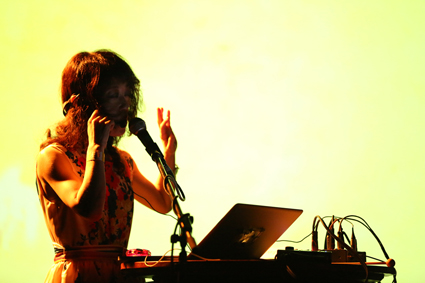
Haco, THNMF2013 Opener
photo Brad Serls
Haco, THNMF2013 Opener
The Tura Totally Huge New Music Festival kicked off with a culturally diverse concert that showcased artists from the United States, Japan and Australia. If this range of artistic diversity is Tura’s intention throughout the festival, then I am definitely excited.
The festival opening was hosted at The Bakery, Northbridge, a venue that somehow escapes the razzle and dazzle of the city nightlife, while remaining in its heart. This sentiment is also analogous to the artistic objects on offer on the opening night that never fit into an easily accessible mold, and always challenges the listener open up new directions of listening and thinking.
The show opened with Perth-based Ourobonic Plauge, a latecomer to the lineup after the withdrawal of Speak Percussion, who did exceptionally well at filling a very large void. His electronic set, with some very subtly added vocals, produced a dark sound world that managed to avoid clichés; a great achievement when layering tracks.
Haco, a Japanese singer, songwriter, and sound-artist, performed next with songs from her album “Forever and Ever”. Often more of a poetic experience backed by sound than “songs” in the traditional sense, Haco produces moments of pure vocal beauty that are infected by electronic static that hiss and crackle underneath. Haco’s performance was engaging; with ease of vocal control and an onstage presence that drew the audience into her ebbing and flowing sound world, she maintained an engrossing tension between consonance and dissonance. I found Haco’s music deeply touching, leaving me totally spellbound by its ominous beauty that was simultaneously afflicted by a persistent, yet subtle, anxiety. “Forever and Ever” is an engrossing work, which was performed with wonderful authenticity and character.
The final act of the night was San Francisco electronic duo Barn Owl. As the drones emerged from the Bakery sound system, a hush came over the crowd, as we were ushered into the Barn Owl church of sound. Using the low drone as a point of origin, the duo created a detailed sound world that moved organically through synthetic soundscapes that rumbled and pulsated through the venue. Melodies hovered over the low bass-lines with total ease, and succinctly spaced percussion allowed the music to flow onward, without ever becoming monotonous to the ears. Using the entire spectrum of sound with masterly expertise, Barn Owl took us on a journey through unchartered electronic soundscapes that were a pleasure to listen to. While perhaps not as challenging as Haco’s work, Barn Owl offered a supremely coherent musical experience that often bordered on the sublime.
With a diverse range of acts to follow throughout the festival, from purely electronic works to acoustic adventures, the festival covers a wide array of music. The opening concert displayed this eclectic yet accessible mix with a range of musical artists who challenged expectations of what it means to make music and the associated issues of identity that accompany such explorations. It is through these artists that creativity continues to press on, challenges expectations and stereotypes, and most importantly, makes the world alive.

Haco, THNMF2013 Opener
photo Brad Serls
Haco, THNMF2013 Opener
With walls of bright-red shipping containers, The Bakery looms out of the Perth car park like a post-apocalyptic fortress. Once inside, a crowd mills around under strings of lights covered by colourful strainers and baskets. Metal fans, indie rockers, classical music aficionados and computer musicians rub shoulders on astroturf-covered benches and twisted tree stumps. The eclectic audience reflects the variety of styles programmed in this year’s Totally Huge New Music Festival, which is presented in collaboration with the first International Computer Music Conference in the southern hemisphere. For opening night electronic artists from Australia, Japan and the United States converged to present three different takes on contemporary electronic music.
With a lo-fi bass kick, Perth-based solo artist Ourobonic Plague plunged the audience into a forbidding industrial landscape. The flat timbres of Ourobonic’s synthesisers and beats move the focus of electronic performance from signal processing to a “concertistic” manipulation of musical convention. Moments of sparse techno build to a fuller dubstep sound before paring back to grainy ambient atmospheres.
Whereas Ourobonic Plague draws on a stylistic encyclopedia to hold his charged musical scenes together, Japanese sound artist, singer and improviser Haco threads together electronic and sampled textures with her voice. Playing from the recent album Forever and Ever, Haco sings over vibraphone arpeggios, string sections, guitars and cross-rhythm brass. The regularity of the instrumentation is offset by Haco’s declamatory, meandering phrases that halt, start, skip and jump before returning again to familiar refrains. The organic textures of Forever and Ever were contrasted with “The Room of Hair Mobile” by Haco’s previous incarnation After Dinner. In this remarkable composition a sparse, at times a cappella vocal texture is superimposed over a procession of different samples from bird song, through flutes, static and a full-blown band arrangement to the sound of a squeaky gate.
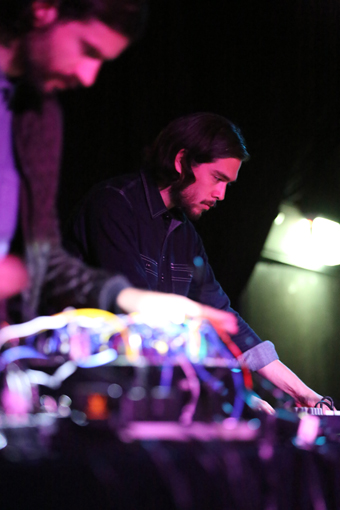
Barn Owl, THNMF2013 Opener
photo Brad Serls
Barn Owl, THNMF2013 Opener
Unlike Haco’s melodic neclaces, Barn Owl was an object lesson in textural economy. The San Francisco-based duo created an intensely evocative series of variations using a palette of undulating static, gritty bass drones, etherial synths and sampled skin-drum percussion. When it did appear, melody was used to ecstatic effect. After twenty minutes of grey sonic landscapes, a synth rose above its usual register with a leading-tone-to-tonic motion, pulling the audience with it. A slight dynamic swell at this point marked a moment of light in the otherwise grim desert-rock sound.
It is fitting for a festival dedicated to drawing together physically dispersed and stylistically diverse musical cultures that the opening night should be about different ways of making a set hang together. As Ourobonic Plague, Haco and Barn Owl seem to suggest, the possibilities are endless.
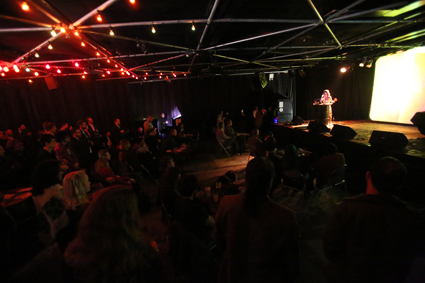
Haco, THNMF2013 Opener
photo Brad Serls
Haco, THNMF2013 Opener
If you couldn’t tell from the sound of the crowd, the tables and chairs in front of the stage were a very good indication there was to be no horseplay at The Bakery on this drizzly Friday night. These individuals had other needs to attend to as they slowly filled out the venue in Perth best suited to the opening of Tura New Music’s eleventh Totally Huge New Music Festival.
From the first muffled sub pulses under swathes of low pass filter sweeps and fuzzy feedback fluttering we were altered by sonic morphine. Ourobonic Plague launched long form trips of heavy textures modulated to the sweet spot of distortion on what used to be syncopated high-hats, coupled with an insistent, subsuming sub-kick. The set organically pieced itself together with chromatic synths like pneumatic drills in sheet metal, tight snares, stutters and bass warbles. This was an expertly-prepared set with a few tactful ancillary interventions by the performer.
In a distinct break from the previous set, Haco greets the crowd with reverberating vibraphone tones that ring out and sit with you. Reverse-delayed synth strings shift and fall backwards as Haco hypnotises us with serene incantations that repeatedly fade away. She is like glass, creaking glass, crackling bright particles of glass over sustained sinusoidal feedback. Ringing bells and singing bowls ping, ting and ding as the bass inconspicuously yawns. Haco lulls us with these ebb tides for some time before building to a climax, finally bridging the sonic spectrum with crushed kicks and slap-back snares. This is the future the nineties promised.
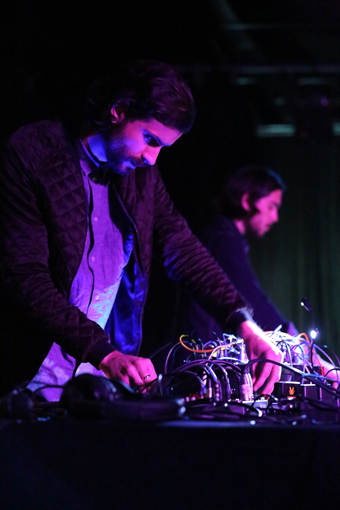
Barn Owl, THNMF2013 Opener
photo Brad Serls
Barn Owl, THNMF2013 Opener
Then came the modular-synthesiser styling of Barn Owl. Celestial sub-drones imperceptibly grow with wave after wave of tidal white noise as doppler-like static accompanies throbbing feedback. Heavy on the one, they pluck air raid sirens and jungle marimbas from the ether and let the set ride to the end of the night. Barn Owl’s set epitomised the professionalism that this festival showcases. Astonishingly, there was no instrument devised and forged by Hephaestus that would account for their holy sonorous object and this fact only adds to the mystery of Barn Owl’s set.
The sound technician and The Bakery’s sound system deserve special mention. Facing the stage you are totally engrossed in and enveloped by sound, but turn to a friend for commentary and all is audible. This phenomenon still confounds me.
The artists at this Festival Opener have raised the expectations for the next eight days. One cannot help but be excited by what remains to come.

































































 Academics in the humanities and the social sciences like to write about popular culture. They like to use ‘high’ theory, the accredited and validated discourse of the academy, to do so.
Academics in the humanities and the social sciences like to write about popular culture. They like to use ‘high’ theory, the accredited and validated discourse of the academy, to do so.



















 Eight artists presented their imaginary projects for the not too distant future; 2033. Performance director Nigel Jamieson, whose As the World Tipped—an impressive aerial show in Hyde Park for the 2012 Sydney Festival—was created in reaction to the Copenhagen Climate Change conference, presented an image in which future monsoons and floods in Asia result in hundreds of millions of boat people coming to Australia. Playwright Hannie Rayson took this idea further, talking about naval-like flotillas of people heading for Australia in 2033, resulting in our fighting a war to defend ourselves and ultimately losing. Australia, now Java Granda, is divided between African, Indian, Chinese and Indonesian territories, with the Republic of Australia holding on to Tasmania and a section of Victoria. Rayson proposed to create an exhibition, Birds of Passage, in the Melbourne Exhibition Centre, exploring bird and human migration [with 129 exhibits showing bird flights between the 129 nations of the Earth as trajectories for better cultural communication. Eds].
Eight artists presented their imaginary projects for the not too distant future; 2033. Performance director Nigel Jamieson, whose As the World Tipped—an impressive aerial show in Hyde Park for the 2012 Sydney Festival—was created in reaction to the Copenhagen Climate Change conference, presented an image in which future monsoons and floods in Asia result in hundreds of millions of boat people coming to Australia. Playwright Hannie Rayson took this idea further, talking about naval-like flotillas of people heading for Australia in 2033, resulting in our fighting a war to defend ourselves and ultimately losing. Australia, now Java Granda, is divided between African, Indian, Chinese and Indonesian territories, with the Republic of Australia holding on to Tasmania and a section of Victoria. Rayson proposed to create an exhibition, Birds of Passage, in the Melbourne Exhibition Centre, exploring bird and human migration [with 129 exhibits showing bird flights between the 129 nations of the Earth as trajectories for better cultural communication. Eds].
























